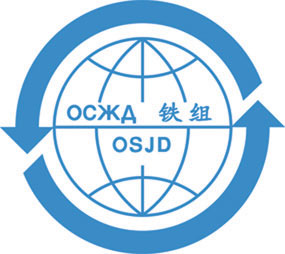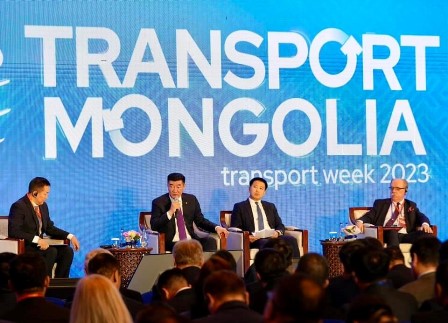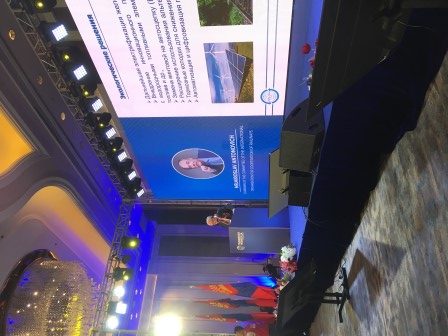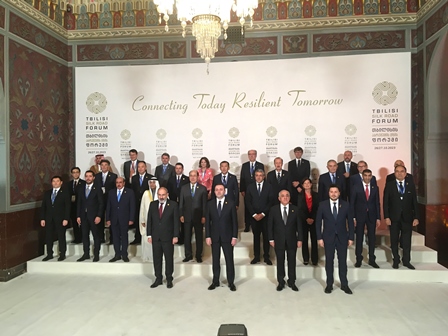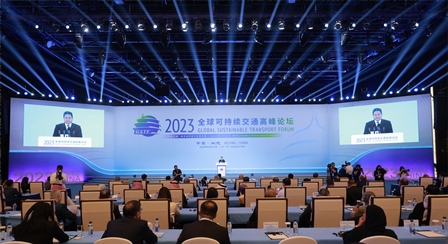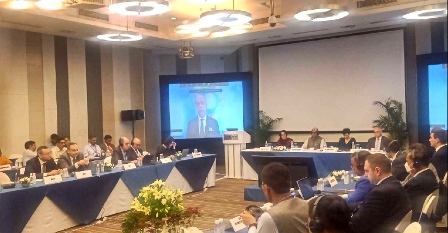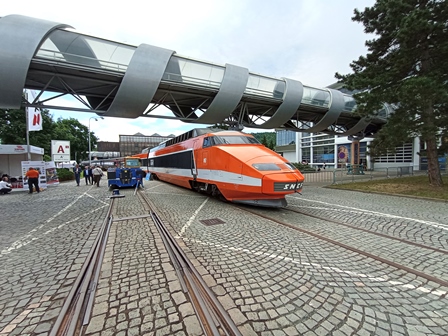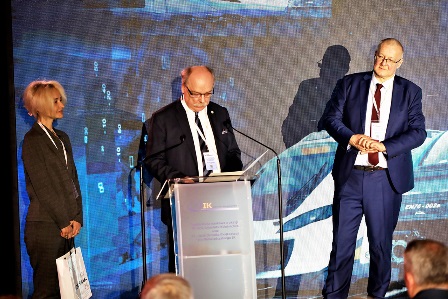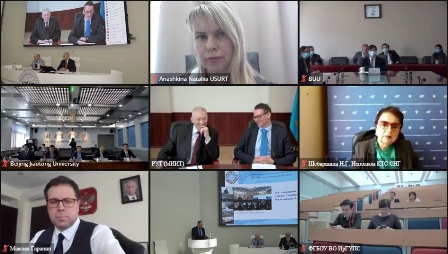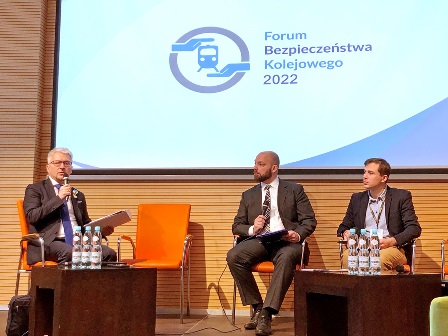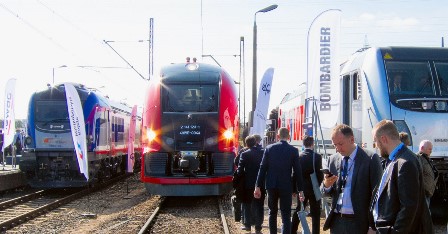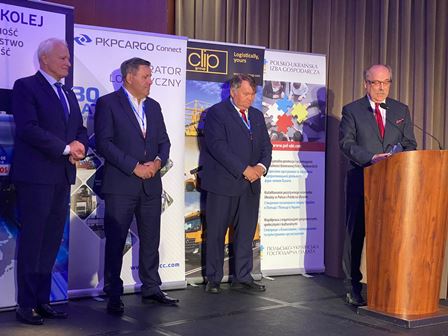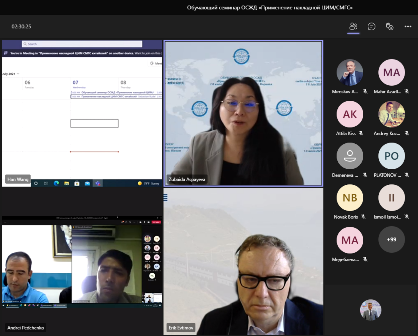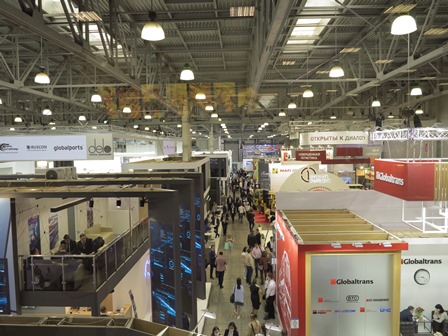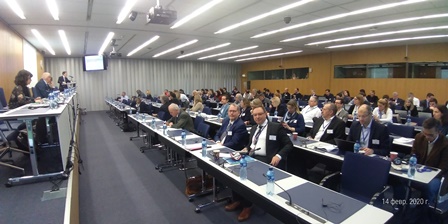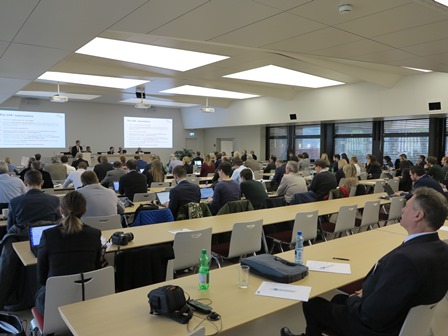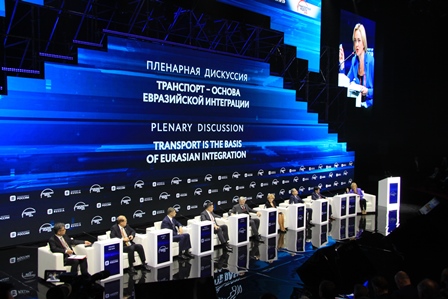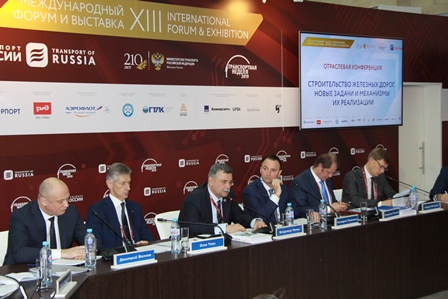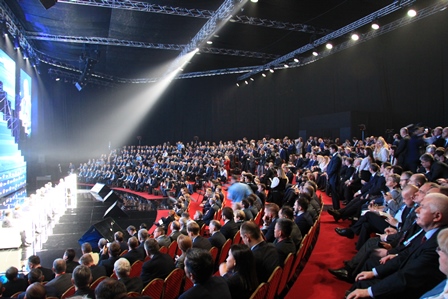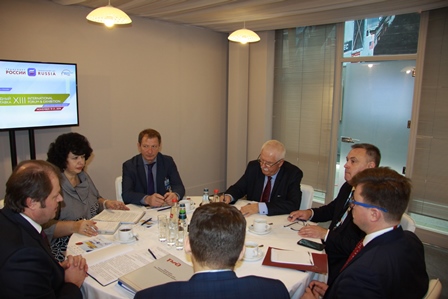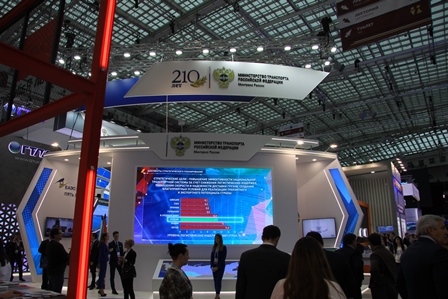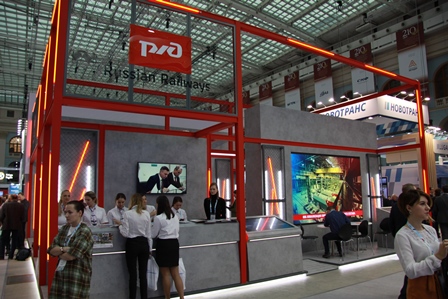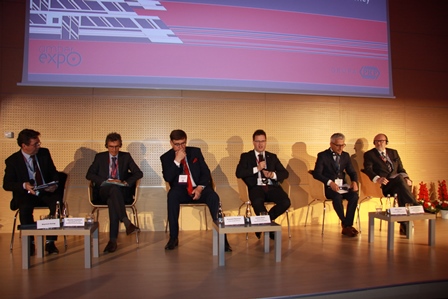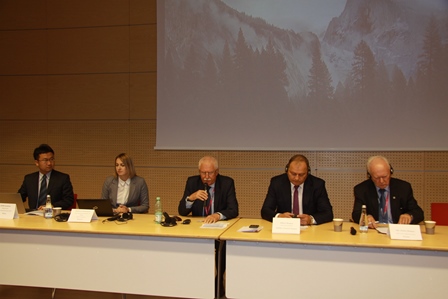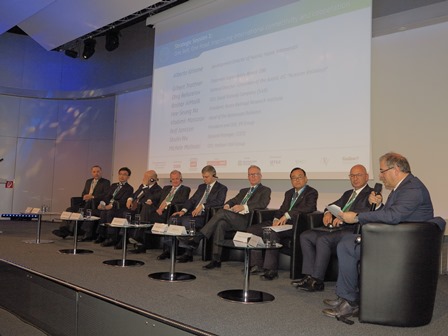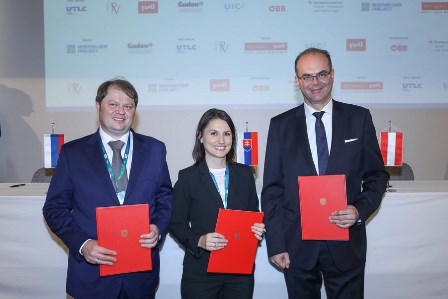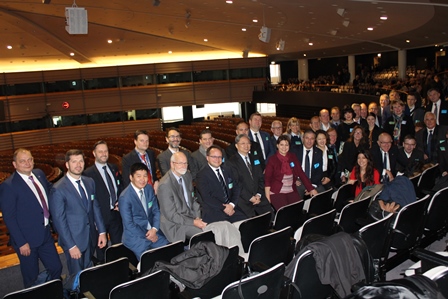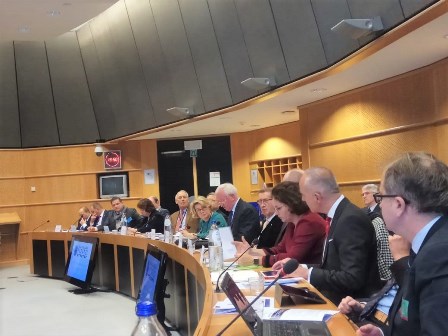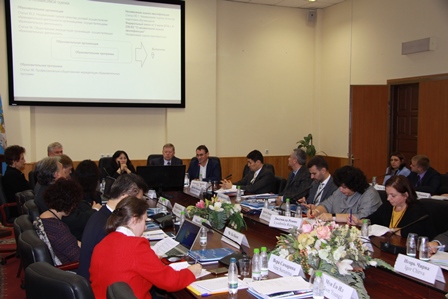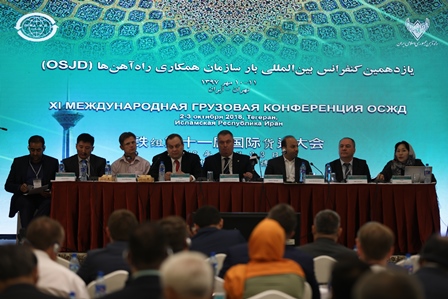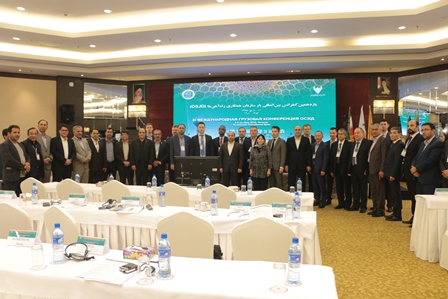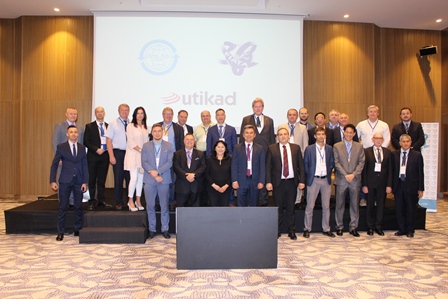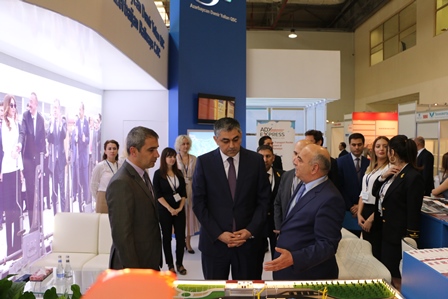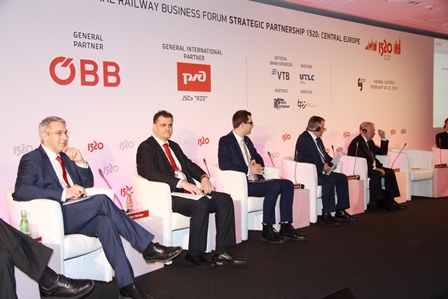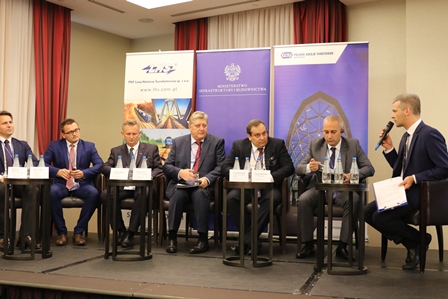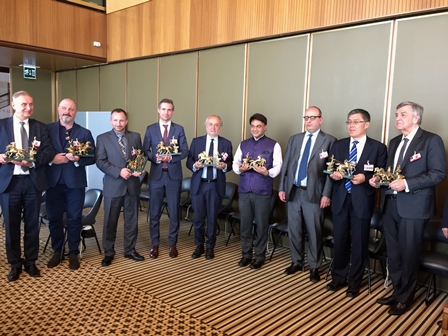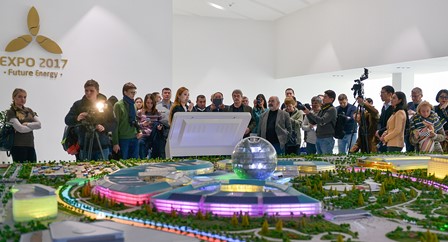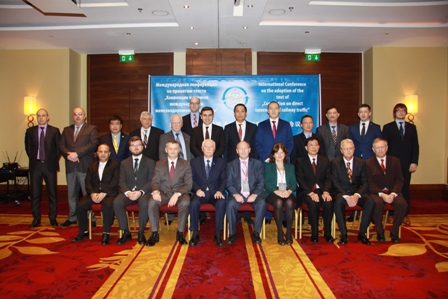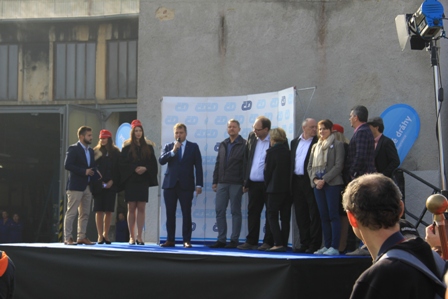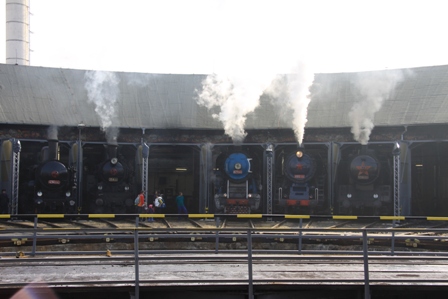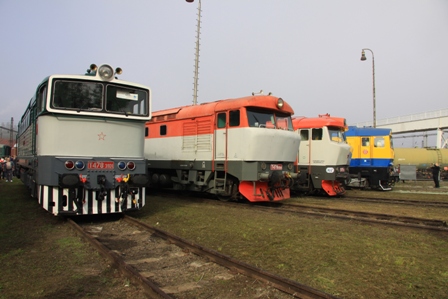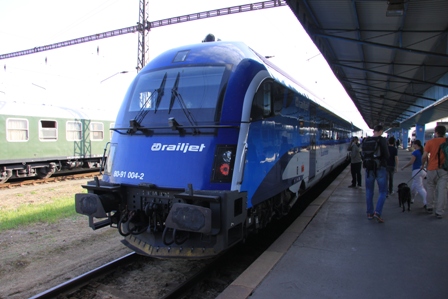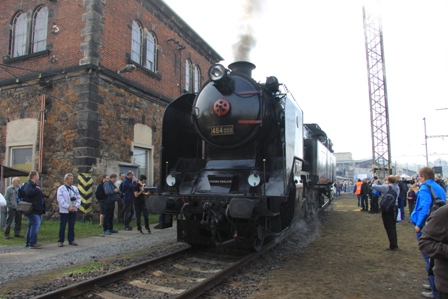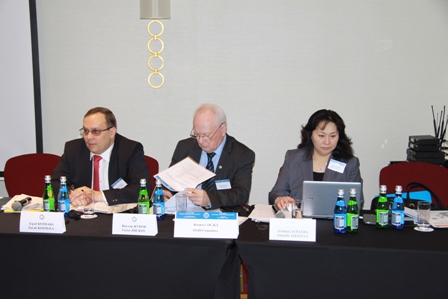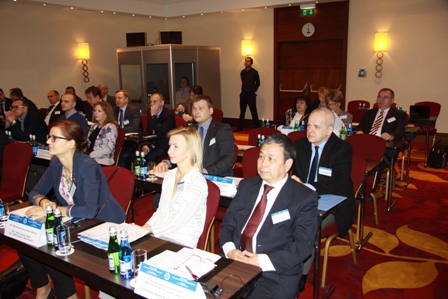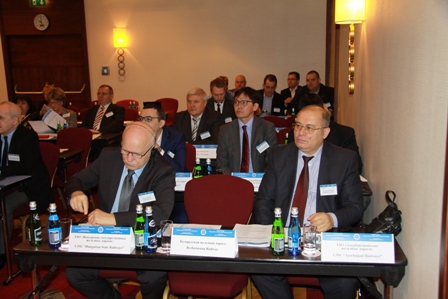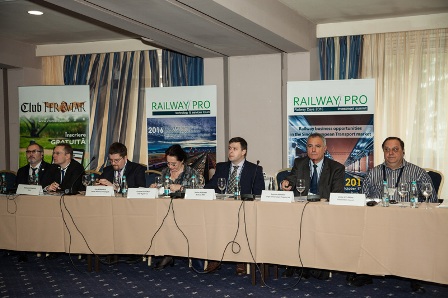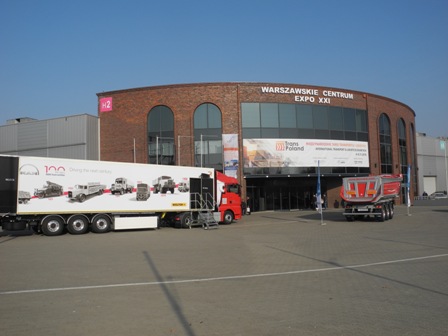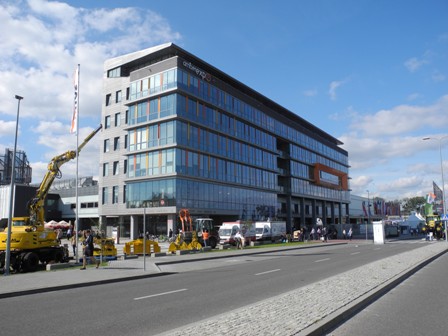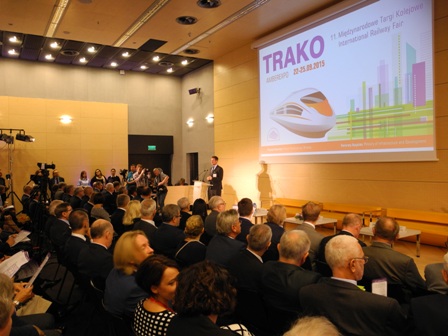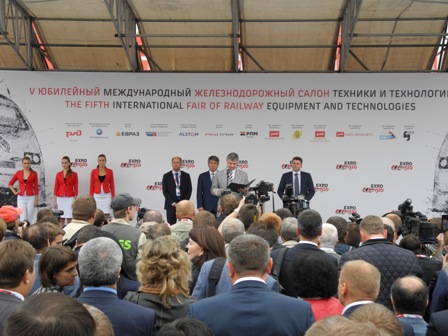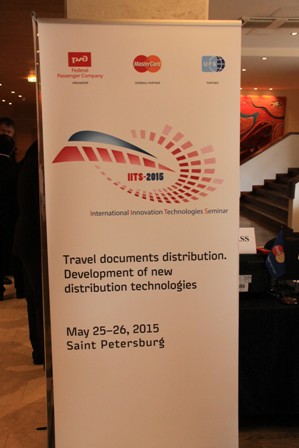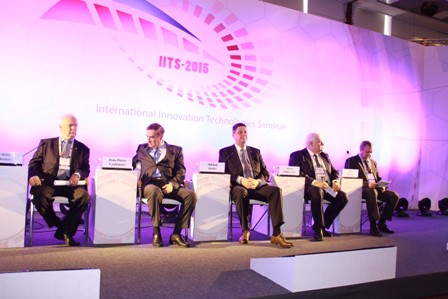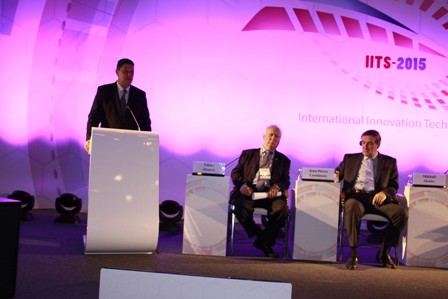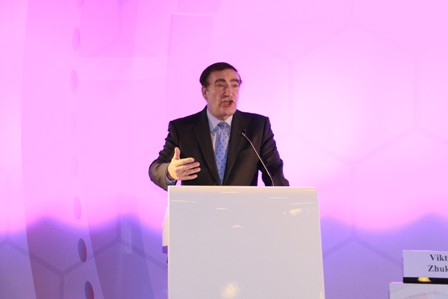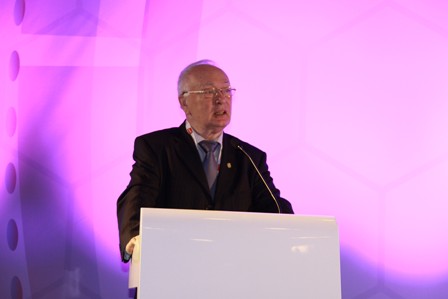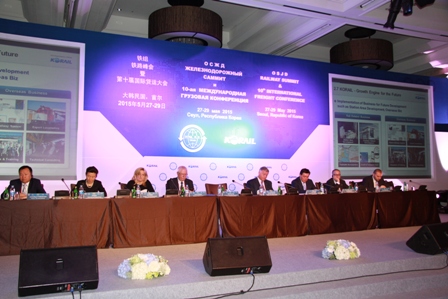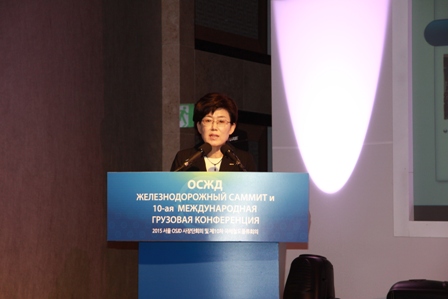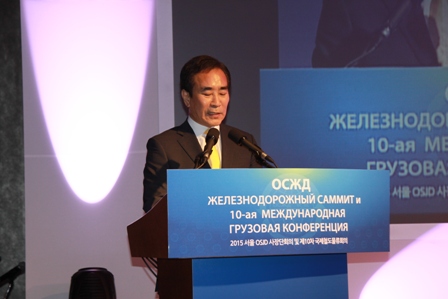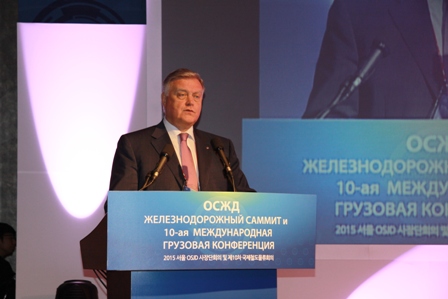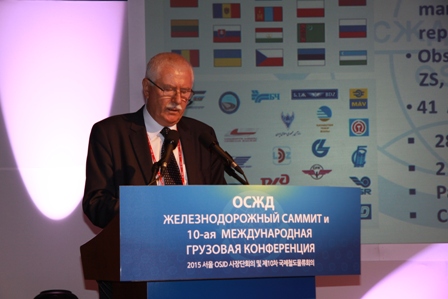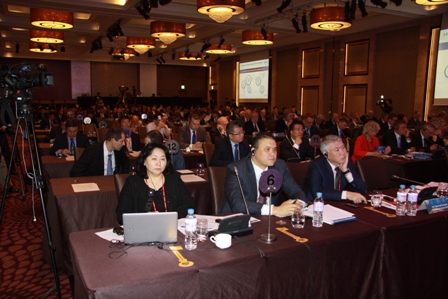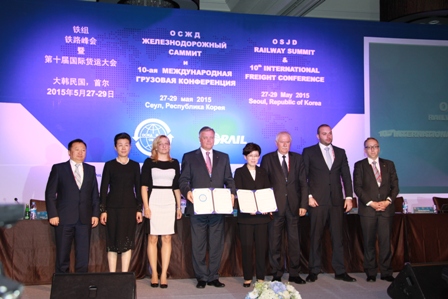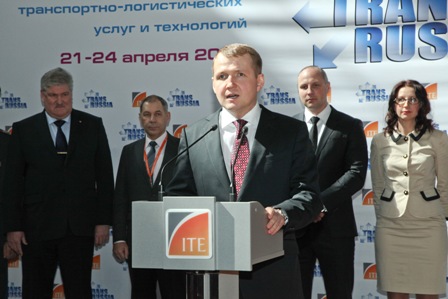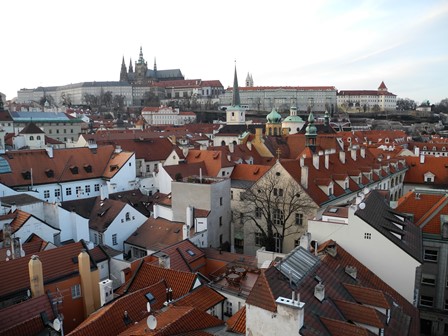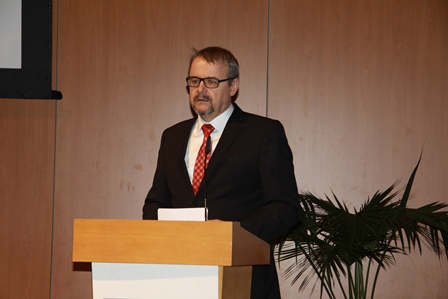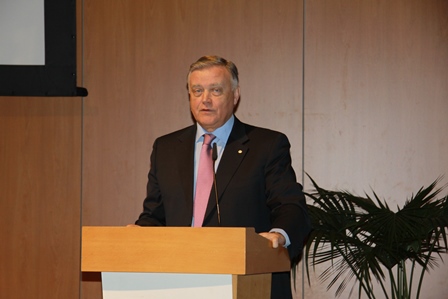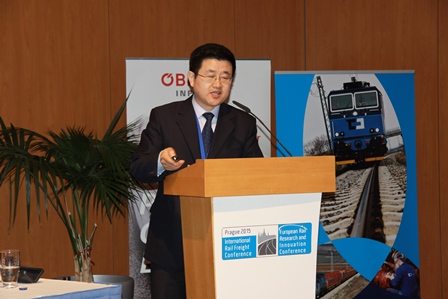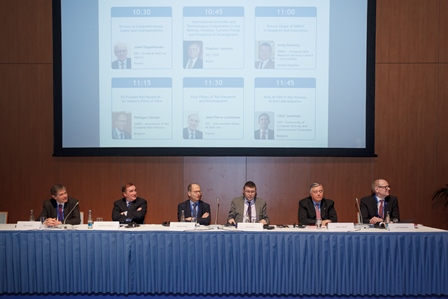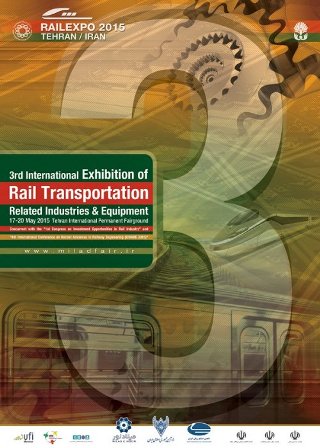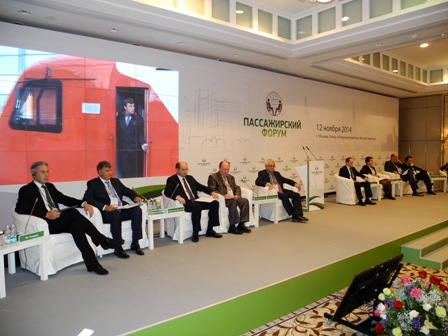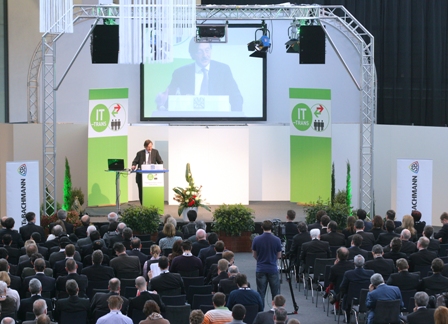International Conferences
Forum “Mongolia Transport Week 2023”
At the invitation of Minister of Road and Transport Development of Mongolia Sandag Byambatsogt, Chairman of the OSJD Committee Mirosław Antonowicz took part in the International Forum “Mongolia Transport Week 2023” held under the motto “Strengthening transport and logistics links” in Ulan-Bator from 6 through 10 November 2023. The agenda of the Forum included the consideration of the issues of stimulating the development of transport and logistics sector of Mongolia and regional transport and logistics relations with Asian countries.
The focus was made on increasing economic benefits from cooperation in the transport and logistics sector at the regional level, simplifying cross-border transport, creating interconnections in the transport sector, improving the consistency of customs data and tariffs, border procedures, paperwork, developing transport corridors, as well as joint solutions to other problems in this area. Foreign and Mongolian partners and investors were introduced to the policies, activities and major projects implemented by the Government of Mongolia in such areas as railway transport, civil aviation, road transport, maritime transport and land ports.
During the Forum, each day of which was devoted to one of the transport modes, the need was noted:
- to increase the benefits of regional economic cooperation in the field of transport and logistics;
- to simplify the cross-border transport;
- to create seamless connections in the transport sector;
- to ensure compliance with customs, tariff, border procedures, as well as of the processing of documents and data;
- to jointly address the issues of developing transport corridors and solving common industry problems.
During the panel discussion “Opportunities for increasing the competitiveness of the railway sector of Mongolia”, held on 7 November with the participation of the OSJD Committee Chairman, the Minister of Road and Transport Development of Mongolia made a report, in which a plan for the development of railway transport in Mongolia until 2030 was described. It was noted that the length of railway lines shall be increased from 2020 km to 4680 km, the total transport capacity will be increased from 36.8 million tons to 180 million tons per year, while the number of railway corridors passing through Mongolia shall be increased from one to three. The OSJD Committee Chairman made a report and presentation in the panel discussion “Development of the global railway sector and its future trends”.
As part of the event, the OSJD Committee Chairman held official meetings with the Minister of Road and Transport Development of Mongolia and with the top officials of Ulan-Bator Railway JSC.
An informal conversation was also held with the Vice Minister of Road and Transport Development of Mongolia Khaltar Luvsan.
At the proposal of the Mongolian Railway SJSC – an OSJD affiliated enterprise, a working meeting was also held with the management of the company, at which the possibilities of expanding mutual cooperation were discussed.
The OSJD Committee Chairman also visited the headquarters of the Body Group Co., Ltd., one of the leading companies in Mongolia engaged in banking, real estate management, construction management, infrastructure, mining, megaprojects and media. During the meeting with the company’s management, it was proposed that the Body Group Co., Ltd. become an OSJD affiliated enterprise.
As part of the Transport Week, the International Transport Forum (ITF) organised the “Second ITF Regional High-Level Dialogue for Asia” to discuss regional transport and logistics links between the Asian countries.
10th anniversary exhibition TransLogistica Poland
This year, the tenth anniversary International Transport & Logistics Exhibition – TransLogistica Poland took place in the EXPO XXI exhibition centre in Warsaw from 7 to 9 November, having gathered in four exhibition halls more than 380 exhibitors and about 10,000 participants from Poland and abroad – representatives of transport, industrial, forwarding, trade, consulting and logistics companies.
Among the numerous companies the transport and logistics companies from the OSJD member and observer countries were also represented, namely from: Azerbaijan, Hungary, Germany, China, Latvia, Lithuania, Poland, Romania, Ukraine, Czech Republic and Estonia. In particular, special interest was shown to the stands of PKP Cargo Connect Sp. z o.o., DB Cargo, DB Schenker, OLTIS Group, Alliance Logistics and Alliance Multimodal, Beijing Trans Eurasia International Logistics Co., Ltd. and many others.
The event provided an opportunity for the participants to familiarise themselves with the new trends and services in the field of domestic and international transport, freight forwarding and integrated logistics services for freight transport. This unique business platform in Poland brings together all those who work professionally in the transport and logistics industry, providing an opportunity to promote their products and services, exchange experience and knowledge, and establish valuable contacts.
Paweł Konowałek, General Director of the exhibition, drew attention to the growing interest in the fair not only among domestic companies, but also among foreign ones. He emphasised that this year’s exhibition was special not only because of its anniversary, but also because for the first time in the history of the event, all four pavilions of EXPO XXI, as well as the external area for vehicles, were fully utilised. Every year the exhibition grows both in the number of exhibitors and in the level of international recognition and prestige. This year, almost half of the exhibitors were represented by the companies with foreign capital.
It is also worth noting that up to 75 % of exhibitors are companies that have participated in the exhibition before.
The three-day “industry marathon” attracted the attention of all those who wished to learn about the industry’s development prospects in order to further determine their companies’ work plans. All those involved in the world of logistics, transport and freight forwarding were given the opportunity to expand their knowledge and exchange experience, which is why a business programme including a number of panel discussions, presentations and round tables was organised as part of the exhibition.
The topics of the presentations covered, among other things, such relevant issues for the industry as the impact of geopolitical factors on changes in transport supply routes, the expansion of electric mobility in the transport and logistics industry through the introduction of innovations in the vehicle fleet and environmentally friendly solutions for logistics and transport, the most important intermodal routes in Europe, optimisation and control of transport costs, automation of transport processes, ensuring the safety of cargo transportation, IT support tools for the most critical business processes and many more.
TransLogistica Poland included, among other things, the Truck&Trailer Salon – the 2nd International Exhibition for Commercial Vehicles & Fleet Management. A Friendly Employer Plebiscite was also organised – the only competition in Poland dedicated to employers in the field of transport, forwarding and logistics, as well as suppliers of products and services.
OSJD Committee delegation took part in the fourth Tbilisi Silk Road Forum
(press-release)
At the invitation of the Deputy Prime Minister, Minister of Economy and Sustainable Development of Georgia Levan Davitashvili, representatives of the OSJD Committee took part in the fourth Tbilisi Silk Road Forum, which took place on 26-27 October 2023 in the city of Tbilisi and was a continuation of the first three forums held in 2015, 2017 and 2019.
The forum brought together about 2,300 guests from 63 countries, among whom were heads of government, ministers, heads of international organisations and institutions, general directors and top managers of about 250 companies. The event was attended by the prime ministers of Azerbaijan, Armenia, Georgia and Montenegro.
The documentary film demonstrated at the beginning of the forum was dedicated to the projects of the Baku-Tbilisi-Ceyhan oil pipeline, the Baku-Tbilisi-Erzurum gas pipeline, the Baku-Tbilisi-Kars railway line being implemented with the joint participation of Azerbaijan, Georgia and Turkey, as well as the importance of the cable, which will pass along the bottom of the Black Sea to provide telecommunications links.
It should be noted that the main goal of the Forum, chaired by Prime Minister of Georgia Irakli Garibashvili, was to create a platform for the participants in the Silk Road initiative, international organisations and the private sector to discuss the prospects for deepening cooperation, international and regional trade relations.
This year’s Forum was held under the motto “Connecting Today Resilient Tomorrow”, while the key topics for discussion were the new East-West trade architecture, the growing role of the “Middle Corridor” – a logistics route connecting Central Asia and China with Europe through the South Caucasus, as well as digital connectivity, energy sector diversification, tourism sustainability and inclusive investments for a sustainable future.
Within the framework of the Forum, representatives of the OSJD Committee took active part in a number of events. Meanwhile, on the sidelines of the Forum the OSJD Committee Chairman held informal meetings with the Minister of Transport of Tajikistan Azim Ibrohim, General Director of Georgian Railway JSC David Peradze, Deputy Chairman of Azerbaijani Railways CJSC Igbal Guseinov, Deputy Chairman of the Agency of Transport and Communications of Turkmenistan Batyr Annaev, as well as with OTIF Secretary General Wolfgang Küpper.
OSJD Committee delegation took part in the 2nd high-level Global Sustainable Transport Forum (press-release)
At the invitation of the Minister of Transport of the People’s Republic of China Li Xiaopeng, the OSJD Committee delegation headed by Mirosław Antonowicz, Chairman of the OSJD Committee took part in the 2nd high-level Global Sustainable Transport Forum, which was held in Beijing from 25 till 26 September 2023 with the purpose of consolidating the outcomes of the Second Global Conference of the United Nations Organisation on Sustainable Transport (October 2021) and promoting the implementation of the United Nations 2030 Agenda for Sustainable Development and global development initiatives.
The forum was held under the motto “Sustainable Transport: Work Together to Promote Global Development” and focused on areas such as transport connectivity, overall development, stimulating innovation, priority environmental issues and global governance.
Within the framework of the Forum, a number of events were held, such as the opening ceremony, plenary session, ministerial round table on the subject “Global Governance: Building a Global Sustainable Transport Partnership”, thematic sessions – session 1 “Connectivity: promoting connectivity in the digital age”, session 2 “Shared Development: Leaving No Country or No One Behind” and Session 3 “Innovative Development: Towards a Bright Future of Global Smart Trans- port”, Workshop “For More Digital, Green and Smart Development of the Railway Transport Sector” and the Closing Ceremony. In parallel with the Forum, the 15th International Exhibition of Transport Technologies and Equipment was held (25-27 September).
The Forum was attended by the high-ranking officials of the People’s Republic of China and the United Nations, other international organisations, political leaders and ministers of transport of several countries, as well as representatives of the diplomatic corps accredited in China.
The OSJD Committee delegation took an active part in a number of events, and the OSJD Committee Chairman addressed the opening ceremony with a report on the activities and tasks of OSJD, as well as on the reliability of railway transport in the context of reducing the negative impact on the environment. In addition, the OSJD Committee Chairman took part and made presentations:
- in the panel discussion “Digital railway transport, environmental friendliness and intellectual development”;
- at the Ministerial Round Table “Global Governance: Building a Global Sustainable Transport Partnership” and the Closing Ceremony of the Forum.
Chairman of the OSJD Commission on Transport Policy and Development Strategy took part and made a presentation in the panel discussion “Sustainable railway links – interstate transport connectivity and economic development”.
Also of particular interest at the Forum were the speeches of Fei Dongbin, Administrator of the National Railway Administration of the People’s Republic of China, He Huawu, Academician of the Chinese Academy of Engineering, Qian Ming, Deputy General Director of China State Railway Group Co, Ltd. (China Railway), Sun Yongcai, Chairman of the Board of China Railway Rolling Stock Co, Ltd. (CRRC), Wolfgang Küpper, OTIF Secretary General and other participants.
Within the framework of the Forum in Beijing, the OSJD Committee delegation, headed by the Chairman, held a number of working meetings with Fei Dongbin, Administrator of the National Railway Administration of the People’s Republic of China, at which the important issues of cooperation and participation of the Chinese side in the OSJD activities were discussed; with Ngampasong Muongmany, Minister of Public Works and Transport of the Lao People’s Democratic Republic, at which further steps to strengthen cooperation were identified and the issue of holding the next meeting of the Conference of General Directors in the Lao PDR in 2025 was positively considered; with Guo Zhuxue, General Manager of the China State Railway Group Co., Ltd., at which the parties exchanged information on the works being carried out and expressed their desire to strengthen cooperation in the future.
At a meeting with the chief manager of NorthStar Sinogold Exhibition Chengdu Co. Ltd. (an OSJD affiliated enterprise), Ms. Rosie Meng, the issue of organising an OSJD Freight Conference in Chengdu in 2024 was discussed.
In addition, the OSJD Committee Chairman Mirosław Antonowicz held informal meetings within the 2nd High-Level Global Forum on Sustainable Transport with the ministers of some OSJD member states, responsible for the railway transport sector in their countries, as well as OTIF Secretary General.
National Railway Day 2023 in the Czech Republic
On 23 September 2023, at the invitation of the General Director of ČD JSC, a delegation of the OSJD Committee took part in the celebration of the National Railway Day 2023 in the Czech Republic, which was organised in the railway depot of station of Bohumín.
The history of railways in the Czech Republic dates back to 1832, when the first horse-drawn train ran between the Austrian city of Linz and the Czech town of České Budějovice. The first steam-powered train travelled from Vienna to Břeclav and then to Brno in 1839, i.e. 184 years ago.
The main purpose of this event is not only to show the historic rolling stock to the public, but also to demonstrate the latest achievements over the last few years, thus contributing to the development of public rail transport and attracting more railway passengers and more tourists.
During the celebrations, activities were organised in three thematic blocks: “World of History”, “World of Change” and “World of Fun”. On this day, during the festive events at the railway station of Bohumín and at the local depot, historical railway rolling stock as well as the most modern railway vehicles were presented. During the day, the historic rolling stock was organised for all interested visitors on the Bohumín-Petrovice u Karviné section.
During the journey in steam locomotive trains made up of old carriages, passengers could experience the spirit of the historical heritage of the Czechoslovak State Railways.
At the exhibition and during the dynamic demonstration of railway vehicles on the Bohumín depot turntable, steam locomotives (Skaličák, Rosnička, Papoušek, Šlechtična), diesel locomotives (Hektor, Pilštyk, Brejlovec, Bardotka, Čmelák, Sergej), electric locomotives and electric trains (Žehlička, Bobina, Banán, Šestikolák, Pantograf) were presented, along with other railway vehicles used by Czechoslovak State Railways (ČSD) and currently in use by Czech Railways (ČD).
The exhibition featured a large number of historical railway vehicles, including steam locomotives (e.g. Štokr, Ušatá, etc.), diesel locomotives (e.g. Hektor, Bardotka, Brejlovec, etc.), electric locomotives (e.g. Eso, Laminátka, Šestikolák, etc.), as well as multipleunit rolling stock and many other railway-related exhibits. The most modern equipment and rolling stock of the national carrier for regional and intercity transport included the well-known highspeed train Pendolino (680 series), as well as the most modern electric trains – Railjet, Regio Shark, the latest Siemens electric locomotives and many other vehicles.
The traditionally rich accompanying programme in the “World of Fun” area was enjoyed not only by the young visitors to the celebrations, but also by their parents and carers. In addition to real rolling stock, the young guests had access to model railways, fairy-tale shows with railways, amusement rides, games and other activities throughout the day.
In the evening, a unique light show with historical steam locomotives, modernised and modern rolling stock, including Banán, Orchestrion, Sergej, Čmelák, Hektor, Rosnička, Bobina, Papoušek, Hurvínek, Skaličák, Šlechtična and Věžák, was performed for numerous visitors in the depot, where special colourful lighting created a historical railway atmosphere. The show was accompanied by interesting commentaries and demonstrations of individual exhibits.
In the course of the festive events on 23 September, the delegation of the OSJD Committee held meetings with the management and personnel of the Czech Railways, SŽ, OSJD affiliated enterprises from the Czech Republic, during which their important role and active participation in the work of the Organisation and in the development of international railway traffic in the OSJD space was noted.
Forum on multimodal transport and logistics in Istanbul
(press-release)
At the invitation of the TRACECA IGC PS, Chairman of the OSJD Committee Mirosław Antonowicz took part in the Forum on multimodal transport and logistics, organised under the auspices of the Organisation of Turkic States (OTS) in cooperation with the railway administrations of the member states of the OTS and the TRACECA IGC Permanent Secretariat in the period from 13 till 14 September 2023 in the city of Istanbul (Republic of Türkiye).
The forum brought together representatives of leading transport and logistics companies, business associations, international organisations and relevant stakeholders in the region, thereby providing an opportunity for the exchange of views and experiences on the issue of international carriage of goods by various modes of transport.
During the opening ceremony of the Forum, Minister of Transport and Infrastructure of the Republic of Türkiye Abdulkadir Uraloglu and Secretary General of OTS Kubanychbek Omuraliev addressed with welcoming speeches.
During the Forum, special attention was paid to the railway transportation, the development of multimodal transport corridors, business involvement in the organisation of the transport process, as well as the legal aspects of multimodal transport, etc.
Chairman of the OSJD Committee made a presentation on the OSJD activities and also took part in the discussion within the framework of Session 5 of the Forum “Legal aspects of international multimodal transport”.
A number of working meetings were also held within the framework of the Forum.
At the meeting with OTS Secretary General Kubanychbek Omuraliev, the prospects for cooperation between the OSJD and the OTS, including the issue of preparing and concluding a memorandum of cooperation, were discussed.
Topical issues were addressed at the meeting with Chairman of the Turkmendemiryollary Agency of the Agency of Transport and Communications under the Cabinet of Ministers of Turkmenistan, Azat Atamuradov, related to the participation of Turkmenistan in the OSJD activities, including the aspects of organising the next meeting of the Conference of General Directors in Turkmenistan, sending a representative to the OSJD Committee, as well as the possible entry of Turkmenistan into some agreements and legal documents operating within the OSJD framework and other issues.
The issue of Türkiye joining the OSJD as an observer and in the future as a full member was discussed during the meeting with Deputy General Director of the Turkish State Railways (TCDD), Çetin Altun, which was also attended by the representatives of the Ministry of Transport and Infrastructure of the Republic of Türkiye.
In this context, Çetin Altun informed that at the beginning of 2021, a letter was sent to the Ministry of Transport and Infrastructure of the Republic of Türkiye expressing the TCDD’s interest in joining the OSJD as an observer. In this regard, he asked a representative of the Ministry who was present at the meeting to follow this matter.
Çetin Altun also informed that since 10 September 2021, Türkiye has been using a joint CIM/ SMGS consignment note on the Baku-Tbilisi-Kars railway line. During the conversation, the Turkish side was provided with the information about the procedure for joining the OSJD.
During the meeting with the Secretary General of TRACECA IGC PS, Aset Asavbaev, the issue of preparing and concluding a memorandum of cooperation between the OSJD and the TRACECA IGC PS was discussed.
TRAKO 2023 Fair: in the spotlight of the railway community
The TRAKO International Railway Fair, held from 19 till 22 September 2023 in the Polish city of Gdańsk, for the 15th time attracted attention of the international railway transport community. During this major biennial event, which attracts more and more exhibitors and visitors from many countries every year, over 600 exhibitors from 30 countries presented their products – innovative equipment, services, state-of-the-art technologies, rolling stock, track machines and much more – in pavilions and on special railway tracks in four main thematic blocks: rolling stock, infrastructure, freight forwarding, agglomeration and urban rail transport.
Impressive expositions were presented at the stands of the companies from the OSJD member and observer countries: China, the Czech Republic, Germany, Latvia, the Republic of Korea, Poland, Serbia, Slovakia, Ukraine and other, as well as OSJD affiliated enterprises – Track Tec, PESA Bydgoszcz, Railway Research Institute and other.
In total, the fair was visited by more than 25,000 people from over 40 countries. The open-air exhibition was a record-breaking event: 51 exhibitors, premieres and innovative exhibits of rolling stock and track equipment. Visitors could meet during panel discussions, conferences, presentations, round tables and seminars, business meetings and negotiations. Representatives of central and local authorities, transport companies, railway equipment manufacturers, rolling stock operators from various countries of the world, as well as international organisations exchanged experience and discussed the most important issues related to the development of railways, increasing their demand, efficiency and competitiveness. A number of agreements and contracts were also signed.
The heads of state and local authorities, experts, investors and representatives of the largest companies in the field of rolling stock and equipment production, transport and logistics services, infrastructure management, international organisations in the field of transport, including the OSJD Committee, took part in numerous events of the business programme – panel discussions, seminars, presentations and conferences, such as:
- opening debate “The strategic importance of railways in building Europe’s resilience”;
- debate “Railway consolidation. Opportunities and challenges”;
- seminar “High-speed railway (HSR)”;
- debate “Women in the railway industry – levelling the playing field – possibilities and obstacles”.
On the eve of the exhibition, on 18-19 September, the 72nd General Assembly of the Community of European Railway and Infrastructure Companies (CER) was held, which was attended by the Chairman of the OSJD Committee Mirosław Antonowicz. In the course of the Assembly, the tasks and priorities of the CER work for the next period were considered and defined, the election of the management was held and the budgetary issues were discussed.
Innovations in rolling stock, equipment and services
The TRAKO Fair is a demonstration and promotion of not only railway transport, but also multimodal transport, including maritime (ports and their interaction with railways) and urban transport – tram rolling stock, buses, as well as construction, loading and unloading equipment. A lot of the latest technologies and services were presented in the field of freight forwarding and logistics, the latest information and digital technologies in transport, and construction of railway infrastructure facilities.
A large exhibition space was represented by PKP Group: visitors could get acquainted here with the activities of such structural units and subsidiaries as PKP PLK, PKP Cargo, PKP Intercity, PKP LHS, WARS and other.
Such companies as ČD Cargo, LTG Cargo, CRRC, Stadler, Siemens, Plasser & Theurer, Skoda, Newag, Alstom, AXTONE, TINES, THALES, DB Arriva, Kryukovsky Railway Car Building Works, Dnepropetrovsk Railway Switch Plant and other had extensive expositions.
Track Tec, an OSJD affiliated company, presented its achievements in production of railway infrastructure elements, primarily switches, concrete and wooden sleepers.
A wide range of innovative solutions in the field of rolling stock was presented by PESA Bydgoszcz, an OSJD affiliated company. One of the hits, as usual, was the first in Poland four-axle hydrogen-fuelled shunting locomotive SM42 6Dn, on which this year visitors could take a short trip. The production of the locomotive was the result of the company’s cooperation with the Polish State Railways JSC and PKN Orlen. The SM42-6Dn locomotive has four traction motors, each with a power output of 180 kW. The power source is two 85 kW hydrogen fuel cell modules manufactured by Ballard.
Energy is generated by the chemical reaction of hydrogen with oxygen from the surrounding atmosphere. The hydrogen reserves are contained in 175 kg tanks. One refuelling is sufficient for 24 hours of locomotive operation.
The SM42-6Dn is equipped with an automated system that allows the locomotive to be operated by a single driver or autonomously. In addition, PESA Bydgoszcz presented the new Gdańsk Jazz tram.
This year, NEWAG introduced the first Griffin multi-system for the Intercity PKP, which will run up to speeds of 200 km/h. The E4MSUa-002 locomotives are built under a contract for the delivery of a total of 15 electric locomotives for 3 kV DC, 15 kV AC, and 25 kV AC systems. These are the first electric locomotives of Polish production in the colours of PKP Intercity which can reach speeds of up to 200 km/h and will operate on international routes with: Germany, Austria, Czech Republic, Slovakia and Hungary.
Continuing the trend of multi-system locomotives, Siemens Mobility also presented its flagship product: the Vectron MS locomotive for CARGOUNIT. A similar presentation of a Siemens multi-system electric locomotive took place two years ago, but then the customer was LOTOS Kolej. Siemens also prepared a presentation of its three-section electric train Mireo, adapted to operate on regional and suburban routes.
Stadler, in turn, presented its flagship product, the FLIRT electric train, for delivery in Serbia. It is one of 18 four-section electric trains assembled at the Stadler plant in Siedlce. The manufacturer also prepared another presentation: the Tango NF2 tram for Sarajevo was shown.
After 8 years, the Czech manufacturer CZ Loko returned to the exhibition with a presentation of its products. This company, which in recent years has contracted and delivered EffiShunter 300 shunting locomotives for PKP Intercity, first presented a locomotive of this series at TRAKO in 2015. However, this year CZ Loko presented a slightly more advanced technological product, namely the DualShunter 2000 locomotive. This is a dual-drive locomotive designed for medium-duty shunting and traffic control applications. It supports a 3 kV DC power supply system and is equipped with an 895 kW Caterpillar C32 EU stage V internal combustion engine, which enables operation of line connections on non-electrified routes.
This year the exhibition of rolling stock produced by the Ciegielski Rail Vehicle Factory in Poznań was also held. The PKP Intercity JSC presented 5 new coaches manufactured by this company:
- 178A-10 1st class compartment coach;
- 175A-10 2nd class non-compartment coach;
- 175A-20 2nd class non-compartment coach, adapted for carriage of bicycles;
- 176A-10 2nd class non-compartment coach;
- 177A-10 2nd class compartment coach, adapted for transportation of people with disabilities.
All these coach are characterised by the fact that they can move at a speed of 200 km/h.
Moreover, it is worth noting that the company also presented a modernised 174A coach.
DA-Group presented its complete portfolio of IP passenger information systems for installation in rolling stock. The latest passenger information systems, designed to operate even in the extreme conditions of Northern Europe, include displays, driver control panels, control units, CCTV cameras and public address systems.
Education & Career Day
During the Education & Career Day and the art competition “TRACO for Children”, young visitors to the Fair could learn a lot about the profession of a railway worker, available job offers, training and apprenticeships in the railway sector, the latest innovative technological solutions, as well as receive awards for the best works. The main purpose of the meetings was to enable a direct exchange of information and mutual expectations of employers and employees, including the choice of training areas, specialisation or doctoral studies.
Throughout the day, young visitors could take part in lectures and masterclasses dedicated to people who look for jobs in the industry. Due to the international nature of the Fair, it also provided an opportunity to get information about projects implemented in the railway transport sector abroad.
The programme also included competitions, a scholarship programme, presentation on railway technologies, panel discussions, a recruitment zone and even a possibility to take photos for CVs.
There was also a fashion show of uniforms: PKP, PKP Intercity, Polregio, Koleje Mazowieckie, Koleje Wielkopolskie, Koleje Małopolskie, Koleje Śląskie, Arriva, SKM Warszawa and SKM Trójmiasto presented their uniforms, with employees of these companies acting as models.
Additional activities during the Education & Career Day included a guided tour that provided an opportunity to learn about companies from individual sectors of the railway industry, as well as take part in ‘gamification’ – getting to know companies through a game.
Meeting of the delegations of the OSJD Committee and AZD CJSC within the framework of the First Caspian International Forum “Transport and Logistics”
(press-release)
The First Caspian International Forum “Transport and Logistics” took place in the capital city of Azerbaijan, Baku, within the framework of the 20th anniversary Caspian International Exhibition of Transport, Transit and Logistics (Translogistica Caspian), held from 31 May to 2 June 2023.
The speakers during the event were Deputy Minister of Digital Development and Transport Samir Mamedov, Deputy Chairman of the State Customs Committee Natig Shirinov, First Deputy Chairman of the Board of the Agency for the Development of Small and Medium Businesses (SMB) Natig Gasanov, Vice President of the National Confederation of Entrepreneurs’ (Employers’) Organisations Vugar Zeynalov, TRACECA General Secretary Aset Asavbayev spoke about the prospects for transit and the transformation of Azerbaijan into a centre uniting international logistics routes, as well as the optimisation of logistics costs, new technologies and automation in modern logistics, the activities of SMBs in the relevant field, human capital, and professional activities. Panel discussions were also organised within the framework of the forum on the subjects “Prospects for SMBs in logistics infrastructure”, “Prospects for transit and compliance with international customs standards” and “Human capital, vocational education and training”.
Mirosław Antonowicz, Chairman of the OSJD Committee, took part in the First Caspian International Forum “Transport and Logistics” at the invitation of the Chairman of AZD CJSC Rovshan Rustamov and took floor with a presentation on the OSJD activities. On the sidelines of the Forum, a meeting was also held between the Chairmen of AZD CJSC and OSJD Committee, at which topical issues related to the participation of the Azerbaijani side in the OSJD activities were discussed. The active participation of AZD CJSC experts in the OSJD activities was noted and hopes were expressed for the further development of mutual cooperation within the Organisation. In connection with studying the pos sibility of improving the work and elaborating the Development Strategy of the OSJD Commission on Infrastructure and Rolling Stock, taking into account the innovative component, the Chairman of the OSJD Committee proposed to expand the presence and participation of AZD JSC experts in the works of this Commission.
The issue was also raised about the possibility of holding a meeting of the Conference of General Directors (CGD) in 2024 or subsequent years in the Republic of Azerbaijan. Due to the need for additional consideration of this proposal, the Azerbaijani side expressed the opinion on the possibility of holding a meeting of the Conference of General Directors in 2025.
The AZD CJSC Chairman also informed about the work to expand the capacity of railway corridors in the East-West and North-South directions passing through the territory of Azerbaijan.
Regional Conference on Accelerating Railway Digital Transformation in Asia and the Pacific
In accordance with the Work Plan for 2023 and by the invitation of UNESCAP, the OSJD Committee delegation took part in the High-Level Regional Conference on Accelerating Railway Digital Transformation in Asia and the Pacific, which was jointly organised by UNESCAP and the Ministry of Railways of India in New Delhi, India, from 5 till 6 April 2023.
The Conference was attended by the participants from 18 countries, including Armenia, Azerbaijan, Bangladesh, Cambodia, Georgia, India, Iran, Kazakhstan, Republic of Korea, Kyrgyzstan (online), Laos, Nepal, Russia, Sri Lanka, Tajikistan, Thailand, Uzbekistan (online) and Vietnam.
Representatives of international organisations also took part in the conference: the Asian Institute of Transport Development, Birmingham Centre for Railway Research and Education (BCRRE), OSJD Committee, OTIF, UIC, CCTT and the Korean Railroad Research Institute.
The High-Level Conference included 9 sessions:
1. Introductory session: “Digitalisation of railways to improve sustainable freight transport in Asia and the Pacific”;
2. Presentations by countries – “Railway digitalisation initiatives and related challenges”;
3. “Draft strategy to accelerate rail digital transformation in Asia and the Pacific”;
4. Joint OSJD-UNESCAP session on electronic exchange of information between railways and between railways and administrative authorities;
5. “Digital platform for freight railway traffic – key problems and solutions”;
6. “Key trends in digitalisation of railway transport”;
7. “Joint ESCAP and UIC capacity-building to accelerate digital railway transport transformation in the ESCAP region”;
8. Joint ESCAP and BCRRE session on improving railway cybersecurity;
9. “Other possible challenges for the digitalisation of railways”.
In his welcome address to the Conference, Mr. Anil Kumar Lahoti, Chairman and CEO of the Railway Board (Ministry of Railways of India), thanked UNESCAP for organising the Conference on the very relevant digitalisation issues and informed participants that Indian Railways was implementing digital technology in all possible areas of its operations. He also expressed the willingness of Indian Railways to share its experience and expertise with the members of the Trans-Asian Railway Network and especially with those countries that “have just started their journey into the world of digitalisation”.
The Trans-Asian Railway Network is a coordinated plan to develop a regional rail network to support intra- and interregional trade and transport. It is 128,000 kilometres long and covers 28 countries. It was established formally by the Intergovernmental Agreement on the Trans-Asian Railway Network, which entered into force in 2009.
Ms. Mikiko Tanaka, Head of the UNESCAP New Delhi Office, also addressed the participants, stressing the need to use digital technologies to further improve railway operational performance and increase railway freight and passenger traffic to support countries in implementing the Sustainable Development Goals.
The conference participants discussed the ways and means to accelerate the digital transformation of rail transport in the Asia-Pacific region in order to increase the competitiveness of rail transport and attract more freight and passenger traffic to rail transport.
The presentation by Mr. Mirosław Antonowicz, Chairman of the OSJD Committee, at the first session provided information on the main activities of OSJD and its role in the development and growth of international railway traffic, especially in the Trans-Asian area. Further- more, the participants of the Conference were informed on the development of multimodal and intermodal transport in view of the increasing degree of their containerisation, facilitation of border crossing procedures and cooperation with supervising authorities, the possible use of SMGS consignment note for transportation on several railway sections connected by waterways, making the SMGS consignment note function as a document of title, digitalisation of the railway freight traffic, etc.
During the fourth joint OSJD-UNESCAP session, the participants of the Conference were briefed on the activities carried out by the PWG CI concerning implementation of the paperless technology for transportation of goods in international rail traffic and security of information resources and information and telecommunication infrastructure, development and updating of mandatory and recommendatory OSJD leaflets on the basis of which the paperless technology for transportation of goods in international rail traffic is implemented. Information was also provided on the standards and formats of messages in the SMGS and CIM legal fields with practical examples, on development of the legal value of paperless document interchange in bilateral and multilateral cross-border traffic on the basis of TTP technology, etc.
The two-day conference was concluded with a recommendation to adopt a regional strategy on accelerating the digital transformation of railway transport by members of the Trans-Asian Railway Network, which was presented by Mr. Sandeep Raj Jain, Economic Affairs Officer, Transport Facilitation and Logistics Section, UNESCAP Transport Division. He outlined the key components of the draft strategy, including its vision, outcomes, objectives, priority areas, cross-cutting issues, as well as implementation and monitoring, which would be further developed. The proposed vision of the strategy is to increase transport sustainability to support the implementation of the field agenda.
The proposed strategy is aimed at ensuring sustainable development until 2030, including coherence and providing impetus to ongoing digital railway initiatives, developing an ecosystem to exploit the full potential of railway digitalisation, improving operational performance, increasing the capacity and reliability, safety and security of railway assets, improving customer service, including the ease of running business, creating synergy through partnerships for rail digitalisation and ensuring high-level political support for the digitalisation of railways. In addition, it identifies eight priority areas and five key issues for deepening regional cooperation to accelerate the digital transformation of railways.
In order to finance railway digital projects, it is proposed in the strategy that countries establish a railway digital and innovation fund as a multidonor trust fund to support digital transformation in landlocked developing countries.
As regards strengthening cybersecurity in rail transport, the strategy includes developing a regional rail cybersecurity framework to share information, build capacity and learn from experience. It also aims to strengthen collaboration with the private sector by encouraging countries to support regulatory frameworks that attract private investment and expertise in digital railway applications.
The proposed strategy also includes implementation mechanisms with proposals to formulate national and subregional strategies for digitalisation of railways and to measure progress through the development of a railway digital technology and innovation index, complemented by three levels of maturity as regards railway digitalisation.
During the Conference, the OSJD Commit- tee delegation met with Mr. Anil Kumar Lahoti, Chairman and CEO of the Railway Board (Ministry of Railways of India) and informed him in detail about the activities, main aims and objectives of the Organisation, as a result of which he expressed his interest in participating and joining the work of OSJD, as well as India becoming its member.
2nd Azerbaijani International Exhibition “Rebuild Karabakh 2022”
During the 2nd Azerbaijani International Exhibition “Reconstruction, Recovery and Development of Karabakh” (Rebuild Karabakh 2022), held from 19 through 21 October in Baku, detailed information on the design and construction of railway lines and other infrastructure facilities was presented.
This event is considered to be an attractive and effective commercial and business platform for strengthening public-private partnerships supported by many government agencies and ministries. The international exhibition “Rebuild Karabakh”, which was held for the second time, has demonstrated positive dynamics, replenishing the ranks of its participants with more and more new companies.
At the special stand of the Azerbaijani Railways CJSC, the visitors were provided with the information, maps, photographs, videos and other materials demonstrating the leading projects for the construction, recovery and reconstruction of railway lines.
At present, the Azerbaijani Railways CJSC is proceeding with the construction of Barda-Agdam and Horadiz-Agbend railway lines.
According to the Decree of President of the Republic of Azerbaijan Ilham Aliyev dated 24 November 2020, the design and construction works have begun on the Barda-Agdam railway line. This railway, which has a length of 47.1 kilometers, is a single-track line, with the construction and installation works being carried out in two stages. In total, within the framework of the project, it is planned to build 133 artificial engineering structures, 4 stations and 34 transfer hubs. Currently, the construction works have been completed by 58 %.
The construction and installation works on the Horadiz-Agbend railway line with a length of 110.4 kilometers, the foundation of which was laid by President Ilham Aliyev on 14 February 2021, is being carried out in three stages.
The route of the railway line will pass through 9 stations, while in total, within the framework of the project, it is planned to build 453 artificial engineering structures, including 70 objects at the road intersections. At the moment, the earthworks and the construction of engineer structures are underway at the site from 62nd through 71st kilometer.
Both projects are expected to be completed by the end of 2023.
The exhibition was attended by 323 companies from Azerbaijan and 16 more countries, including those from Austria, the United Arab Emirates, Belarus, Hungary, Germany, Georgia, India, Iran, Sweden, Italy, Kazakhstan, Uzbekistan, Poland, Romania, Russia and Turkey.
The exposition of the exhibition was not limited to transport only, but also covered the areas of security, mining, healthcare, information technology, food industry, agriculture, construction, road infrastructure, tourism and cultural heritage, energy, ecology, etc.
International Conference “Berner Tage 2022”
(press-release)
The capital of Switzerland, Bern, hosted the intramural International Conference on international railway transport law “Berner Tage 2022” (Bern Days) from 9 to 10 June 2022, which was attended by more than 70 representatives from railway companies – infrastructure managers, carriers and operators, as well as international organisations – OSJD, OTIF, DG MOVE, CIT, CER, UIC, etc.
Considering that this year the CIT celebrates its 120th anniversary, the “Berner Tage” began with a presentation by CIT Secretary General Cesare Brant about the history of the organisation’s foundation and its activities at the present stage, and then the participants moved on to discussing the legal problems facing the railway transport in general, affecting all participants in the railway services market, including international organisations.
The conference was chaired by CIT representatives: the general panel was chaired by CIT Secretary General Cesare Brand, the panel dedicated to CIM – by CIT Deputy Secretary General Erik Evtimov and CIM Committee Chairman Gilles Mugnier.
The Secretary General of OTIF, Wolfgang Küpper, presented the latest legal amendments and developments in COTIF and its appendices, and gave an overview of the main amendments to the Regulation concerning the International Carriage of Dangerous Goods by Rail (RID) that will enter into force in 2023 and the amendments to the technical appendices, the APTU and ATMF Uniform Rules. He also presented the latest work of the Ad Hoc Committee on Legal Affairs and International Cooperation on, inter alia, the interfaces between customs and transport regulations, the application of the CIM/SMGS unified consignment note and the digitalisation of freight transport documents in international transport.
During the conference, the participants were also presented reports on the following topics:
- Latest developments in Rail regulation in the EU (Sandro Santamato, Head of Policy Unit at DG MOVE);
- Latest developments in Railway regulation from the perspective of the sector (Alberto Mazzola, Executive Director of CER);
- EU policies on digital freight transport information (Erik Evtimov, CIT Deputy Secretary General);
- Customs issues in freight transport (Wessel Sijl, DB Cargo);
- CIT mission CIM: Challenges and perspectives for tomorrow’s rail freight (Cristian Cuenca, DB Cargo);
- Data platforms for rail transport in Europe (Tibo Noёl, UIC);
- Multimodality: state of play (Prof. Isabelle Bon-Garcin, University of Lyon);
- New functions of transport documents (Prof. Rainer Freise, consultant at the Goethe University Frankfurt);
- Harmonisation of the legal framework for the use of infrastructure (Péter Rónai - RNU, Nina Scherf - CIT);
- Liability between Railway Undertaking and Infrastructure Manager in case of delays – focus on court practice (Claus Leitzke and Erik Staebe, DB AG);
- Data protection in passenger and freight traffic (Fernando de Lucas, RENFE);
- Questions of law affecting transborder carriage between two different legal systems in the context of EU law, specifically with regard to traffic with non-EU countries (Karolina Kusz, Lawyer of PKP JSC);
- Mediation: evolution and challenges of this alternative dispute resolution method between rail carriers and their customers. The French experience (Jean-Luc Dufournaud, SNCF Voyageurs mediator);
- Lessons from COVID for transport law (Vanessa Perez, UIC).
The participants of the seminar noted that holding such events is very important for dis- cussing topical issues and exchanging views and experiences in order to further improve transport law in the field of international railway transport both in Europe and beyond.
International railway exhibition Rail Business Days
(press-release)
The international railway exhibition Rail Business Days was held in Brno (Czech Republic) from 7 till 9 June 2022. More than 60 companies from both Czech Republic and other countries took part in the exhibition, including OSJD railways (ZSSK, CD), OSJD affiliated enterprises – OLTIS Group, Gepard Express SE and Enteria, as well as representatives of the OSJD Committee.
This year, over 10,000 people visited the exhibition within 3 days, who were able to see several dozen units of rolling stock in an open area with railway tracks about 800 metres long, as well as various exhibits on the stands of companies in the exhibition halls of the complex.
The rolling stock presented at the exhibition, led by the legendary French high-speed train TGV, which symbolises the opening of the high-speed trains era both in Europe and in the Czech Republic, aroused considerable interest at the exhibition. Meanwhile, other exhibits aroused no less interest among visitors, among which most notable were the Czech Railways InterJet electric train, Siemens Vectron and Traxx MS3 locomotives, where the visitors could get acquainted with their advantages right in the cockpit, track and diagnostic machines of the Railway Infrastructure Manager of the Czech Republic – Správa železnic SZ, locomotives of the Czech freight operator ČD Cargo, modern track and tamping machines manufactured by Plasser & Theurer of Hrochostroj and much more. The inner part of the fair was also very attractive, including a special section for schoolchildren and students who opted for the profession of a railway worker. The interest in the exhibition from the visitors, who were looking forward to holding such events after the removal of pandemic restrictions, exceeded all the organisers’ expectations.
The opening ceremony of the exhibition on 7 June was attended by the Minister of Transport of the Czech Republic, Martin Kupka, and the General Director of the Railway Infrastructure Administration of the Czech Republic, Jiří Svoboda. The industry conference, which was held as part of the exhibition, was attended by more than 400 representatives of the professional community, who were able to get acquainted with the presentations and speeches in five discussion panels on the following subjects:
- “The state and prospects for the development of railway business in the Czech Republic”;
- “The current state and prospects of regional passenger transportation by rail”;
- “Modern, safe and environmentally friendly railway”;
- “Innovations and trends in the field of safety, assessment, certification and testing of railway rolling stock, railway and transport systems”;
- “Freight railway traffic – trends, news, plans; rolling stock fleet”.
Of great interest during the conference were reports and presentations presented by the SNCF experts on the construction, maintenance and benefits of high-speed traffic in France.
The unique combination of the fair and the exhibition, including the exposition of the rolling stock, the industry conference and the opportunity for personal communication allowed the forum participants and visitors to establish closer business contacts, exchange experience and opinions on the most important aspects in the development of railway transport both in the Czech Republic and abroad.
Major railway institute in Poland to mark its 70th anniversary (press-release)
On 15 March 2022, under the honorary patronage of the Minister of Infrastructure of the Republic of Poland, Minister of Funds and Regional Policy of the Republic of Poland, President of the Railway Transport Administration, Chairman of the Civil and Water Engineering Committee of the Polish Academy of Sciences, Chairman of the Transport Committee of the Polish Academy of Sciences, with the participation of the representatives from the OSJD Committee, UIC and the Central Council for Scientific and Research Institutes, the Jubilee Scientific Conference was held, dedicated to the 70th anniversary of the Railway Research Institute and the 25th anniversary of the Test Track Operation Centre.
The history of the Railway Research Institute dates back to more than 70 years ago, when the Research Institute of Railway Transport was established by the order of the Minister of Rail- ways on 30 May 1951. In 1958, the Institute was transformed into the Central Railway Scientific and Technical Centre, and later on, in 1987, into the Railway Scientific and Technical Centre. The last change in the status of the Railway Research Institute took place in 2010 and, like in the previous cases, was stipulated by changes that occurred in the legal regulations.
Until 2000, the Institute had been a structural subdivision of the Polish State Railways. After the restructuring and commercialisation of the railways in Poland, the Institute became an independent division subordinated directly to the Ministry of Transport (later the Ministry of Transport, Construction and Maritime Economy, then the Ministry of Infrastructure and Construction, the Ministry of Infrastructure). Its workshops and laboratories employ many specialists who have accumulated a huge amount of technical, organisational and operational knowledge and know-how. Many innovative solutions have been developed and implemented here, thanks to which the railway has recorded a significant technological progress in many areas of its activities, such as:
- research in the field of rolling stock, certification tests of railway passenger coaches, freight wagons, locomotives and traction units;
- railway infrastructure research – stationary railway infrastructure facilities (e.g. tracks, turnout switches, subgrade formation), control and signalling systems (e.g. electronic interlock tests), electric traction and power supply systems (e.g. power quality assessment), telecommunications and telematics (e.g. mobile radio system change strategy), environmental protection.
The conference was moderated by Andrzej Massel, philosophy doctor of engineering sciences, Acting Director of the Institute of Railway Transport.
In honour of the 70th anniversary of the Institute, a number of employees were awarded state awards, which were presented during the scientific conference on behalf of Andrzej Duda, President of the Republic of Poland.
The OSJD Committee was represented at the Conference by Mirosław Antonowicz, Chairman of the OSJD Committee, and Angelina Shurganova, Specialist of the OSJD Commission on Infrastructure and Rolling Stock.
In his welcoming speech, Mirosław Antonowicz noted the invaluable role of the Railway Research Institute in the country’s transport system and, on behalf of Javid Gurbanov, Chairman of the Azerbaijani Railways CJSC, conveyed warm words of wishes for brilliant prospects, new discoveries, achievements and professional success to a large team led by Andrzej Massel, Acting Director of the Railway Research Institute. He also expressed great satisfaction with the Institute’s application to join the OSJD as an affiliated enterprise, noting that this fact would contribute to a wider mutually beneficial exchange of knowledge and experience in such areas as transport policy and development strategies, infrastructure and rolling stock, vocational training and training of personnel in the field of railway transportation and in other areas.
The Conference presented in detail the research work and scientific prospects of the Institute in such areas as “Railways as the basis of railway transport”, “Improvement in the organisation, movement and management of railway transport”, “Electric traction as a key component to ensure minimal impact of railway transport on the environment”, “Control systems and safe driving management as a key component of active safety”, “Development of rolling stock by increasing functionality and safety” and other, including the most important interdisciplinary work carried out recently by the Institute.
In connection with the 70th anniversary of the Railway Research Institute, a monograph is being prepared for publication, which will present the history of the Institute’s foundation and development, the ongoing scientific and research work, as well as plans and prospects for the activities of various institute’s departments that work in many meaningful areas.
International Conference “Innovations for Sustainable Transport Development. Development of Human Capital”
(press-release)
On 5 April 2022, an international scientific and practical conference “Innovations for Sustainable Transport Development. Development of Human Capital” was held at the CCTT Secretariat in Moscow using a videoconferencing mode.
This event was organised by the International Coordinating Council for Trans-Eurasian Transportation (CCTT), Russian University of Transport (RUT (MIIT)) (an OSJD affiliated enterprise) and the Association of Transport High Schools. The conference was attended by more than 250 representatives of transport, logistics, forwarding companies and associations, educational and research institutions in the field of transport from the Republic of Azerbaijan, Republic of Belarus, People’s Republic of China, Mongolia, Russian Federation and other countries, experts and specialists from the United Nations Economic Commission for Europe (UNECE), Economic and Social Commission for Asia and the Pacific (UNESCAP), Organisation for Co-Operation between Railways (OSJD).
Welcoming addresses were made by CCTT Secretary General Gennady Bessonov, Rector of the Russian University of Transport Alexander Klimov, President of the Association of Transport High Schools Boris Lyevin.
They noted that among many different sectors of the modern economy, the transport industry occupies a special place in its sustainable development. Today, the transition to a digital economy is one of the main development priorities, because it is the level of digitalisation that will be an indicator of the degree of competitiveness of railway transport in the new technological paradigm and open up new prospects for innovative development. In this regard, the importance and role in the development of human capital and in raising the level of education, training and competence of specialists in the field of transport operations is increasing to ensure the functioning and sustainable development of transport links.
This international scientific and practical conference was aimed at developing and strengthening cooperation in the field of systematic study of identified issues and was held within the framework of five thematic sessions: “Human capital as a factor in the growth and development of economy”, “Synthesis of the best domestic and foreign educational practices”, “Employer’s view – expectations and realities”, “Best practices – view of the industry”, “Harmonisation of the transport industry and education interests – view of transport industry science and education”.
The plenary session “Human capital as a factor in the growth and development of economy” was devoted to the consideration of international experience in training specialists to meet the needs of the transport industry in qualified specialists in the field of international railway and intermodal transportation. Hereto, the opinions, perspectives and possibilities of international transport organisations were presented.
Madan B. Regmi, Head of the Transport Research and Policy Section, DEng, UNESCAP Transport Division, in his report on the subject “Supporting sustainable transport development in the Asia-Pacific region” informed the participants about the priorities of UNESCAP in the field of transport, measures taken to achieve the sustainable development goals, including the possibilities of mitigating the environmental consequences in transport within the framework of the concept of Avoid-Shift-Improve (A-S-I).
He emphasised the importance of analytical and research work, noting the launch of the Asia-Pacific Transport Research and Education Network in accordance with the decision of the UNESCAP meeting of the Ministers of Transport.
Roel Janssens, Economic Affairs Officer of the UNECE Sustainable Transport Division, in his presentation on the subject “International transport regulation system. The role of the UNECE Inland Transport Committee” spoke about the decisions taken by the UNECE Inland Transport Committee in relation to supporting the development of human capital. He highlighted the most important inland transport conventions under the purview of the UNECE ITC, as well as the new projects of the Committee – the Sustainable Inland Transport Connectivity Indica- tors (SITCIN), the Inland Transport and Trade Links e-Learning Platform and the International Transport Infrastructure Observatory.
The presentation of the Organisation for Co-Operation between Railways on the subject “Innovative approaches in the OSJD activities aimed to ensure a high level of vocational education/training in the field of railway transportation” included the information regarding the activities of the Ad Hoc Working Group on the issues of vocational training/education in the field of railway traffic; about the creation, goals and activities of the OSJD Academy, as well as the development and adoption of the documents necessary for the implementation of its activities; conducting various activities within the framework of vocational training; maintaining and using the Web-portal of the OSJD Internet information resource in the field of vocational training and education.
The delegates from the Eurasian Economic Commission (Elena Sherysheva) and the CIS Transport Coordination Meeting (Natalia Shebarshina) spoke about the work being carried out on the sectoral and integration tracks, noting the importance of reflecting the relevant practical aspects of this agenda in the educational process.
CCTT Deputy Chairman, President of the Association of Freight Forwarding and Logistics Organisations of the Russian Federation Olga Melnikova outlined the importance of training specialists in the field of forwarding and logistics as a guarantee of successful implementation of the transport industry projects, having invited the transport universities to cooperate.
The rectors and professors of the leading transport universities presented their views, developments and advanced solutions: of the Russian Federation – the Russian University of Transport (RUT (MIIT)), the St. Petersburg University of Railway Engineering of Emperor Alexander I, Far-Eastern State University of Railway Engineering, Ural State University of Railway Engineering; China – Beijing Jiaotong University (an OSJD affiliated enterprise), Beijing United University; Republic of Belarus (Byelorussian State University of Transport); Mongolia (Mongolian State University and the Railway Institute); co-chairmen of the Association of Transport Universities of Russia and China, autonomous non-profit organisation (ANO) “Institute for Research and Expertise of Vnesheconombank”, representatives of the RZD OJSC, UTLC-ERA JSC (an OSJD affiliated enterprise), China Railway Electrification Bureau group of companies, the Association of Freight Forwarding and Logistics Organisations of the Russian Federation.
Synthesis of the best domestic and foreign educational practices, challenges and opportunities of universities, the relationship between theory and practice in the process of training and retraining, the use of targeted training and innovative teaching methods, qualification assessment and quality assurance of a specialist, requirements for the level of foreign language knowledge, digital technologies and inter-sectoral competencies, ways to ensure the development of the potential of universities, motivate students, teachers and researchers while maintaining the values and traditions of the academic world, were considered in detail in the reports and presentations delivered by:
- Rector of Beijing Jiaotong University Wang Jiaqiong,
- Director of the Institute of Management and Digital Technologies of RUT (MIIT) Sergey Vakulenko,
- Rector of Beijing United University Guo Fu, - Rector of the Byelorussian State University of Transport Yury Kulazhenko,
- Co-Chairman of the Association of Rectors of Transport Universities of Russia and China from the Chinese side Li Xuewei,
- Deputy Director of the Ulan-Bator Railway Institute V. Selenge.
Within the framework of the session “Employer’s view – expectations and realities”, the problems and opportunities of interaction between the companies and educational institutions were considered, including the ways to work out the optimal mechanism for such interaction, training of specialists in the implementation of international transport and logistics projects, determining the key qualifications of employees, providing knowledge of relevant technological maps of production processes, the formation of professional skills and personal potential for working in the context of digital transformation, interaction with foreign partners and regulation in the international arena, as well as the industry’s requirements for knowledge of the regulatory and legal framework and industry’s standards of existing and potential partners.
Within the session “Best practices – view of the industry”, the participants discussed the experience of companies in retraining and advanced training of specialists in their training centres, centres for additional professional education, the participation of transport, logistics, IT companies in the educational process: what are the best practices for cooperation between companies and universities, how companies can help universities in the preparation and conduct of practical lessons and classes.
The session “Harmonisation of the transport industry and education interests – view of transport industry science and education” was devoted to the issues of organising labour market monitoring, the need for qualifications in the training and retraining of personnel, the development of standards in transport education, the definition of modern approaches to learning in digital reality, opportunities of remote and hybrid learning and their role in strengthening the interaction within the industry, education and science, as well as the problems of employment in the domestic and foreign markets, taking into account the implementation of a flexible and stable connection “university-employer”.
The participants highly appreciated the open and substantive dialogue that took place, which was proposed to be continued in the framework of subsequent conferences on the development of human resources for the transport and logistics industries, to be organised by the CCTT, RUT (MIIT) and the Association of Transport High Schools, in order to exchange experience, review and develop conditions for targeted training and innovative teaching methods.
Railway Safety Forum (press-release)
On 17 March 2022, the IX Specialised Railway Safety Forum 2022, organised by the Polish Office of Rail Transport together with the company Tor-Audytor, was held in full-time intramural mode in Warsaw.
Among the forum participants were representatives of the companies – infrastructure managers, operators and carriers, specialists in the field of maintenance and repair, as well as in the field of ensuring of safety in railway traffic management.
This event is held annually and has already approved itself as a platform for constructive dialogue and exchange of experience with the effective recommendations and solutions being developed. The consideration of pressing problems, exchange of opinions and discussions between experts and practitioners, development and implementation of recommendations con- tribute with no doubt to the provision of traffic safety in railway transport. It is impossible to solve the problem of improving security without developing effective measures based on determining the causes that give rise to security risks and threats. This was one of the main tasks of the Forum.
The OSJD Committee was represented by Angelina Shurganova, Specialist of the Commission on Infrastructure and Rolling Stock, a member of the OSJD Committee from the Republic of Azerbaijan.
Opening the Forum, the President of the Office of Rail Transport, PhD. Eng. Ignacy Góra, said: “The safety of the railway system is of paramount importance, and every year it is necessary to do everything possible to improve it.” In his welcoming speech, Ignacy Góra thanked Minister of Infrastructure Andrzej Adamczyk and State Secretary of the Ministry of Infrastructure Andrzej Bittel for their personal active participation in legislative processes related to changes in state laws and regulations, and in various projects such as the creation of the Centre for Testing and Monitoring of Train Drivers (Centrum Egzaminowania i Monitorowania Maszynistów), which is planned to be launched in 2023, the introduction of the European Train Traffic Control System (ETCS Limited Supervisor), which is designed to provide a higher level of traffic safety on the railways.
The forum began with a discussion on the subject “All for One”, during which the participants reviewed the activities and plans of the Railway Transport Authority in the Republic of Poland, as well as the structure and tasks of the European Union Agency for Railways (ERA).
The President of the Office of Rail Transport noted that one of the safety factors on the railway is the qualitative training and education of drivers. He also noted that starting from 2023, the Office of Rail Transport will consider and evaluate candidates for the qualification of “locomotive driver”. To this end, three simulators have already been purchased to improve the system of training and examination at the Driver Testing and Monitoring Centre, and work is underway to install an additional equipment calibration module. A project initiated by the Office of Rail Transport was discussed, which aims to inform the younger generation that the railway is the safest and the most environmentally friendly mode of transport, as well as an excellent and promising place to work.
Ignacy Góra also summed up the outcomes of 2021 as the European Year of Railways.
Kamil Wilde, Vice-President of the Office of Rail Transport summed up the work in the field of ensuring safety in railway transport in 2021. According to the preliminary estimates, in 2021 there was a slight increase in the accident rate as compared to the previous two years: 713 accidents, incidents and accidents were recorded on the railway lines and siding tracks. The main reasons for the increase in the accident rate in railway transport (about 75 % of all cases) is the human factor with the participation of third parties not related to the railways. There were 221 accidents at railway crossings, of which 199 were collisions with people who illegally found themselves on the territory of the railway premises. The Office of Rail Transport is preparing to introduce innovative monitoring systems at category D level crossings, as they remain the most dangerous.
The Forum participants discussed the state of safety over the previous year, potential threats to the safety of railways and preventive measures aimed at preventing accidents, as well as analyzed the activities of railways in this area and considered in detail the implementation of the technical component of the 4th railway package and the promotion of security culture.
The TRAKO Fair in Gdańsk captures the attention of the world’s railway community again
The TRAKO International Railway Fair held on 21-24 September 2021 in Gdańsk (Poland), made itself a focal event for the international railway industry for the 14th time. With over 30,000 square meters of exhibition space and new tracks built specially for the event, the fair provided its more than 500 exhibitors with an excellent opportunity to showcase their products: various railway equipment, services, technologies, rolling stock, track machinery, and a multitude of other products. A total of 39 countries were represented at the fair and in its business programme. In the complicated environment of global restrictions imposed in response to the pandemic, the fair’s organisers did an excellent job of accommodating over 23 thousand exhibitors and visitors who attended the fair and its various events.
Major stands were put up by the companies from the OSJD member countries and OSJD observers such as Hungary, Germany, China, Latvia, Lithuania, Republic of Korea, the Czech Republic, Poland, Slovakia, Russia, Romania, Finland, and France; as well as by the OSJD affiliated enterprises – Track Tec, PESA Bydgoszcz, OLTIS Group, Frauscher Sensortechnik, AXTONE, and others.
The biennial TRAKO fair is a large-scale event held in Gdańsk, Poland, that attracts the growing numbers of participants and visitors from many countries of the world each time it is held. This year was no exception in the face of the ongoing pandemic-related restrictions. The organisers were able to conduct the fair as a whole and all of its individual events without a flaw, as well as to ensure epidemiological safety without making the events less attractive.
The TRAKO Fair showcases and promotes not only the railway transport, but also multimodal transport operations that include a sea component (ports and their interface with rail- ways), as well as urban transport such as trams, buses, construction and loading and unloading vehicles and equipment.
A multitude of the state-of-the-art forwarding and logistics technologies and services were presented, along with the newest information and digital transport technologies and the technologies used in the construction of railway infrastructure. As a result of numerous conferences, round table discussions, and workshops, a number of agreements and contracts were signed.
TRAKO has always featured an extensive business programme that includes numerous discussions, workshops, and company presentations. This year was no exception. Throughout the week, representatives of the Poland’s Ministry of Infrastructure, central and local authorities, transport companies, railway equipment manufacturers, and rolling stock operators from many countries of the world, and representatives of international organisations including the OSJD engaged in sharing their best practices and discussing top-priority objectives in developing railway transport while improving its market offering, efficiency, and competitiveness.
As expected, a big chunk of the exhibition space was taken by the PKP Group (an OSJD member) that celebrates its 20th anniversary this year. The Group highlighted the contributions of its units and subsidiaries such as PKP PLK, PKP Cargo, PKP Intercity, PKP LHS, Wars, and others.
As before, principal organisers and sponsors of TRAKO 2021 included Track Tec, a major Polish manufacturer of railway equipment and an OSJD affiliated enterprise. The company specializes in the manufacturing of railway infrastructure elements, with a focus on railway switches and sleepers, both concrete and wooden.
A large array of innovative rolling stock solutions was presented by PESA Bydgoszcz, an OSJD affiliated enterprise. The Poland’s first hydrogen-powered four-axle shunting locomotive SM42 6Dn series became a hit at the show.
The locomotive went into production as a result of the company joining efforts with the Polish State Railways and PKN Orlen.
The SM42-6Dn locomotive has four traction motors of 180 kW each. Energy is supplied by two 85-kW hydrogen fuel cell modules made by Ballard. The energy is generated as a result of a chemical reaction between hydrogen and oxy- gen sourced from the atmosphere. Hydrogen is stored in tanks with a holding capacity of 175 kg.
One refill is designed to support the operation of the locomotive for 24 hours. The SM42-6Dn is fitted with an automated system that allows the locomotive to be operated by a single person, and with an obstacle detection system.
Another innovative rolling stock unit presented at the TRAKO fair by PESA Bydgoszcz Rail Transport JSC was the Elf EU electric multiple unit train built under a contract with the private Czech operator RegioJet. The contract to deliver seven such trains had been signed in March 2019.
The 53-m-long two-unit two-system (3 kV DC and 25 kV AC) electric multiple unit train Elf EU series is an export modifica- tion of the Elf 2 train widely used in Poland.
One of the two units is the traction unit and the other is a trailer. Capable of seating a total of 154 passengers, the Elf EU is designed to run at up to 160 km/h.
The Organisation for Co-Operation between Railways (OSJD) has been an active participant in practically all TRAKO fairs held so far. This year, when the OSJD celebrates its 65th anniversary, was no exception. The OSJD stand provided a wealth of information on the 65 years of the Organisation’s history, on the efforts of the OSJD to develop the 13 OSJD railway transport corridors, organise and operate passenger and freight traffic between Europe and Asia, improve and harmonise transport law, to include such as important branch as the application of the unified CIM/SMGS consignment note, expand the use of electronic documents in international transport operations, and many others.
During the exhibition, the OSJD held the 9th International Interagency Conference on Practices of Border Crossing by Railway Transport. The OSJD representatives also attended the Conference “Night Traveling in Europe by Rail” held on 23 September.
On 20 September, the Connecting Europe Express that had departed Lisbon for a five-week tour of Europe, arrived at a track in the vicinity of the fair. The train consisted of the coaches provided by various European railway passenger operators. It brought passengers from many countries who had an opportunity to visit the fair.
At night, the train left to continue its 20,000-km trip with stops at more than 100 cities in Europe on its way to its final destination, Paris.
During the Education and Career Day and the TRAKO for Kids arts competition, young visitors to the fair were given an in-depth peek into the operation of railways and available job, training, and internship opportunities offered by railways. Young visitors also learned a lot about cutting-edge technological innovations and received awards for best projects.
IX Forum of Intermodal Transport (FRACHT)
The IX Forum of Intermodal Transport (FRACHT) was held in Warsaw (Poland) from 18 till 19 August 2021 in an intramural format.
This is considered to be the largest and most important event in the field of transport, forwarding and logistics in Poland. Within the frame- work of the Forum, a number of events were held: plenary sessions, discussion round tables dedicated to the functioning and development of all modes of transport.
Taking into account the pandemic affecting, inter alia, the transport industry, the topics of discussion at FRACHT were devoted to the development of strategic actions to make the activities of the logistics industry players easier in an unstable world situation.
Interest in the FRACHT Forum has been growing with every passing year, as it was evidenced by the number and level of participants. This year, the Forum was attended by the representatives from Azerbaijan, Kazakhstan, Uzbekistan, Ukraine and other countries: HE Ambassador Extraordinary and Plenipotentiary of the Republic of Azerbaijan to the Republic of Poland Nargiz Gurbanova, HE Ambassador Extraordinary and Plenipotentiary of the Republic of Kazakhstan to the Republic of Poland Alim Kirabayev, Trade and Economic Counselor of the Embassy of the Republic of Uzbekistan in the Republic of Poland Askar Beknazarov, Deputy Minister of Infrastructure of the Republic of Poland Andrzej Bittel and others.
On the part of the OSJD Committee the Forum events were attended by Chairman of the OSJD Committee Mirosław Antonowicz and Specialist of the OSJD Commission on Infrastructure and Rolling Stock – representative of the Republic of Azerbaijan at the OSJD Committee Angelina Shurganova.
The Forum brought together the widest audience of participants in the intermodal transport market, highly-qualified experts, analysts and investors to discuss the achievements, changes, strategic plans in the development of transport corridors and topical issues in the field of sea, road and railway transport.
As part of the Forum’s business programme, Mirosław Antonowicz informed the participants about the OSJD activities, dwelling in detail on such issues as the organisation and implementation of freight traffic in the Eurasian space and on the Silk Road during the COVID-19 pandemic.
During the Forum, the discussion round tables were held in the framework of four panels. During Panel II “New transport corridors, new initiatives, threats, opportunities; is it possible to remain indifferent to these processes?”, Chairman of the OSJD Commit- tee informed about the planned measures and the work done to develop international transport corridors passing through the territory of the OSJD member states, while Angelina Shurganova answered a number of questions from the Forum participants and drew attention to the development of transportation along the Trans-Caspian international transport route and the Baku-Tbilisi-Kars railway line. She stressed that despite the pandemic, the volume of freight traffic on the Azerbaijani Railways has not fallen down, but showed a positive dynamics of increase.
Thanks to the organisers of the event: the “Europe – North-East” International Association (ENEIA), the Poland-Asia Chamber of Commerce and Industry, working in cooperation with the Polish-Ukrainian Chamber of Commerce (PUIG), the participants of the Forum of Intermodal Transport (FRACHT) had the opportunity not to only to familiarise the participants with the plans and activities of their organisations and companies, but also to conduct active negotiations with experts and concerned parties from various transport and logistics enterprises, which contributed to the creation of a constructive dialogue for the exchange of experience and consideration of the functioning and development of the intermodal and multimodal transport branch.
50th International Railway Fair “PRO//Motion.Expo-1520”
On 26-29 August 2021, the experimental railway loop of the research center VNIIZT JSC in Sherbinka, Moscow, Russia, hosted the jubilee international railway fair PRO//Motion.Expo targeting the 1520-mm gauge railway systems.
The fair was conducted in its usual face-to-face format.
This year, the fair had 212 exhibitors, including companies from OSJD member countries and OSJD observers such as Belarus, Germany, China, Russia, France, and the Czech Republic; the OSJD affiliated enterprises – Firma TVEMA JSC and KAMAX/AXTONE, as well as the international railway organisations – OSJD and UIC. Presented in the indoor area of 5000 square meters and on the 1500-m outdoor track were numerous innovative solutions in railway technology, equipment and machinery, including 71 real-life specimens of rolling stock. The leading Russian and international rolling stock manufacturers such as TMX, CTM (Sinara), Siemens, Alstom, UWC, UWZ, MWZ, and others showcased their achievements. In the course of the fair, 13 Memoranda of Cooperation were signed.
A total of 32 countries were represented at the fair and within its business programme.
In the complicated environment of restrictions imposed in many countries of the world to prevent the spread of the pandemic, the organisers spared no effort to make the fair’s visitors, whose number totalled over 30 thousand, safe.
More than a thousand persons participated in the business programme that included this year 25 topical round tables, discussion boards, and meetings covering a wide range of professional issues: from transport machine engineering and sustainable technologies to economics, digitalisation, and introduction of autonomous rolling stock units. Attention was focused on environ- mental protection and introduction of innovative solutions to the industry.
Mr. Oleg Belozyorov, RZD OJSC General Director and Chairman of the Management Board, noted during the opening ceremony that “this year was declared the European Year of Railways in Europe, the Year of Science and Technology in Russia, and the Year of the Environment in the RZD Holding Company.
Thus we decided to dedicate all events of the anniversary fair’s business programme to those topics that are closely interrelated. Today, the business stands to gain from being environment- friendly. It is not just a passing trend. First of all, we are talking about high-tech, rapidly growing markets that will increasingly attract investment. We are working to capitalise on the green advantages of railway transport, and we shall work to increase them.
As part of these efforts, we have been introducing innovative environment-friendly energy-saving and resource- saving technologies. We are determined to continue to scale up the effects of our work to protect the environ- ment.” Speaking at an online business programme event, Chairman of the OSJD Committee Mr. Mirosław Antonowicz focused on technical and technological elements in the development of the 13 OSJD railway transport corridors, on the introduction of innovative digital and paperless technologies onto OSJD railways, widening the adoption and use of the unified CIM/SMGS consignment note, and ways to improve the efficiency and competitiveness of railway transport.
In addition to the tight business and exhibition programmes, presentations of state-of-the-art, ‘hot-out-of-the-oven’ railway equipment and rolling stock units were made on the open-air grounds of the exposition. Under the motto “From history to innovation”, dynamic shows of the rolling stock and track machinery were conducted, with the exhibits also available on static display. Visitors to the exhibition could enjoy a fascinating locomotive parade that featured a range of units from the ‘Ь’ steam engine built in 1897 to state-of-the-art vehicles, including the Lastochka (“Swift”) innovative autonomous unmanned EMU, the newest version of the Ivolga-3 (“Oriole-3”) EMU, and a variety of other coaches, wagons and locomotives.
By tradition, PRO//Motion.Expo ended with a large-scale festive event, the Day of Open Ways. This year, the expo was opened to the public free of charge for two full days. Visitors could see the parade of locomotives, take part in contests to win memorable prizes, and enjoy rides on the Lastochka autonomous unmanned electric train.
OSJD Training Seminar on the subject “Application of the CIM/SMGS consignment note”
In accordance with the Work Plan of the OSJD Commission on Freight Traffic, on 7-8 July 2021, an OSJD Training Seminar “Application of the CIM/SMGS consignment note” was held, in which representatives of the following railways of the OSJD member countries took part: AZD CJSC, ARA, BC, VZD, GR, RAI, “KTZ NC” JSC (KZH), Korail, KRG, CFM, UBZD JSC, Ministry of Infrastructure of the Republic of Poland, PKP Group JSC (PKP Cargo JSC, PKP Informatyka JSC, PKP LHS LLC), RZD OJSC, TDZ, TRK, UTI, UZ, ČD Cargo; OSJD Observers – VR Group, National Society of French Railways – Freight Transport (Fret SNCF); OSJD affiliated enterprises – “UTLC ERA” JSC, JSC Eurosib SPb Transport Systems, PLASKE JSC; international organisations – WCO, EAEC, CIT, CCTT, TITR (TMTM) International Association; invited representatives of “TCDD-Transport” JSC, as well as representatives of the OSJD Committee.
Mirosław Antonowicz, Chairman of the OSJD Committee, opened the Seminar and addressed its participants with a welcoming speech, noting the importance of the event for all participants in the transportation process in order to further increase the efficiency of the development and organisation of freight traffic using the CIM/ SMGS consignment note on the Asia-Europe-Asia routes. He informed about the joint work of OSJD and CIT on the creation of a unified CIM/SMGS consignment note, which made it possible to carry out international rail freight traffic between the SMGS and CIM parties without re-issuing transport documents, and also wished successful and fruitful work.
Secretary of the OSJD Commit- tee Attila Kiss welcomed the participants of the Seminar and noted that the exchange of experience between the railways of the OSJD member countries, observers and affiliated enterprises of OSJD will contribute to the expansion of the geographical area of the use of the CIM/SMGS consignment note, as well as to improvement of the quality and competitiveness of freight traffic on the Asia-Europe-Asia routes. He expressed confidence that good results will be achieved at the Seminar and that it will be successful.
In her greeting to the participants of the Seminar, the Chairperson of the OSJD Commission on Freight Traffic Zubaida Aspayeva, who was also the leader and moderator of the Seminar, emphasised that the Seminar was aimed at acquainting with the legal aspects of the CIM/ SMGS consignment note application, including the adopted changes and amendments since its implementation, at the exchange of practical experience of its use in order to improve the professional level and quality of knowledge, qualifications, experience, skills of specialists whose activities are related to the planning and organisation of railway transportation of goods under the SMGS and CIM/SMGS consignment notes.
During the two sessions of the Seminar, presentations were shown and reports and speeches were delivered.
During the consideration of the presented
Session 1: Legal aspects of the application of the CIM/SMGS consignment note
- Brief history of creation, legal basis;
- General provisions of the GLV, provisions on the application;
- Contents of the CIM/SMGS consignment note, languages, sample, list of wagons and containers (rules for filling in and using the CIM/SMGS consignment note, issuing a set of CIM/SMGS shipping documents etc.).
Speakers
Zubaida Aspayeva, Chairperson of the OSJD Commission on Freight Traffic;
Erik Evtimov, Deputy Secretary General of CIT;
Olga Fisenko, Head of the division in the Department of Commercial Work of UZ JSC.
- State of affairs on the improvement of the “CIM/SMGS Consignment Note Manual” (Annex 6 to the SMGS);
- Electronic CIM/SMGS consignment note. Legal basis.
Speakers
Okhunboy Khudoyorov, Specialist of the OSJD Commission on Transport Law;
Erik Evtimov, Deputy Secretary General of the CIT.
- Electronic data interchange
Speaker
Mario Matta, Specialist of the OSJD Permanent Working Group on Coding and IT (PWG C&IT).
- On the application of the electronic CIM/SMGS consignment note in the China-Europe-China traffic in transit on the Russian Railways.
Speaker
Yuri Surodin, Deputy Chief Engineer of CTTS – a branch of RZD OJSC.
- CIM/SMGS commercial act (presentation and consideration of claims for carriage under the CIM/SMGS consignment note).
Speaker
Svetlana Yakimova, Head of Department of the Moscow CTTS – a branch of RZD OJSC.
- Facilitation of customs procedures using the CIM/SMGS consignment note.
Speaker
Kyung-chan Pak, WCO Technical Attaché.
Session 2: Practical application of the CIM/SMGS consignment note
- Organisation of freight traffic using the CIM/SMGS consignment note (transportation routes with the use of the CIM/SMGS consignment note);
- Expansion of the geography of application of the CIM/SMGS consignment note;
- Organisation of transportation in the direction of Europe – Asia (from Germany, France, Czech Republic, Slovakia);
- Organisation of transportation in the direction of Asia – Europe.
Speakers
Zubaida Aspayeva, Chairperson of the OSJD Commission on Freight Traffic;
Vasily Senyuta, Deputy Director of the Department of Commercial Work of UZ JSC;
Michal Vítež, Head of the International Affairs Section for Freight Transport, “ČD Cargo” JSC;
Xavier Vanderpepen, Manager of Fret SNCF;
Larisa Korshunova, Director for Government Relations, “UTLC ERA” JSC.
- Experience in the application of the CIM/SMGS consignment note in the implementation of multimodal transport.
Speakers
Vladimir Okroev, acting Head of the Kaliningrad CTTS – a branch of RZD OJSC;
Oleg Platonov, Chairman of the Supervisory Board of PLASKE JSC.
reports and presentations, a fruitful, professional discussion and exchange of practical experience on the application of the CIM/SMGS consignment note in the Europe-Asia and Asia-Europe traffic took place.
Representatives of “TCDD-Transport” JSC informed the participants of the Seminar on the application of the CIM/SMGS consignment note in Turkey. It was noted that currently there are no obstacles to the implementation of a single CIM/SMGS consignment note for consignments to Turkey and European countries. “TCDD- Transport” JSC has successfully completed the inclusion of the CIM/SMGS consignment note in the simplified procedure of customs operations and carried out its electronic integration.
It is expected that the Ministry of Trade of the Republic of Turkey will develop the necessary legislative norms to ensure the possibility of using this document in the implementation of transactions under a simplified procedure. For its part, “TCDD-Transport” JSC is closely following this process. It is expected that the CIM/ SMGS consignment note will be included in the simplified procedure within a few months.
The representative of Fret SNCF, Mr. Xavier Vanderpepen, informed the participants of the Seminar about the ongoing work on the use of the CIM/SMGS consignment note, noting that since its implementation, 1000 trains have been organised from France to Kaluga (Russian Federation), which delivered Peugeot Citroën automotive components to an assembly plant in the Kaluga Oblast. Its route runs from Vesoul (France) through Frankfurt an der Oder (Germany), Małaszewicze (Poland), Brest (Belarus) with a destination in Vorotynsk (Russia).
In his speech, the representative of Fret SNCF dwelled on the existing difficulties faced by European carriers and shippers regarding the execution of the CIM/SMGS consignment note for the transportation of goods from the European countries to China and, in general, in the Europe- Asia route. In this regard, the Chairperson of the Seminar proposed to organise a training event on the legal basis for the application of the CIM/ SMGS consignment note and practical experience of its use.
Deputy Secretary General of CIT Erik Evtimov suggested using the format of regional seminars in order to further expand the scope of application of the CIM/SMGS consignment note.
Representative of “UTLC ERA” JSC Larisa Korshunova informed the participants of the Seminar that “UTLC ERA” JSC, together with the shareholders of RZD OJSC, BC and “KTZ NC” JSC, provided transportation of more than 250 thousand TEUs of transit cargo; however, at the same time, the percentage of the CIM/SMGS consignment note use in such traffic remains low – no more than 10%. In this regard, the Company supports OSJD’s efforts to develop the practice of using the CIM/SMGS consignment note and confirms its readiness to participate in events for shippers in Europe.
Cooperation between OSJD and WCO is of great importance. In this regard, “UTLC ERA” JSC is also interested in participating in the work of a joint working group, including work on digitalisation and development of information interaction between transport participants and customs authorities. Taking into account the fact that transportation by rail has a low degree of risk from the point of view of compliance with customs legislation, it was proposed not only to consider the development of paperless technologies within the framework of the current legal regulation, but also to set the task of reducing the administrative burden and reducing the amount of information that is subject to indication in the customs transit document up to the information volume of the CIM/SMGS consignment note.
The representative of PLASKE JSC, Oleg Platonov, acquainted the participants of the Seminar with the UN/CEFACT project “Digital Transformation of Multimodal Transport”, as well as with the conclusions and recommendations adopted at the XI International Seminar on Trade and Transport Facilitation (26-28 May 2021, Odessa, Ukraine, in a videoconferencing mode). The project on data coverage for multi- modal transport used in electronic documents was carried out in cooperation with UNECE, based on UN/CEFACT standards and data reference models.
At the Seminar, much attention was paid to the discussion of the implementation of the CIM/SMGS electronic consignment note, as well as the possibilities for its use, while the importance of working with customs authorities in order to simplify customs procedures when recognising the CIM/SMGS consignment note as a transit customs declaration was noted, as well as the results of the practical application of the consignment note and the prospects for use on new routes.
The ideas expressed by the participants of the Seminar and their implementation will help to reach a new level of organisation of freight traffic using the CIM/SMGS consignment note and to develop further fruitful cooperation.
The chairperson of the Seminar expressed the hope that its program contributed to interesting and useful discussions, further understanding of the processes that place in the field of railway freight transport, and confidence that the joint efforts of all participants in the transportation process will contribute to the smooth implementation of freight traffic in the Eurasian space.
The “TransRussia” International Exhibition held its 25th edition
(press-release)
(информационное сообщение)
The 25th Anniversary International Exhibition for Transport and Logistics Services, Warehouse Equipment and Technologies “TransRussia” was successfully held from 12 till 14 April 2021 at the International Exhibition Center “Crocus Expo” in Moscow (Russia) in the usual intramural mode (offline). The event was organised by the Hyve company, which occupies one of the leading positions in the Russian market of exhibition services.
The significance of the TransRussia exhibition for the railway industry is confirmed by its long-term support from state and executive authorities, industry unions and associations.
This year, the exhibition was supported by: the Ministry of Transport of the Russian Federation, the Committee of the State Duma of the Russian Federation for Transport and Construction, the Moscow Government, the Russian Union of Industrialists and Entrepreneurs.
The representatives of the RZD Logistics JSC and RZD Centre of Corporate Transportation Services (CCTS), as well as the UTLC ERA JSC took an active part in both the exhibition and the business programme.
This year, the partners of the exhibition’s business programme were: CCTT, Digital Transport and Logistics Association, National Union of Transport and Logistics Experts (SEL), Logistics Coordination Council, Alvarez & Marsal, Franco-Russian Chamber of Commerce and Industry (CCI France Russie), Council of Supply Chain Professionals.
In the difficult conditions of restrictions introduced in many countries of the world to prevent the spread of the pandemic, the organisers of the exhibition did everything possible to ensure the presence of 217 companies from 22 countries of the world, including from the following OSJD member states and observers: Azerbaijan, Belarus, Hungary, Germany, China, Republic of Korea, Latvia, Lithuania, Mongolia, Russia, Ukraine, Finland and Estonia. The OSJD affiliated enterprises were also represented at the exhibition, including the UTLC ERA JSC, CTM LLC, TransContainer PJSC and Ruscon Group.
The exhibition “TransRussia – 2021” was attended by the companies from Russia and other countries, providing services for the carriage of goods by rail and by other modes of transport, forwarding, handling of goods in terminals and ports, financial services and customs clearance of goods, integrated logistics services, solutions for mandatory labelling of goods, warehouse equipment and ware- house automation and IT solutions. The total area of the exposition amounted to more than 14,000m2.
For three days, the exhibition was visited by several thousand people who were able not only to get acquainted with the latest achievements of the exhibiting
companies, but also to take part in an extensive business programme, which included conferences, presentations, round tables and seminars/workshops on various aspects of the transport industry, within which 170 speakers took the floor and about 3000 delegates took part.
More than 50 companies were presented at the exhibition for the first time. Among them is the Delo Group of Companies (Russia), which includes such OSJD affiliated enterprises as TransContainer PJSC and Ruscon Group. The Group is the largest transport and logistics holding in Russia, managing sea container terminals in the Azov-Black Sea, Baltic and Far Eastern basins, a network of railway container terminals, a fleet of containers and fitting flat wagons. All the companies being part of the Group were rep- resented at the collective stand of the Group.
At the stand of the Republic of Azerbaijan, information was presented regarding the activities of the Azerbaijani Railways CJSC in the field of freight railway and multimodal traffic, as well as regarding the activities in this area of the companies ADY Express and ASCO Logistics.
The Republic of Belarus represented such well-known transport and logistics companies as AvantRail LLC, Gradalogistic Foreign Transport Unitary Enterprise, Beltamozhservice RUE, and OZTM CJSC, specialising in the production of freight rolling stock and tank containers.
From the Republic of Kazakhstan, the following companies took part in the exhibition: PTC Holding LLP (owner and operator of various railway rolling stock), Logsoft LLP (transportation of agricultural and mineral raw bulk cargoes, transshipment of grain and oilseed cargoes), freight forwarding companies providing services in the field of freight railway traffic – Express Oriental LLP, Shyngar Trans LLP and TransKom LLP.
The People’s Republic of China was represented by such transport and logistics companies as Shenzhen Neptune Logistics Co., Ltd., First-Trans, GH Forwarding, Qingdao Aoda Industrial Co., Ltd., Railink International Intermodal Logistics Co., Ltd., Shanghai Business World International Logistics Co., Ltd., etc.
At the joint stand of the Republic of Latvia, the following organisations and companies were presented: Ministry of Transport of the Republic of Latvia, Latvian Railway SJSC (LDz), Freeport of Ventspils Authority, AVE TRANS Group (transport and logistics company in the field of intermodal transport), Transasia LV LLC (accompanying services for transportation), A&A Logistic (transport, forwarding and logistics services), Stena Line (international transport and tourism company and ferry operator), “Transit business information” (organisation of presentations, participation in international exhibitions and advertising of Latvian ports and Latvian railway, etc.), FB Logistics (a transport company offering services for road, sea and railway transportation of goods), ALPA Centrums (a freight forwarding company specialised in the organisation of international freight traffic).
At its exhibition stand, the United Transport and Logistics Company – Eurasian Railway Alliance JSC (UTLC ERA JSC), which is an OSJD affiliated enterprise, demonstrated the company’s performances in recent years. In particular, the growth of transit in 2020 amounted to 64 %, reaching 546.9 thousand TEUs, and in the first quarter of 2021, UTLC ERA transported 154.9 thousand TEUs, which is twice as much as in the previous year.
Another major exhibitor at the fair was the 85-hectare East West Gate (EWG) intermodal combined terminal in Europe, built at the junction of two railway systems (with 1435-mm and 1520-mm track gauge). The construction of the terminal with the latest technology began in January this year in Fényeslitke (Hungary), near the Hungarian-Ukrainian-Slovak border. The EWG terminal, scheduled for commissioning in the first quarter of 2022, will have a nominal throughput of 1 million TEUs per year.
A number of German companies were represented at the exhibition, including at the joint stand of the Federal Republic of Germany (German national stand), the railway of which (DB AG) are an observer member of OSJD. Such large companies as Goldhofer JSC (manufacturer of semitrailers of various types), HOYER GmbH Internationale Fachspedition (transport and logistics company specialized in liquid cargo transportation), Kocks Ardelt Kranbau LLC (manufacture of crane equipment), pei tel Communications LLC (production of radio technical devices, including for transport), Quehenberger Logistics DE LLC (transport and logistics company) and Liebherr (production of construction equipment, cranes and other equipment) demonstrated their achievements.
The exhibition space of the Rail Cargo Group (Austria), part of which is Rail Cargo Hungaria Co. – the OSJD affiliated enterprise) arose great interest among the visitors.
By tradition, major agreements of intent, memoranda on cooperation and contracts were signed within the framework of the exhibition.
The Delo Group of Companies and Rosatom State Corporation signed an agreement on the implementation of joint measures aimed at facilitating the transition of logistics terminals to the use of low-carbon green energy sources.
The TransContainer PJSC (an OSJD affiliated enterprise, part of the Delo Group of Companies) signed a memorandum of cooperation with Evropak LLC and Blago Group of Companies in the field of forwarding services for the transportation of vegetable oils; entered into an agreement of intent with Fintrans GL in the field of containerised transportation of Ilim Group products (the leader in the Russian pulp and paper industry) across Russia and abroad; signed a memorandum of cooperation with Luzales LLC in the field of transportation of sawn timber for export; signed a memorandum on strategic partnership and cooperation in the field of international multimodal transportation with Azuma Shipping LLC, signed a memorandum on strategic partnership and cooperation in the field of international multimodal transportation with the NFC Logistics Center. An agreement was reached with Rolis (part of the Global Ports group) – the developer of IT solutions to implement a pilot project for the introduction of an information system for the intelligent management of the Chita-1 container terminal.
The FESCO Transport Group signed an agreement of intent with NtechLab (a technology partner of the Rostec State Corporation) on the use of digital technologies at the group’s facilities; a strategic partnership agreement with Alltrucks in the development of digital products for the automation of processes in the field of the freight traffic by road; a cooperation agreement with the Globus TLC in the field of transportation of sawn timber from Siberia and the Russian Far East to China.
The Novotrans Group of Companies and VTB Leasing Group of Companies have signed an agreement for the maintenance of freight wagons.
Smart Logistics and SinaraPromTrans (a structural division of SinaraTransport Machines Holding, part of the Sinara Group) signed a sublicense agreement to connect the company to an IT solution for carriers and cargo owners.
The Digital Transport and Logistics Association (CTL) signed a strategic partnership agreement with the Association of Commercial Seaports (ASOP) and an agreement with GLONASS JSC to join the association.
Eurosib SPb - Transport Systems JSC (an OSJD affiliated enterprise) and IC RZD-INVEST JSC signed a memorandum of cooperation for a period of 3 years in the development of terminal and logistics infrastructure, removing bottlenecks in the infrastructure at the junctions with ports and border crossings, construction of new facilities.
Business programme
This year, within the framework of the business programme, the main tasks and prospects for the development of the transport and logistics services market were in the focus: what problems the industry faced during 2020, what steps were taken, and what still needs to be implemented by the business entities and the state.
A rich business programme provided transport professionals with additional opportunities to exchange experiences and strengthen personal contacts.
In 2021, 6 industry conferences were held within the framework of the TransRussiaTransport and Logistics Congress:
- 25th International Conference for Cargo Owners and Carriers TransRussia (12-13 April);
- 5th Outsize and Heavy-Lift Cargo Carriage Conference Breakbulk Russia (12 April);
- 5th Conference “IT Solutions in Transport and Logistics” (12 April);
- 3rd Conference on Management and Optimisation of Supply Chain (14 April).
The following events took place for the first time:
- E-commerce Logistics Industry Conference (13 April);
- 1st Conference on Enterprise Intralogistics Management (13 April).
A particularly important event has become the plenary discussion on the topic “Development of freight traffic in modern realities.
Trends, prospects, constraints, new opportunities”, which considered the following issues: new opportunities for growth and constraints in the development of the transport industry in Russia, the status of the Russian market of transport services, plans for 2021, logistics trends in 2020- 2021, how the pandemic crisis has changed the freight market, technological and legislative innovations in the freight transport sector, the development of transit, the speed and time of delivery, the role of subsidies in the transit of goods, market consolidation, digitalisation as an element of unification of all modes of transport. The discussion was attended by Emil Kaikiev (Eurasian Economic Commission), Sergey Pavlov (Russian Railways OJSC), Sergey Shishkaryev (Delo Management Company), Fabio Amato (Mercitalia Rail), Li Jimin (China International Association of Freight Forwarders), Alexey Grom (UTLC ERA JSC, an OSJD affiliated enterprise), Arkady Korostelyev (FESCO), Stanislav Georgievsky (Russian Export Center JSC), Kanat Alpysbayev (Kazpost JSC), Igor Chebunin (Russian Post JSC, an OSJD affiliated enterprise). The experts named automation, service availability, integration and emergence of ecosystems, digitalisation, environmental friendliness as the main industry trends. They discussed options for the transit of goods from Europe to Asia, the development of international transport corridors, introduction of digital technologies at all stages of cargo transportation.
The discussion was moderated by Gennady Bessonov, CCTT General Secretary.
Besides, a number of other topics were discussed within the framework of the Congress, such as the future of container traffic, the consequences of the pandemic and its impact on air transportation, the development of ports and maritime logistics, and road freight traffic. For the first time, within the framework of the Congress, an offsite meeting of the Customs and Transport Committee of the Franco-Russian Chamber of Commerce and Industry was held, where issues related to traceability and mandatory labelling in logistics were considered.
On 13 April, the RZD-Partner Editorial House held an open conversation on the subject: “Competitive environment as an incentive for the development of railway transport. Prospects for the development of private carriers”.
This year, the TransRussia – 2021 Exhibition has become a truly ‘live’ platform for a comprehensive solution of business problems for the first time following a long forced break, where representatives of the industry were able to hold numerous meetings and negotiations, find new service providers and choose the most favourable conditions for cooperation, receive up-to-date and expert information at the stands and within the framework of the business programme events.
The 26th International Exhibition for Transport and Logistics Services and Technologies “TransRussia” is scheduled to be held from 12 till 14 April 2022 at the Crocus Expo IEC in Moscow.
“Berner Tage”: a Seminar dedicated to the international railway transport law
A seminar dedicated to the issues of international railway transport law under the name “Berner Tage” (Berne Days) was held in the capital of Switzerland, the city of Berne, from 13 till 14 February 2020. The event was organised by the International Committee on Railway Transport (CIT).
The Seminar was attended by 91 representatives from railways, operators, customers, insurance companies operating in the freight and passenger transport sectors, as well as from the international organisations: OSJD, OTIF, UIC, CIT, CER, CER-I and ITU.
Opening the Seminar, CIT Secretary General Cesare Brand noted that this was already the 10th edition of “Berner Tage” Seminar that was dedicated to the digitalization issues in the field of international railway transport law, especially the impact of this process on passenger and freight contracts. In addition, the Seminar examined the current developments in the international and European railway transport law.
The presentations during the Workshop, followed by the discussions, were made on the following subjects:
- Railway digitalization: improving railway operation and maintenance through railway digitalization programme (Luca Mariorenzi, UIC);
- Digitalization projects in EU transport policy (Annika Kroon, Deputy Head of Unit, Directorate General for Mobility and Transport of the European Commission - DG MOVE);
- Latest developments in railway regulation from the perspective of the sector (Dr. Libor Lochman, CER Executive Director);
- Latest developments by OTIF in the field of railway law (Wolfgang Küpper, OTIF Secretary General);
- Recent developments in the railway policy of the European Union (Maurizio Castelletti, Head of Unit “Single European Rail Area”, European Commission, DG MOVE);
- Blockchain –Smart Contracts: A chance for transport documents? (Vitus Ammann, Senior Advisor Digital Transformation, SBB IT)
- Legal challenges in digital logistics (Prof. Dr. Andreas Furrer, University of Lucerne, Switzerland);
- CIT activities in the field of digitalization (Dr. Erik Evtimov, CIT Deputy Secretary General);
- News from the courts: recent rulings in the law governing the carriage of freight by rail and the use of wagons (Prof. Rainer Freise, Goethe University, Frankfurt am Main, Germany);
- The latest digital developments in practice (Lothar Schneemann, DB Cargo AG: Senior Business Process Manager, RailData: ORFEUS system Chairman);
- CIT work in the field of digitalization in passenger traffic (Jan Svensson, Expert, Passenger Traffic);
- Legal challenges in supplying door-to-door solutions (Oliver Hirschfeld, Deutsche Bahn AG);
- Latest developments in railway passenger rights (Isabelle Saintilan, SNCF);
- Latest developments of e-ticketing in PSG (Luca Mariorenzi, UIC);
- Law and IT, a mutual perspective on digitalization (Frauke Quik, Business consultant international affairs, NS International, and Willem Maarten van Luijn, Legal counsel / attorney-at-law, NS International);
- Effects of data protection on contracts of carriage (Sandra Dobler, Senior Legal Advisor);
- Digitalization & governance (Nora Teuwsen, Partner at Bär & Karrer);
- Smart Contracts (as contracts of carriage) from the standpoint of the general law of contract (Professor Christoph Müller, Université de Neuchâtel, Switzerland).
“Transport Week 2019” in Moscow
(press-release)
Transport Week is an annual business event that includes a series of all-Russia and international events on transport issues. In all the variety of events of the “Transport Week”, the Forum and Exhibition “Transport of Russia” were of the key importance. Within the framework of the Forum, conferences and a plenary session were held which were devoted to the development and operation of automobile, aviation, railway, sea and river transport. The exhibition, in turn, clearly demonstrated the new products and achievements of enterprises in the transport industry and in the country’s regions.
Annually, more than 7,500 people take part in the Forum and Exhibition “Transport of Russia”, whereas the total number of Transport Week participants exceeds 9,500 people.
One of the most significant events of the “Transport Week” in Moscow this year has been the completion of the Moscow Central Diameters, to which a solemn ceremony was dedicated on 21 November attended by President of the Russian Federation Vladimir Putin, Assistant to the President of the Russian Federation Igor Levitin, Minister of Transport of RF Yevgeny Ditrikh, Mayor of Moscow Sergey Sobyanin, Governor of the Moscow Region Andrei Vorobyov, General Director - Chairman of the Board of the RZD OJSC Oleg Belozyorov and other senior officials. The participants in the ceremony travelled on the first fast-speed EMU “Ivolga” (Oriole) from the Byelorussky railway station to the ‘Fili’ station, thus marking the opening of two diameter lines - MCD-1 connecting Odintsovo and Lobnya, and MCD-2 connecting Nakhabino and Podolsk.
The MCD-1 and MCD-2 lines are 132 kilometers long, on which 57 stations are located, at 19 of which it will be possible to conveniently change to the metro transit system, the MCC (Moscow Central Circle) line or the radial lines of the Moscow railway network.
With the launch of the two Moscow Central Diameters the public transport will be available to 3.7 million residents of Moscow and the Moscow Region. The first two through routes will improve the transport access in more than 45 districts of Moscow and six cities of the region. Thanks to MCD-1 and MCD-2, more than 900 thousand new passenger seats per day will appear in trains.
In the period from 19 till 21 November, in Moscow, the XIII-th International Exhibition “Transport of Russia”, held as part of the “Transport Week-2019”, presented transport projects of more than 100 companies from various countries of the Eurasian continent and Russian regions.
The exhibition was available on an area of 3700 m2 and demonstrated the achievements in the areas of railway, road, aviation, sea and river transport.
For the first time, a joint stand of the EAEU member states was presented at the exhibitions. The emphasis was placed on transport and infrastructure projects, which are a connecting link for the member countries of the Union and are of particular interest for shippers and transport enterprises of neighboring states. In particular, the transport and logistics infrastructure of the EAEU was demonstrated at the stand, including the Russian backbone network of the TLC with the extension to the Union’s member countries, as well as the main objects of the customs and warehouse infrastructure of Belarus and Kazakhstan, providing border crossing and customs clearance of goods in the Union’s member states, as well as the ITR “Europe - Western China ” and Northern Sea Route.
This year’s Forum and Exhibition “Transport of Russia” were timed to coincide with and mark the 210th anniversary of the first head transport department and transport education of Russia. At a large exhibition place of the Ministry of Transport of the Russian Federation, visitors could get acquainted with the 210-year history in the development of the main transport department of Russia, the largest projects in the field of various modes of transport being implemented currently in the country. The stand of the Federal Agency for Railway Transport (Roszheldor) was also dedicated to this remarkable date. On its display the key events in the history of railway transport starting from the XIX-th and ending up in the XXI-st century were demonstrated. On 21 November, the publication of the new production and practical journal “Transport Technician:
Education and Practice” was agreed and coordinated at the stand of Roszheldor, an agreement on the procedure and conditions for which issuing was signed by Olga Starykh, director of the FSBE of Additional professional (vocational) training “Educational and Methodological Center for Education in Railway Transport” (FGBU DPO UMC OZDT), Alexander Panychev, Rector of St. Petersburg State University of Railways of Emperor Alexander I, and Irina Skovorodina, Editor-in-Chief of this journal.
The stand of the RZD OJSC presented to the visitors the largest projects of the company in the field of infrastructure development, passenger and freight traffic, digital technologies, etc. This year, a layout model of a new reserved seat (couchette) coach was presented. Passenger seats in such coaches are equipped with individual tables, and the side shelves are fitted with lockers for personal belongings. At the same time, 54 passenger seats are still provided in the coach.
At the exhibition stand of Latvia, transport projects of the Baltic region with the participation of the Latvian Railway were demonstrated.
At the stand of the TransContainer PJSC it was possible to learn about the activities of this OSJD affiliated enterprise, with the geography of its transportation services as a whole.
Certain regions of the Russian Federation also demonstrated their achievements in the transport sector at the Exhibition, including Novosibirsk, Kaluga, Astrakhan, Rostov, Samara and Perm regions, as well as the Republics of Udmurtia, Bashkortostan and Tatarstan.
The stands of the FSUE “Rosmorport”, the Federal Air Transport Agency, Rosmorrechflot displayed the modern projects and the latest technologies in the field of various modes of transport.
The stand of the GLONASS JSC presented the information on the key areas of the company’s activities, including communication services for the transport complex; monitoring services for rolling stock and movement of goods - both within international and domestic transport corridors, etc.
The first day of the Forum witnessed 13 business events held in the Gostiny Dvor in Moscow, and signing of 26 cooperation agreements, whereas several thousand guests attended the exhibition.
The forum began with a business breakfast with the Minister of Transport of the Russian Federation Yevgeny Ditrikh “Development of transport infrastructure in the regions of Russia”, where the guests discussed the achievements and prospects of the transport sector in the country. It was noted that in 2019, the volume of investments in transport infrastructure grew by more than 14% and amounted to 2.4 trillion. rubles: the M11 toll highway was almost completed, the Saratov airport built from scratch was opened. The speakers were the heads of the Russian regions, as well as senior executives of the state and large private companies. During the conversation, the participants discussed the status of the regional transport sector, protection of the interests of investors, and the industry prospects.
One of the central events of the first day was the IX-th International Congress “ERA- GLONASS”, which is the largest discussion platform in Russia for the exchange of experience, finding solutions and consolidating efforts to improve transport security, create intelligent transport systems, and develop information and navigation technologies in order to improving the quality of citizens’ life.
On 19 November, an industry conference was held devoted to the legal and financial regulation of the railways construction in Russia. The organisers of the event were Roszheldor and the Union of Railway Constructors. During the discussion, experts paid special attention to the legal and financial regulation of the construction of railways in Russia.
The expert council included Deputy Minister of Construction and Housing and Communal Services of the Russian Federation Dmitry Volkov, Deputy Minister of Transport of the Russian Federation Vladimir Tokarev, General Director of the “RZD-Invest IK” JSC Ivan Grigorovich, Deputy General Director and Head of the Center for Development of Central and St. Petersburg Transport Nodes of the RZD OJSC Oleg Toni, Deputy General Director of the RZD OJSC Andrey Makarov and others.
One of the most important topics raised at the conference was the regulatory framework for calculating the estimated cost of construction. The representatives of the government departments in charge of the industry noted that this issue is regulated at the highest level and provided a phased schedule for improving the situation with the estimated cost.
Among the main problems of the industry, the conference participants named the lack of effectiveness of the existing practice of implementing investment and construction projects in the field of railway transport. Nevertheless, the Head of the Analytical Center under the Government of the Russian Federation Vladislav Onishchenko noted that the state actively supports railways through the concession agreements.
Oleg Toni spoke about an important part of the capital’s transit system, namely, the Moscow Central Circle, as well as the Moscow Central Diameters, newly launched which have connected the transport systems of Moscow and the Moscow Region together. He said that, despite the initial concerns, the MCC project turned out to be over-successful and over-popular among the population. According to him, more than 500 thousand residents of the capital use the MCC per month, and by the end of 2019, the MCC employees plan to witness the four-hundred- millionth passenger.
During the conference “Development of the Digital Infrastructure of Passenger Transport”, organised by Sberbank PJSC, representatives of the transport and banking sectors discussed their vision of the process of introducing digital technologies into the transport sector. One of the main topics for discussion was the development of services for the sale of a single travel document, combining several modes of transport, as well as related services. The participants in the discussion saw the solution for this problem in the interaction of players in the transport services market, aimed at providing a comprehensive service to passengers.
In addition, the participants considered the use of artificial intelligence in passenger transport. In the context of the transport sector, the possibilities for its application are wide-scale: monitoring, management of traffic control tools, data analytics, including predictive analytics.
Particular attention was paid to the so-called multimodal service, as an example of digital technologies implemented in the transport sector. The multimodal service makes it possible to plan, book and pay for the passenger transportation with several modes of transport and additional services through a single interface, and in the future, arrange trips with a single ticket. For example, such a service is already offered by the RZD OJSC.
The experts examined the main problems of the existing fare payment system, including: high operating costs, lack of global standards, high risk of fraud, complicated tariff scales, and, most often, long queues at peak hours. Most of these problems are solved by another example of the use of digital technologies - contactless payment by credit card or mobile phone. However, such payment is not always applicable, and experts see the solution to this problem in creating partnership networks between the technological, financial and transport companies.
On the second day of the Forum, 20 November, the main plenary discussion “Transport as the basis of Eurasian integration” was held with the participation of transport ministers of the EAEU member countries and the representatives of international organisations, including OSJD.
At the beginning of the discussion, Special Representative of the President of the Russian Federation on Environmental Issues, Ecology and Transport, Sergey Ivanov, read out a greeting to the participants of the Forum and Exhibition from the President of the Russian Federation Vladimir Putin.
Then the Special Representative listed the achievements of the transport industry over the past year, among which - opening of the new airports in Simferopol, Rostov, Saratov; completion of the construction of the railway part of the Crimean bridge, the Moscow-St. Petersburg highway, etc. Sergey Ivanov also spoke about the innovative projects such as an unmanned locomotive, a robotic multi-purpose platform powered by solar batteries, and a passenger electric ship.
The plenary discussion was attended by Deputy Prime Ministers of the Russian Federation Maxim Akimov and Olga Golodets, Minister of Transport of the Russian Federation Yevgeny Ditrikh, Minister of Road and Transport Development of Mongolia Enkh-Amgalan Byambasuren, Chairman of the Eurasian Economic Commission Tigran Sarkisjan, General Director - Chairman of the Board of the RZD OJSC Oleg Belozyorov, Secretary General of the International Maritime Organization (IMO) Kitack Lim, Secretary-General of the International Transport Forum (ITF) Kim Young Tae.
Maxim Akimov dwelt on the ecosystem of the EAEU digital transport corridors. He noted the fast growth of the transport sector in the Russian Federation and highlighted two ways of developing ecosystems: “We will either confidently become part of other digital ecosystems, or we will implement - which is, of course, correct - our own ecosystem, which is closely integrated with our partners, but claims to be logical, advanced, technological.” As an example of such systems Mr. Akimov mentioned the Chinese LOGINK and the European TEN-T networks.
The topic of digital transport corridors was continued by Tigran Sarkisjan. He identified three global challenges facing the EAEU transport ecosystem. The first challenge is that similar regional economic associations offer a more attractive cost of goods due to reduced transportation tariffs. Sargsyan formulated the second challenge as follows: “digital platforms have changed the logic of the labour distribution, <...> and, thus, manage the global transit traffic.” The third challenge is to create mechanisms for managing the transport flows of multinational companies on the EAEU territory.
Oleg Belozyorov outlined a number of problems relating to the transport law and the regulatory framework, where active work is underway to improve and harmonize them. One of the main sectors in this area is the removal of barriers at border crossing points, and here the role of the unified CIM/SMGS consignment note was noted, which significantly reduces the time at border crossings at the junctions of various legal systems, as well as the completion of the Convention on the Facilitation of Border Crossing Procedures for Passengers, Luggage and Load- Luggage carried in International Traffic by Rail. It was noted that the Government of the Russian Federation had already decided to accede to this Convention. The head of Russian Railways also dwelled on the main points in the development of multimodal freight container traffic from the Republic of Korea and Japan to Europe through the Far Eastern ports.
Olga Golodets spoke about the tourist routes that are gaining popularity, as well as those that for some reason hadn’t been open for a long time.
At the end of the discussion, Minister of Transport of the Russian Federation Yevgeny Ditrikh briefly summed up the results of the year, talking about the main achievements of the country’s transport sector, and outlined the tasks of the industry for the coming year, in particular in the context of transit traffic and integration processes in the EAEU.
Within the framework of the exhibition, on 20 November, a working meeting was held between a delegation of the OSJD Committee headed by its Chairman Tadeusz Szozda and the Ministry of Transport of the Russian Federation headed by Deputy Minister Vladimir Tokarev, and with the participation of the representatives of the RZD OJSC during which the parties discussed the issues of mutual cooperation, work towards finalizing the adoption of the text of the Convention on Direct International Railway Traffic and others.
The City of Gdansk in the Spotlight of the Global Railway Transport Community
(press-release)
International Railway Exhibition “TRAKO-2019”
In September 2019, the Polish city of Gdansk was brought again for the 13th time in the center of attention of the international railway transport community thanks to one of the largest international railway exhibitions - TRAKO, which was held on 23-27 September. Nearly 700 exhibitors from 30 countries presented their products — equipment, services, technologies, rolling stock, track maintenance machines and much more at an exhibition area of 30,000 m2 and on railway tracks of 1000 meters long.
The biennial ‘TRAKO’ exhibition is the largest trade fair in the Republic of Poland and the second largest railway exhibition in Europe in scale and significance after the Berlin InnoTrans. ‘TRAKO’ is a demonstration and promotion of not only railway transport, but also sea transport (ports and their interaction with railways), as well as city transport - tram rolling stock, buses, construction and loading-unloading equipment.
Many new technologies and services were presented in the field of freight forwarding and logistics, information technologies in transport, construction of railway infrastructure, a large number of business meetings and negotiations were held, a number of agreements and contracts were signed. ‘TRAKO’ is always accompanied by an extensive business programme, which includes discussions, debates, numerous workshops and company presentations - this event was no exception. During more than 40 events held, representatives of the Ministry of Infrastructure of Poland, central and local authorities, transport companies, manufacturers of railway equipment, rolling stock operators, distributors and international organisations from around the world, including OSJD, exchanged their experiences and discussed critical issues concerning the development of railways, increasing their relevance, efficiency and competitiveness.
A large exhibition place, of course, was presented by the PKP Group (OSJD member), where one could get acquainted with the activities of such structural divisions and subsidiaries as PKP PLK, PKP Cargo, PKP Intercity, PKP LHS, WARS, etc.
One of the main organisers and sponsors of “TRAKO-2019”, traditionally, was the largest Polish company Track Tec, an OSJD affiliated enterprise, specialized in the production of railway infrastructure elements, primarily turnout switches, concrete and wooden sleepers.
In almost all past ‘TRAKO’ exhibitions, the Organisation for Cooperation between Railways (OSJD) took an active part. This year, the OSJD stand provided an up-to-date information on the OSJD’s activities in developing 13 OSJD railway transport corridors, in organising and implementing passenger and freight transport between Europe and Asia, in improving and harmonizing transport law, including such an important area as the use of unified CIM/SMGS consignment note, the expansion of the use of electronic documents in international traffic and much more.
During the Education and Career Day, the railway fashion show, and the “TRAKO for Children” art competition, young exhibition visitors were able to learn about the latest innovative technological solutions and international projects in the field of railway transport, as well as take part in debates prepared specifically for them, and learn about the available job offers, training and traineeship in the railway sector.
The ‘TRAKO’ fair was accompanied by seven prestigious competitions covering investment projects, production of railway products, technological innovations and much more.
Expert Meeting of the OSJD Commission on Infrastructure and Rolling Stock on the sub-topic “Integrated Diagnostics of the Railway Track” of the subject “Railway Track and Engineer Structures”
This meeting was held in Gdansk in parallel with the ‘TRAKO’ exhibition from 24 till 26 September 2019 at the invitation of the PKP PLK JSC.
The meeting was attended by the representatives of railways from: NK ZI (Bulgaria), MAV CJSC (Hungary), LG (Lithuania), PKP PLK JSC (Poland), RZD OJSC (Russia), ZSR (Slovakia), Ukrzaliznytsia JSC (Ukraine), as well as the OSJD Committee and OSJD affiliated enterprises: Enteria JSC (Czech Republic), Betamont LLC (Slovakia) and “Firma TVEMA” JSC (Russia).
The following items were considered under the agenda:
- preparation of the draft Leaflet “Requirements for video control systems”;
- updating Leaflet R 709 “Recommendations on non-destructive methods for determining the stressed condition of rails of a welded jointless track”;
- preparation of information material on modern diagnostic tools used in monitoring infrastructure facilities;
- updating the information material on acceptable standards for the impact of rolling stock on the railway;
- development of information material on expert systems used on railways;
- development of material on the subject “The concept of constructing a system for automated diagnostics of rolling stock enroute in order to minimize the damage caused onto the railway infrastructure”;
- use of the logged platform of the OSJD Web-site in the work of the OSJD Commission on Infrastructure and Rolling Stock;
- consideration of the draft Work Plan for the sub-topic “Comprehensive diagnostics of the railway track” for 2020.
The RZD OJSC, being the leading duty holder on the subject, presented the draft Leaflet “Requirements for video monitoring systems”, the purpose of which is to systematize the requirements for an automated video-measuring system for monitoring the technical condition of the track.
In the course of the discussion held and taking into account the proposals and comments received, the meeting participants agreed on this draft leaflet with some amendments thereto.
The draft updated Leaflet R 709 “Recommendations on non-destructive methods for determining the stressed condition of rails of a welded jointless track” was presented by MAV CJSC, being the leading duty holder on the subject. The Leaflet was supplemented by a section on measuring neutral temperature by measuring the force and displacement in a freed rail thread (by the SidePull device).
The method has an advantage from the point of view of its accuracy in measuring a neutral temperature of 1°, but is used only when providing windows (temporary closing of traffic) in the measured area. Also, for a single use, the technology serves to determine the neutral temperature and initial calibration of the RailScan device referred to in paragraph 3.2.1. of this Leaflet. Section 4 “The method of beacon-type (lighthouse) sleepers” is supplemented by the ability to determine the shift of rail tracks by video surveillance.
The experts familiarized themselves with the presentations and exchanged information on the subject “Modern Diagnostic Tools Used in the Monitoring of Infrastructure Facilities” presented by NC ZI, MAV CJSC, LG, PKP PLK and “Firma TVEMA” JSC.
During the discussion and in view of the development of technical means and technologies, the experts proposed to update Leaflet O 733 “The concept of developing an integrated system for diagnosing the technical condition of railway infrastructure elements” (III-rd edition as of 22.04.2011) regarding the development of requirements for systems, diagnostic technologies and data usage (expert analytical systems), and to include this work in the draft Work Plan for Sub-topic 2.3. for 2020.
The Ukrzaliznytsia JSC, being the leading duty holder on the subject, introduced an updated information material to the meeting participants on the permissible norms for the impact of rolling stock on the railway.
The representatives of MAV CJSC, NK ZI and “Firma TVEMA” JSC (OSJD affiliated enterprise) introduced to the meeting participants the information about the integrated infrastructure management system of the enterprise as a framework system that includes expert systems from different areas of railway infrastructure.
The meeting participants were presented with the proposals of the RZD OJSC to supplement the material developed by Betamont LLC (an OSJD affiliated enterprise) on the subject “Concept for the construction of an automated diagnostics system for rolling stocks in order to minimize the damage caused onto the railway infrastructure”, regarding the use of the wagon number automatic recognition module, measuring modules and other devices, which shall be integrated into the basic configuration.
The section “Architecture and system components” is to reflect the general principles of constructing a system with the division into components according to their functional attribute, interfaces for connecting and integrating the modules into the information-measuring system.
During the discussion, it was decided to develop a draft leaflet with the working title “The concept of building a system for automated diagnostics of rolling stock on the run in order to minimize the damage caused onto the railway infrastructure.” The development of such recommendations (leaflets) will provide various manufacturers of measuring instruments with a possibility to compete in the development and delivery of functional modules and devices, which, in turn, will help to develop the optimal configuration of systems for the implementation of tasks relating to the comprehensive diagnostics of rolling stock.
The MAV CJSC representatives introduced the information material on the equipment for rolling stock control installed on the MAV network. The experts have proposed to develop a draft Leaflet on the basis of the developed information materials and taking into account the comments received, with the working title “The concept of constructing a system for automated diagnostics of rolling stock on the run to minimize the damage caused onto the railway infrastructure”, and to include this work into the draft Work Plan for Sub-topic 2.3. for 2020.
The expert meeting also reviewed and agreed on the draft Expert Work Plan for Sub-topic 2.3 “Comprehensive Diagnostics of the Railway Track” for 2020 to be submitted to the annual meeting of the OSJD Commission on Infrastructure and Rolling Stock for discussion and inclusion in the overall draft Commission Work Plan for 2020.
At the invitation of “Firma TVEMA” JSC, an OSJD affiliated enterprise, the next expert meeting on this subtopic was proposed to be held from 9 till 11 June 2020 in Moscow (Russian Federation).
Within the framework of the meeting, the participants visited the ‘TRAKO 2019’ international railway exhibition. At the stands of the companies engaged in manufacturing of machinery and equipment, the experts familiarized themselves with the latest modern technologies and equipment used in diagnostics of the railway tracks, and were able to evaluate the high level and quality of manufactured products.
At their stand of the “TRAKO-2019” international railway exhibition, the representative of the “Harsco Rail” international company delivered to the meeting participants a presentation on the subject “Activities and the provision of services for the repair of track machines and their maintenance, diagnostics and repair of infrastructure”.
International Conference “Conventional modes of transport and new transport systems. What the world is going to be like tomorrow?” and a solemn ceremony of awarding the winners of the ‘Golden Chariot’ international award
These events were held on 24 September 2019 as part of the TRAKO-2019 exhibition under the auspices of the ‘Golden Chariot’, an international award in the sphere of transport, ecology and innovation.
The solemn events began with the traditional congratulations of the astronauts who were working at that time in orbit.
The conference was attended by the representatives of the Ministry of Infrastructure of the Republic of Poland, the world’s largest industry companies, international transport organisations and associations such as OSJD, CER, the International Aerospace Commission (IAC), FIATA and others.
At the end of the conference, the Golden Chariot Award was awarded to the best world transport companies, the winners of which this year were the companies and representatives from England (Railway Gazette International), USA, Belarus (Anatoly Yunitsky), Belgium (Busworld International), Germany (Consolid Group), Italy (Francesco Parisi Casa di Spedizioni S.p.A.), Republic of Yemen (Fouad Al Ghaffari, Prime Minister of the BRICS and SDG Youth Office in Yemen), Republic of Korea (Seojoong Logistics Co.), People’s Republic of China (Beijing Jiaotong University - an OSJD affiliated enterprise), Mongolia (UBZD JSC), Republic of Poland (Andrzej Bittel, Secretary of State in the Ministry of Infrastructure of the Republic of Poland), Russian Federation (High-Speed Directorate, a branch of the RZD OJSC, and the First Federal Intermodal Transport Operator - PFKO), Swiss Confederation (Mircea Tudor Scan Tech SA), Slovak Republic (Dana Miga, State Secretary of the Ministry of Finance of the Slovak Republic), Syrian Arab Republic (Ministry of Oil and Mineral Resources of the Syrian Arab Republic and MOSSKVA LLC), the Republic of Senegal (Ministry of Infrastructure, Land Transport and Public Works of isolated areas).
The Organising Committee has also distinguished with special Honorary Diplomas the merits of the outstanding experts in the international transport community: President of RUT-MIIT Boris Levin (Russia), Chairman of the OSJD Committee Tadeusz Szozda, Deputy Chairman of the OSJD Committee (2002-2018) Viktor Zhukov.
Since the beginning of 2019, the Golden Chariot Award Organising Committee, together with the leading world industry associations, has decided to introduce a completely new certificate to the professional industry community - the International Certificate of Confidence, which, first of all, reflects not so much the financial performance of companies (which is the basis for most international ratings), but the opinion of users of the services of this company and, of course, its financial transparency. Basing on the results of the examination, the first Certificates of Confidence were awarded in three levels to the following companies: RZD OJSC, UBZD JSC, Beijing Jiaotong University (OSJD affiliated enterprise), Ministry of Infrastructure of the Republic of Poland and other companies.
Terminology Group Meeting - 2019 (TGM-19)
The annual Terminology Group Meeting (in 2019 - TGM-19) was held on 26-27 September 2019 on the invitation of the ‘TRAKO’ Organising Committee and the OSJD Committee. It is held once a year within the framework of cooperation between OSJD and UIC and in accordance with the OSJD Plan of Work and is aimed at the development of unified dictionaries and thesauruses in different fields of railway activities in various languages of the OSJD and UIC member countries, both on paper and in electronic digital version, to facilitate the harmonisation of the legal and regulatory documents being in use and produced by both organisations. This work has been of vital importance for OSJD of late in view of the comprehensive work carried out by the Organisation towards the adoption of the new Convention on Direct International Railway Traffic, which will be issued in 3 languages - and in view of the developing international cooperation of OSJD and, therefore, wider use of English language in the OSJD activities.
The meeting was attended by the representatives of the railways of the Republic of Serbia (ZRS), Germany (DB AG), Poland (PKP PLK), Czech Republic (SZDC), Slovak Republic (ZSSK), Finland (FTA), Sweden (STA), as well as OSJD Committee, UIC Secretariat, IFEF (Internacia Fervojista Esperanto Federacio) and “Interverbum’tech” company.
This year, the meeting has focused less on theory (what is terminology?) and more on practice (what projects could the group be involved in?). The main issues addressed during the meeting were:
- cooperation between OSJD and UIC and the tasks of the Group to facilitate this;
- terminology in IRSs;
- terminology activities;
- Terminology Group activities and future plans;
- terminology management software;
In his welcoming speech Sergey Kabenkov, Chief Editor of the ‘OSJD Bulletin’ journal, pointed out to the key benchmarks in the 60-year history of the journal and to the main fields of OSJD’s activities at present. Among other things, OSJD organizes cooperation among its members in the fields of transport policy and development strategy; transport law, freight and passenger traffic, infrastructure and rolling stock, coding and IT, finance and accounting. Strong focus has been placed among others on the development of 13 EuroAsian OSJD railway transport corridors, harmonisation and updating of SMPS and SMGS Agreements, ETT, MTT and MPT Tariffs and other agreements, legal harmonization between SMGS and CIM regimes, standardization and interaction between 1520- and 1435-mm railway systems, cooperation with international organisations and associations from the railway sector and other issues.
He also dwelt on the language-related challenges in publishing the OSJD Bulletin, which from the very beginning in 1957 had been issued in 3 languages - German, Chinese and Russian. Due to the quickly changing modern situation in the past years and following the global trend towards globalisation and wider use of the English language thereof, in 2015 the German version was replaced by the English one, thus having considerably widen the geography and increased the demand for the Bulletin, in particularly in those countries, where neither Russian, nor Chinese languages are used.
Besides, the work towards the approval of the text of the Convention on Direct International Railway Traffic which has been underway within the OSJD framework for the past few years, has been carried out also in 3 languages - English, Chinese and Russian. Therefore, the participation in the Terminology Group’s activities is very important for OSJD at present stage.
Speaking on behalf of the UIC Secretariat, Raynal Nicolas, UIC Terminologist pointed out to a long-lasting tradition of fruitful cooperation between UIC and OSJD, carried out through a number of joint OSJD/UIC working groups (Automatic Coupling, Automatic Gauge Changing Systems - AGCS, Coding and IT, etc.) which were stipulated in recent years in the framework of a cooperation agreement first signed in 1995 followed by the new Memorandum of Cooperation signed between UIC Director General Jean-Pierre Loubinoux and Chairman of the OSJD Committee Tadeusz Szozda on 23 February 2016 in Geneva at the UNECE Headquarters. In 2018 OSJD and UIC renewed the agreement to extend mutual cooperation.
When discussing the terminology issues, the participants reaffirmed their concerns towards the use of English in order to be cautious with any English text because it is never known who coined the terms, particularly when it refers to such a complicated technical field as railway transport. This is particularly challenging since it is the common language for many organisations and working groups round the world with a high degree of variability. Therefor it is very important to continue the work towards harmonizing the terminology used and producing the corresponding dictionaries.
It was also noted that the work carried out by OSJD and UIC towards converting joint leaflets into the International Railway Solutions (IRS) and the future IRS glossaries appear to be an excellent source to feed the existing and new paper and electronic dictionaries including the RailLexic.
In producing many terms the advice and assistance of real specialists is often needed - even if they don’t speak English - in order to gain better understanding of the matter. Despite the experts’ general enthusiasm, good engineers cannot be found within an hour. And to find experts in Great Britain and other English-speaking countries would be the best solution.
Another issue raised during the meeting - similar railway terminology in other sources than RailLexic, which often differs and sometimes is even wrong. An example of IATE (Interactive Terminology for Europe) was given, which actually copied a previous version (2002) of RailLexic. It was stated that it is impossible to constantly check what other organisations do, and the monitoring task is not part of the group’s scope at all.
The other terminology activities discussed during the meeting included the updating process of the UIC Statistics Glossary: the UIC Statistics Group decided to update their glossary basing on UIC Leaflet 390-1. They selected, named and defined concepts according to their needs and expertise. Other statistical organisations may disagree with some of their views, but this glossary reflects the practice at UIC and is necessary to interpret the UIC RaiLisa data base.
UIC Glossary on track devices (switches and crossings): the group agreed at TGM19 to translate this glossary ASAP. However, due to a lack of experts to validate the first part of the glossary the project came to a temporary still stand.
The group agrees drat the first part of the glossary may be shared for translation since the German expert’s revision is enough to validate the technical contents (definitions, notes...): the efforts should be focused on the concept’s definition to find the right term in one’s language. It shouldn’t be a big issue if the source term turns out to be questionable.
UIC Glossary on bridges: the Panel of Structural Experts (PoSE), a UIC working group, offered to update the terms related to bridges in RailLexic. To this end a team of four PoSE experts (DE-FR-EN-ES) was set up, which held a web conference to brief them on the method with a rough timeline (hours for each step of the process). The idea was to obtain purely authentic concepts and terms without letting the experts be influenced by a foreign language - mainly English. This glossary will soon be shared within the Terminology Group for comments and translations.
Illustrated glossaries: illustrated glossaries on overhead catenary systems and on turnout switches were demonstrated and discussed.
Terminology management software: it was noted, that all the formats and interfaces set up by Acolada, RailLexic’s current provider, had the lack of efficiency and functionalities, thus causing the difficulties in using the software coincided with bugs and slowness, too.
Finally, the concept of ‘workflow’ was introduced. With a new software and well defined user roles, it was possible to set up automatic notifications and actions such as showing in red non-translated or non- validated terms or such as placing entries in non-published sections until they are satisfied with. An overview of various IT providers was made whose products are specialised in terminology, mainly TermStar and TermWeb 4, with the latter having been presented for the participants. TermWeb 4 turned out to be a user-friendly and to feature most of the desired functionalities. It is supported by a reliable team and it’s more cost-effective. The package, however, has a limited number of concurrent users (50 editors and 50 users).
When discussing the next meeting’s date and venue, the group agreed to wait until the implementation of the new software to set a date for the next meeting and to work with the previous provider (Acolada) in order to gain back all the data in a full-scale and reusable format to complete the full migration. No proposals were made so far during the meeting regarding the venue for 2020, so the UIC conditionally proposed to gladly host the Terminology Group meeting-2020 (TGM20) in Paris next year.
International Railway Exhibition of 1520 space “PRO//Movement.Expo”
(according to the organising committee of “PRO//Movement.Expo” Exhibition)
From 28 till 31 August a business and exhibition programme of the International Railway Exhibition of the 1520 Space “PRO//Move- ment.Expo” was held on the territory of the Experimental Railway Ring of VNIIZhT in Shcherbinka (Moscow, Russia).
This year, representatives from 37 countries, 700 enterprises and 2000 industry experts took part in “PRO//Movement.Expo”, as well as 20 contracts were signed. Representatives of 212 exhibitors from Austria, Belarus, Germany, Italy, China, Poland, Russia, Romania, France, the Czech Republic and Switzerland presented their developments and technologies at the exhibition as part of the whole event. The programme covered all aspects of railway transport. One of the main points of the programme was the unmanned Lastochka (Swallow) train run, a direct road to Austria and buses on rails, which can radically change the transport accessibility of remote regions.
Digital technologies replacing the loco drivers
A fully automatic passenger train: the opening of “PRO//Movement.Expo” took place under the sign of digitalization, which has moved from the category of concept to the category of working tools. Prior to the start of the business programme, the head of the Russian Railways Oleg Belozyerov together with the honoured guests of the exhibition, made a test drive along the ring of the test site on a unique train without a loco driver - the “Lastochka” electric train. The train was controlled by smart intellect technologies, whereas the personnel had only to observe the development of the situation.
“Today is a historic day for the Russian Railways - we have approached closely to the unmanned technology. I want to express thanks to all the developers. The Russian Railways OJSC has been striving to introduce the unmanned driving technology, primarily because it will provide an increased level of safety and reliability in transportation, especially for passengers,” said Oleg Belozyerov, General Director and Chairman of the Board of the RZD OJSC, having made a test drive on an unmanned train.
BIM standard agreements and joint development of high-speed railways in cooperation with Germany
Acceleration of state examination, BIM standardization, joint development of high-speed railways together with Germany - on the first working day of the “PRO//Movement.Expo” Exhibition a number of significant documents were signed.
The Russian Railways OJSC and “Glavgosexpertiza of Russia” FAA signed a cooperation agreement aimed at optimizing the duration of state examination of the project documentation and introducing an information modeling technology (BIM) in the examination of the infrastructure facilities implemented by the Russian Railways OJSC.
Meanwhile, the Russian Railways OJSC signed a memorandum of cooperation with the “German Initiative for the Development of High-Speed Railways in Russia”. The document provides a procedure for cooperation in the design, financing and implementation of the Moscow-St. Petersburg high-speed railway line.
Austrian Railways are ready to extend a 1520-mm gauge railway line to Vienna
Intensification of the global transport corridor connecting China with Central Europe is a task that fully fits into the Russia’s strategic goal of a multiple increase in transit cargo volumes. Director General of the Austrian Federal Railways (ÖBB - Holding AG) Andreas Matthä, speaking at the “PRO//Movement.Expo” forum noted that the work in this direction has already entered its active phase “We can connect the Russian industry, where a lot of interesting know-how is available, with that of Austrian. As for the extension of the broad gauge to Central Europe, to Vienna, we are now actively engaged in this matter. Thus, it will be possible to connect China and Europe much more efficiently,” said Andreas Matte with confidence.
According to Vladimir Artyakov, Chairman of the Russian- Austrian Business Council, First Deputy General Director of Rostec Group of Companies, today the Austrian partners confirm that they are working towards extending cooperation with Russia, as well as business partnership which are time-tested.
“Russia is extremely interested in creating modern transport corridors. We understand: Asian regions are developing very actively today and the logistic relations between Europe and Asia, two large developed territories, are extremely important. And that is Russia which can act as the key integrator in assisting this process,” said Vladimir Artyakov.
New rail bus
At the “PRO//Movement.Expo” Exhibition, the Transmashholding JSC (TMX) demonstrated the latest development - the RA-3 rail bus, which can be used for suburban passenger transportation on non-electrified sections of railways.
RA-3 became faster than its predecessors: the design speed increased from 100 km/h to 120 km/h. The main composition is of two coaches, but since 2020 it can increase to three coaches with an overall capacity of 229 seats.
The prototype was made in F ebruary 2019 and has already passed the tests and received a certificate. Three rail buses have already been sent for operation to Sakhalin. By the end of 2020, 23 rail buses will be supplied for the Central Suburban Passenger Company (Central SPC).
Russia is ready to expand international cooperation
The Russian railway industry is ready to expand its presence in foreign markets both in the segment of transportation, equipment supplies, and in the implementation of large infrastructure projects. The Russian Export Center implements a wide range of support measures aimed at facilitating domestic companies access to foreign partners. Maxim Kobin, Managing Director for Client Work of EXIAR JSC (part of the Russian Export Center) spoke about the measures that are being taken to support manufacturers, including railway equipment.
“This year we have launched the Corporate Competitiveness Support Programme. If earlier all measures were scattered, contained in different documents and orders, now they are combined into one tool. And we can systematize all the support measures that are required by companies exporting their products,” Maxim Kobin added.
According to him, it will include not only subsidizing interest rates on loans, but also transport subsidies, support in certification and product analogization. “The principle of a “single window” works so that it is convenient for exporters to enter the international market.” Maxim Kobin has also added that EXIAR JSC has a large cooperation programme with the Russian Railways, which will continue to expand.
According to the First Deputy General Director of the Russian Railways OJSC Alexander Misharin, the Russian market is already small for domestic enterprises. “Large manufacturers of the rolling stock have appeared in the country, two of the largest machine building holdings. But today the situation has turned for even such a large market to become small for our machine-building industry. It is small for the Russian Railways company as well, which today claims to be an international holding company,” Alexander Misharin added.
According to him, the foreign business is as important for the company as the domestic one; it generates 21% of the company’s revenues. “Today we can offer a comprehensive service, which will include not only the rolling stock, but also the modernization of infrastructure and other integrated solutions. This is our advantage.”
Dynamic exposition and theatrical performance with the participation of historical rolling stock
From the first day of the exhibition, a dynamic exposition began to work: twice a day the locomotives of different ages demonstrated a real theatrical performance. The parade was opened by a unique steam locomotive of the “L” series, built in the 19th century and having become the first fully Russian locomotive.
Next on display in chronological order there were the following steam locomotives: the FD loco, which led the trains during the Great Patriotic War, the L, Lebed (Swan) and P36 locos, as well as the General, being the last passenger locomotive produced on the USSR territory. The ceremonial runs were accompanied by reprises illustrating the corresponding periods of the country’s history: industrialization, war, the country’s recovery and restoration, as well as the construction of the Baikal-Amur Railway Mainline (BAM).
Outcomes of the V-th International Contest of Publications “University Book - 2019” in the field of “Technics and Technologies of Land Transport”
(according to the information of the FSBI APE “TMC ERT")
The Federal Agency for Railway Transport and the Federal State Budgetary Institution of Additional Professional Education "Training and Methodological Center for Education in Railway Transport" (FSBI APE “TMC ERT”) have organised for the fifth time a contest of publications “University Book - 2019” in the field of “Technics and Technologies of Land Transport” with the support of the Federal Agency for Press and Mass Communications and the editorial board of the “University Book” journal.
The awarding ceremony was held on 6 September 2019 as part of the business programme of the XXXII-th Moscow International Book Fair at VDNH exhibition center. The Chairman of the Organising Committee of the contest, Head of the Federal Agency for Railway Transport Vladimir Chepets addressed the attendees with a welcoming speech and presented awards following the results of the contest, having noted: “The railwayman is one of the most preserved professions from generation to generation. It is worth noting that the competition for admission to the railway transport universities is growing every year, confirming the high level of education and the steady prestige of engineering specialties. The main task of the universities of Roszheldor is the quality training of specialists in the priority areas of land transport engineering and technologies basing on a uniform process of obtaining, disseminating and applying new knowledge.
The solution to this problem is directly related to the publication of high-quality educational and scientific books. The contest of publications demonstrated a high creative potential of the publishing activities of the universities and high schools of railway transport in Russia and foreign countries. ”
The Chairperson of the Expert Council, Elena Shemetova, has pointed out that, taking into account the realities of higher education and the orientation of the modern book market on digitalization, the industry contest of traditional university books has been gaining particular importance. The promotion of the leading scientific schools of transport universities through the contest makes it possible to solve not only the image problems, but also helps to use various channels of distribution of university books, which, in turn, makes it possible to deliver the authors’ content to students, teachers and libraries.
Olga Starykh, Director of the Training and Methodological Center for Education in Railway Transport, spoke about the organisation of the contest and its outcomes: 25 organisations and 26 authors participated in the competition who presented 190 titles of publications.
The contest confirmed its international status, as the following institutions participated in it: Committee of the Organisation for Cooperation between Railways (OSJD) (Warsaw, Poland), Kazakh Academy of Transport and Communications named after M. Tynyshpayev, Kazakh University of Railways, the TLK Media publishing house - an information partner of the “Kazakstan Temir Zholy National Company” JSC (Almaty, Kazakhstan), Byelorussian State University of Transport (Gomel, Belarus),
Tashkent Institute of Railway Transport Engineers (Tashkent, Uzbekistan), Kyrgyz State University of Construction, Transport and Architecture named after N. Isanov (Bishkek, Kyrgyzstan).
The publications of the Russian high schools were represented by the following state railway universities: Far East,
Irkutsk, Omsk, Petersburg of Emperor Alexander I, Samara, Siberian, Ural, Rostov; Russian University of Transport (MIIT),
Moscow Automobile and Road Technical University (MADI), as well as the Training and Methodological Center for Education in Railway Transport and the Training and Methodological Center for Sea and River Transport.
The following publishers involved in the production of textbooks for university students and railway transport specialists participated in the contest: All-Russian Scientific Research Institute of Railway Transport (VNIIZhT), INFRA-M Scientific and Publishing Center, RELOD Educational Company.
The books and periodicals sent to take part in the contest were evaluated in 22 nominations, whereas the highest competition was in the following nominations: “Best Textbook”, “Best Training Manual”, “Best Scientific Publication”, “Best Multiple Publication”, “High Culture of Publication”, “The best translated publication”, “The best periodical publication”, “The best publishing project”, “The best foreign publication”.
The experts considered the materials presented for the contest in accordance with the following criteria: assessment of the publication apparatus, editorial and publishing preparation, structure, language and style, compliance with the analyzed categories, illustrative material, didactic apparatus, design, technical and printing final outlook, novelty and relevance in the book market.
In accordance with the decision of the expert council, the titles of laureate were awarded to:
- Petersburg State University of Transport named after Emperor Alexander I for the serial publication “Golden Fund of the Library of the St. Petersburg State University of Transport named after Emperor Alexander I”, edited by I.P. Kiselev;
- Ural State University of Railway Engineering, the leader of university book publishing among the universities of railway transport for the publication of educational books in the educational field of “Technique and Technology of Land Transport”;
- Rostov State University of Railways for a series of teaching aids “Towards the 90th anniversary of the Rostov State University of Railway Transport (RGUPS)”;
- The Scientific and Research Institute of Railway Transport for the series of publications “Works of VNIIZhT JSC” and its constructive informational support of educational institutions within Roszheldor;
- The Educational-Methodical Center for Education in Railway Transport in the nomination “Best Joint Project” for the publication of educational and scientific books in the educational area “Technics and Technologies of Land Transport”;
- Kazakh State University of Railway Transport for the publication of educational books for transport specialties in Russian: “Stable railway track”, “Calculation justification of the technical maintenance of the curved sections of railway track” and “Production logistics”;
- Kazakh Academy of Transport and Communications named after M. Tynyshpayev for the publication of educational books for transport specialties in Russian: “Finite element method in transport problems” and “Modern technologies in transport equipment: operation, maintenance and repair of high-speed rolling stock”;
- Kyrgyz State University of Construction, Transport and Architecture named after N. Isanov for the serial publication “Educational terminological dictionaries-mini- mums”: “Educational Russian-Kyrgyz and Kyrgyz-Russian terminological minimum vocabulary” (on automobile transport and customs) in five volumes;
- Tashkent Institute of Railway Transport Engineers for publishing scientific books for the transport specialties in Russian language: “High-current electromagnetic transformers for traction power supply systems”;
- The Organisation for Cooperation between Railways (OSJD) for the preparation of materials in foreign languages (Russian, English, Chinese):
“Report on the Activities of the Organisation for Cooperation between Railways”,
“OSJD Bulletin” for 2018 and 2019 and the collection of materials “Directions of Strategic Development of Railway Transport in the OSJD Member Countries”;
- The Scientific and Publishing Center "INFRA-M" for the publication of educational books for transport specialties in the publishing projects "Scientific Thought" and “Secondary Professional Education”.
The following branches of railway transport universities took part in the contest and were awarded diplomas:
- SamGUPS Branch in Nizhny Novgorod;
- Krasnoyarsk Institute of Railway Transport - a Branch of the FSBEI HE "IrGUPS";
- Trans-Baikal Institute of Railway Transport - a Branch of IrGUPS;
- Primorsky Institute of Railway Transport - a Branch of the Far East State Transport University in Ussuriysk.
It should be noted that according to the results of the contest the following universities were also awarded the prizes: Moscow Automobile and Road State Technical University, Tomsk State University of Architecture and Civil Engineering, Ural Federal University named after the First President of Russia B.N. Yeltsin, National Research Moscow State University of Civil Engineering.
The design of foreign publications submitted for evaluation in the contest varies, depending on the requirements for educational books in each country. These publications are distinguished by high quality printing performance and a serious practical component of all publications (textbooks, reference books, dictionaries and periodicals).
Following the results of the competition, the diplomas were awarded to: Byelorussian State University of Transport, Tashkent Institute of Railway Transport Engineers, Kazakh University of Railway Transport, Kazakh Academy of Transport and Communications named after M. Tynyshpayev, TLK Media publishing house - an information partner of “Kazakstan Temir Zholy NC” JSC (Almaty, Kazakhstan), Kyrgyz State University of Construction, Transport and Architecture named after N. Isanov.
Some publishing houses that are engaged in the production of educational books for university students and railway transport specialists, and many authors of educational publications were also awarded.
The results of the contest have been widely covered by the mass media. The award ceremony was attended by chief editors and correspondents of transport industry periodicals: OSJD Bulletin, Railway Transport, University Book, Locomotive, Wagons and Wagon Facilities, Gudok, Moscow Railway Worker, Transport of Russia, Eurasia News, as well as TV operators from the “RZD TV” and “X-TV” channels.
The organising committee and the expert council of the contest have highly evaluated and appreciated the Training and Methodological Center for Education in Railway Transport for organising and conducting the contest, which in the nomination “Best Joint Project" was awarded the title of laureate for the publication of educational books in the field of “Technics and Technologies of Land Transport”.
Participation in the competition seems to be very useful and promising for OSJD in terms of studying the multilateral experience of higher educational institutions in the field of transport with a view to possible development and publication of OSJD’s own teaching aids, textbooks and training materials in connection with the work carried out within the framework of the AWG on vocational training/ education in railway transport and following the decision adopted by session XLVII of the OSJD Ministerial Conference to establish the OSJD Academy.
2019 World Transport Convention (WTC2019) in Beijing
The 2019 World Transport Convention (WTC 2019) was off to a good start at the National Convention Center, Beijing, on the morning of June 2019. The Conference under the subject “Green and Intelligent Mobility for Future Transport” was jointly organised by the China Association for Science and Technology, China’s Ministry of Transport, and the Chinese Academy of Engineering.
The key note speakers included Dr. Meng Qinghai, Vice President and Executive Secretary of the China Association for Science and Technology; Liu Xiaoming, Deputy Minister of Transport of the PRC; Prof. He Huawu, VicePresident of the Chinese Academy of Engineering, Vice-President of the Chinese Association for Science and Technology, and Academician of the Chinese Academy of Engineering; Attila Kiss, Executive Secretary of the OSJD Committee, and Weng Menggyun, member of the Standing Committee of the National People’s Congress and Chairman of the China Highway and Transportation Society, chaired the opening ceremony.
The Convention was attended by the Minister of Roads and Bridges of the Republic of South Sudan, the Ambassador Extraordinary and Plenipotentiary of the Republic of South Sudan to China, Vice Minister of Public Works and Transport of the the Lao People’s Democratic Republic, Executive Director of the Transportation Research Board, USA. Participating in the work of the forum were representatives of the Convention’s other sponsors and co-organisers that included international organisations, over 30 prominent academics from China and other countries, and almost 7,000 attendees from transport-related ministries and agencies, embassies, universities, research organisations, and businesses from over 60 countries.
Prof. He Huawu noted that the transport industry plays the same role in the national economy as the vascular system in the human body. A well-developed transport system is a precondition for economic growth and flourishing of trade. The needs of the nation and imperatives of our time necessitate the country’s transition from a major transport player to a transport superpower, thus making such a transition a historical inevitability. Green and intelligent transport technologies will drive the development of the transport sector. Our immediate task is to put to a wide use those novelties that are already available, to implement scientific and engineering innovations as key drivers of the transport sector’s development based on the integration of the infrastructure, smart control technologies, and green transport technologies involving shared use of resources. By accomplishing this task, we will make the first step toward becoming a transport superpower. Prof. He Huawu underscored the importance of the WTC as an international cooperation platform for the global transport industry. He expressed his hope that the Convention will become a key forum for sharing visions, widening cooperation, and breeding innovation, thus making a new and significant contribution to the progress of the global transport industry.
Attila Kiss, Executive Secretary of the OSJD Committee, addressed the attendees during the opening ceremony with an overview of the OSJD development history and the organisation’s current activities focusing on the development of the 13 railway transport corridors, work to facilitate the border crossing procedures in international traffic, efforts to improve the OSJD legal framework, and developments in the passenger and freight traffic.
The Convention attendees noted that today the world is entering a new scientific, technological, and industrial revolution. The advent of rapidly improving smart and environmentally friendly technologies has become the defining feature of technological progress. The transport sector is undergoing a deep transformation as technologies based on big data volume, artificial intelligence, mobile internet, and a new generation of IT technologies penetrate the industry and spread.
The Convention focused on the prospective areas of transport development, such as smart and environment-friendly transport, and was aimed to create an international platform for sharing views on the inception, demonstration, and implementation of innovative ideas related to transport. Dr. Meng Qinghai, Deputy Chairman of the China Association for Science and Technology, noted that the Convention is important for strengthening international cooperation in the field of transport, and helps to improve interoperability of transport infrastructure under the ‘One Belt - One Road’ initiative. In view of a high demand for scientific and technological innovation in the global transport sector, Chinese researchers, engineers, and entrepreneurs are ready to join efforts with their international colleagues to bring about further progress in transport technologies.
In the course of the Convention, Liu Xiaom- ing, Deputy Minister of Transport of the PRC, pointed out that the current wave of the new scientific, technological, and industrial revolution marked by such advances as artificial intelligence, big data volumes, quantum and biological technologies, is gaining momentum and providing new impetus to the development of the transport industry. In this global context, there persist a number of problems that need to be solved to allow further development of transport, such as road congestion, air pollution, etc. Liu Xiaoming emphasized the need for a modern transport system that would be safe, convenient, highly efficient, environmentally friendly, and economical. He pointed out that the Convention’s subject was reflective of the global trends and requirements to transport development. He expressed his hope that the Convention would facilitate the experience exchange and strengthen the transport- related cooperation between China and other countries, thus contributing to the development of smart and environment-friendly transport.
In the framework of the Convention, a plenary meeting of the International Transport Union was held. The Meeting adopted an action plan for the development of environmentally friendly transport, and signed the Strategic Partners’ Framework Agreement on cooperation between the ITU members. The Convention’s agenda also included a series of other significant events, such as International Transport Symposium, the 3rd Forum on China-Africa Cooperation on transport infrastructure, China-Europe High-Level Forum on intelligent transport, the 2019 International Transport Forum on Smart Cities, and others. These events are real-life materializations of the ‘One Belt - One Road’ initiative that highlight the leading role of the transport industry in the implementation of the initiative.
The Convention was a resounding success, a major step forward in creating an international platform for mutually beneficial exchange and cooperation as it opened new prospects for the development of transport in China and worldwide velopment of transport in China and worldwide.
International Railway Congress-2019 in Vienna
(press-release)
The International Railway Congress-2019 was held in Vienna (Austria) on 18-19 March 2019, which was dedicated to the problems of improving the efficiency of international freight and passenger railway traffic using digital technologies and transit potential for the development of existing transport corridors between Europe and Asia. The extension of the railway line with a gauge of 1,520 mm through Slovakia to Vienna (Kittsee) was also in the focus of the Congress, which can become an important link in the transport and logistics chain between the East and the West of the Eurasian continent.
This time, the international argumentative and business platform brought together in total about 500 people from 20 countries, among whom were managers and specialists from the transport ministries, the largest national railway companies of the Eurasian continent, as well as representatives of the banking sector interested in transporting goods by rail between Asia and Europe with a gauge of 1,520 mm and 1,435 mm.
In particular, the Congress was attended by: Secretary-General - Vice-Minister of Transport, Innovation and Technology of Austria Andreas Reichhardt, Deputy Minister of Transport of the Russian Federation Vladimir Tokarev, State Secretary of the Ministry of Transport and Construction of the Slovak Republic Ladislava Cengelova, Chairman of the Azerbaijani Railways CJSC Javid Gurbanov, Head of the Byelorussian Railway Vladimir Morozov, General Director - Chairman of the Board of the “Russian Railways” OJSC Oleg Belozyerov, CEO and Chairman of the Board of Austrian Federal Railways (ÖBB) Andreas Matthä, General Director of the Railways of the Slovak Republic (ZSR) Juraj Tkac, Chairman of the Board and President of SJSC Latvijas dzelzcejs (Latvian Railway) Edvins Berzins, as well as heads and experts of CD JSC, PKP JSC, OSJD observers and affiliated enterprises and many other railway companies from the OSJD member countriesand from international organisations - OSJD, UIC, CCTT, FERRMED, CER and others.
The programme of the Congress included the opening ceremony “One World - One Railway. A Global Vision”, as well as a number of strategic sessions: “One Belt - One Road: Developing International Cooperation”, “How to Attract Investments: Global Transformation of Financing Infrastructure for Transport Projects”, “Digital Railways and Smart Infrastructure: Digitalization, Standardization and Scaling”, “Synergy and Scale Efficiency in the Development of Transport Infrastructure”, “Erasing Boundaries: International Cooperation, Standardization and Scaling”, and “Industry 4.0 and the ‘Green Revolution’ in Railway Sector.”
In his speech during the opening ceremony, Vladimir Tokarev stressed that railways must meet the needs of the modern economy: increase the speed of delivery, ensure the “barrier-free” movement of goods, participate in the development of new markets (for example, in the field of e-commerce). This will be facilitated by the implementation of major infrastructure projects, such as the extension of the line with a gauge of 1,520 mm to Bratislava and Vienna and the construction of a network of high-speed Eurasia highways.
Addressing the participants of the Congress, Andreas Reichhardt, Secretary General - Vice-Minister of Transport, Innovation and Technology of Austria, called the transport infrastructure being the basis for trade and cultural cooperation between the countries. “The classic Silk Road consisted of caravans, and now 95% of the cargo goes by sea, but it takes a month or more to sail. For some products this is unacceptable. The railways make it possible to provide a delivery in 15 days, and in addition it is the most environmentally friendly mode of transport. For us, this type of transport is of double importance, since Austria is a landlocked country,” said Andreas Reichhardt.
Speaking about the ‘broad-gauge’ project to Vienna, Andreas Reichhardt noted that after signing the Agreement on the Development of the Silk Road in 2018, the Federal Ministry of Transport, Innovation and Technology of the Republic of Austria can already celebrate its next major success in infrastructure development. The Memorandum of Understanding between Russia, Slovakia and Austria, signed within the framework of the Congress, is another important step towards the expansion of 1520-mm gauge railways in the neighboring region. The Austrian Federal Government has shown its great interest in making the country the European gateway for global freight traffic. The jobs that will emerge and the benefits of this project will open up great opportunities that Austria wants to take advantage of.
The CEO and Chairman of the Board of the Russian Railways OJSC Oleg Belozyerov, in his turn, recalled that the main idea of the One Belt - One Road Initiative is to prepare the infrastructure for ensuring sustainable links between China and the European Union. “At present, China’s total trade turnover with all partners is about $ 5 trillion.
Such volumes of international trade help to ensure an annual increase in railway container traffic between China and the EU countries by around 30%. Nowadays the average speed of container trains on the Russian Railways network is about 1150 km per day. We are faced with the task of reaching 1500 km per day, and we know how to reach these rates. In particular, the harmonization of legal bases with our partners is necessary - this will allow us to cross borders more quickly. It is no secret that technologically we can deliver goods from the border with China to the border with the European Union in a fairly short time, but customs and other border procedures often seriously hamper the transportation process. We need a unified railway law,” stressed Oleg Belozyerov.
Speaking at the Congress, CEO and Chairman of the Board of Austrian Federal Railways (ÖBB Holding) Andreas Matthä noted that “railways provide links between companies and countries. They move people and goods and create good connections - also for promoting a new initiative to revive the Silk Road. The International Railway Congress is perhaps the best starting point for enhancing international cooperation in this area and advancing relations between Austria and Russia. Therefore, I would be glad if this Congress returns to Vienna in the coming years as a regular event of the ongoing dialogue in the international railway community.”
As part of the congress, seven Memoranda of Understanding have been signed, the most important of which was the Memorandum of Understanding between the transport ministries of Russia, Slovakia and Austria regarding the implementation of the 1520-mm railway line project connecting Kosice, Bratislava and Vienna, which has been another step in preparing an international agreement between the countries. “The parties will strive to promote non-discriminatory support for the project in all respects, taking into account the applicable legislation and the results of feasibility studies,” - is stressed in the memorandum.
Summing up the outcomes of the Congress, its participants noted that one of the main tasks of railway workers in the field of international transport is to increase the efficiency and competitiveness of railway transport, to harmonize the transport law and the regulatory framework, which will bring the cooperation between the countries in the field of international railway traffic to a new high-quality level. And in this regard, an great emphasis is placed on the work of international organisations, including the OSJD.
Second Eurasian Connectivity and Industrial Cooperation Forum - making today’s freight transport system more effective to work for business and economy
(press-release)
The Second Eurasian Connectivity and Industrial Cooperation Forum, organised by FERRMED*, was held in Brussels on 21-22 November and was focused on the trans-Eurasian Silk Road railway land bridge and new challenges for the infrastructure, operation and rolling stock within the routes between Europe and Asia.
The Forum at Brussel’s BEL Conference Centre gathered more than 150 representatives and experts from embassies, transport, logistics and trade companies, noteworthy institutions, organisations and associations from across Eurasia, to include those from the OSJD member countries - Belarus, Kazakhstan, China, Latvia, Poland, Russia, Ukraine, OSJD observer - DB Schenker, OSJD affiliated enterprises - UTLC ERA, RUT (MIIT), as well as OSJD Committee, CCTT and FERRMED. The Forum’s conclusions were presented at the European Parliament premises on 22 November.
The Forum was backboned on two events held in July 2018 in China being of major importance for the world logistics:
- the 20th EU-China Summit in Beijing. FERRMED welcomed the Summit’s Joint Statement and is in full accord with the EU-China Connectivity Platform initiative;
- the First Eurasian Connectivity and Industrial Cooperation Forum, jointly organised by FERRMED and the People’s Government of Zhengzhou.
On the first day of the Forum - 21 November 2018 - a conference was held on the subject “Business-oriented approach to the development of the EU/Eurasia core network to optimize the global supply chain within the framework of the One Belt - One Road Initiative”, where the forum participants, including from the part of the OSJD Committee, delivered presentations and reports on various aspects relating to the international railway freight traffic in Eurasia. There were discussions in many aspects, which contributed to a more detailed understanding of the presented material and exchange of experience.
On 22 November 2018, the second day of the Forum, the session entitled “Critical Success Factors for a Competitive Railway Freight System) was held in the European Parliament, where Juan Amoros, President of the FERRMED Association, presented the results of the Forum’s previous day aimed at strengthening the trans-Eurasian and trans-European railway system. Among those present were Vice-President of the European Parliament Bogusław Liberadzki, Director of Land Transport of the European Commission Directorate-General for Mobility and Transport (DG MOVE) Elizabeth Werner, Executive Director of the European Railway Agency Josef Doppelbauer, Secretary General of the European Sea Ports Organisation Isabelle Ryckbost and others.
The Forum is also based on and fully in line with the European Parliament resolution of 12 September 2018 on the state of EU-China relations in support of China’s Belt-and-Road Initiative and European Policy. Starting from 2019, the Eurasian Connectivity and Industrial Cooperation Forum will be held twice a year - once in Europe and once in China - to develop guidelines and promote corresponding actions in a business-focused approach to achieving the goals of both China’s Belt-and-Road Initiative and the European Union’s own policy on sustainable connectivity between Europe and Asia.
To accomplish the objectives of the Forum, FERRMED is working with related associations and partners on the following issues:
- Enhancement of the trans-European and trans-Eurasian railway freight system, considering socio-economic ABC criteria to focus on the busiest EU core network corridors and main trans-Eurasian main routes. Within the European Union, identification in a first stage of some 6000 km of routes comprising a backbone railway network that carries 30% of the EU core network’s traffic and in a second stage a further 9000-10000 km of routes for a total 15,000 km comprising an extended backbone railway network carrying about 60% of the EU core network’s traffic.
- Launch of the FERRMED Multi-Sectoral Working Groups (FMWGs) in collaboration with other key associations such as OSJD, CCTT and UIC.
The FMWGs will conclude agreements with these associations to exchange information. The FMWGs will concentrate their efforts on the following goals:
- Progressive increase of train length from 740 m to 1500 m;
- Efficiency and versatility of intermodal terminals;
- Loading-gauge enlargement;
- Rolling-stock improvements, including a new wagon concept;
- Track-gauge compatibility and resolution of main bottlenecks;
- Creation and consolidation of efficient train routes between strategic trans-Eurasian terminals;
- Identification of the strategic trans-Eurasian logistics hubs and corresponding strategic trans-Eurasian terminals, intermediate terminals, local terminals and gauge-break terminals;
- Creation of the conditions allowing to connect the strategic Trans-Eurasian terminals with trains that are both long and compact, i.e. allow high longitudinal utilisation so as to carry the greatest possible number of TEUs or other loading units;
- Promotion of the Strategic Trans-Eurasian Logistics Hubs Platform in order to pursue smart and green city logistics throughout Eurasia.
In view of these challenges the Forum’s main targets have been:
- Optimisation of multimodal transport flows;
- Drastic improvement of lead/transit time (50%) and punctuality;
- Cost reduction by 25%;
- Organisation of heavy- haul long freight trains able to carry more than 200 TEUs;
- 50-% increase in line capacity;
- Reduction of in-transit and destination invenories;
- Wagon tare reduction of 2 tonnes, with corresponding payload increase;
- Strong cutback in greenhouse-gas emissions;
- Creation and consolidation of efficient freight-train routes between strategic trans-Eurasian multimodal terminals;
- Achievement of a socio-economic internal rate of return of 11 percent.
Forum participants noted that optimisation of the trans-Eurasian global logistics chain requires a business-oriented approach. The Forum participants agreed that significant development of freight railway infrastructure in Europe requires prioritizing projects in line with business-oriented, socio-economic criteria. For the further advancement of railway transport, it is necessary to continue more actively the development of strategic Trans-Eurasian terminals in the countries of EU, Kazakhstan, China and Russia and the creation of conditions allowing long and efficient trains to connect them.
* FERRMED - non-profit, multi-sectoral association, which was founded by the private sector in Brussels on 5 August 2004 to facilitate railway freight traffic and industrial competitiveness in Europe, Asia and North Africa. 148 associated companies, universities and organisations from all over Europe are members of FERRMED.
OSJD International Conference “Training in the field of railway transportation: new challenges and opportunities for the growth of professional competencies”
(press-release)
From 22 till 23 October 2018, the Russian University of Transport (RUT/MIIT) hosted the OSJD International Conference “Training in the field of railway transportation: new challenges and opportunities for the growth of professional competencies”, which was attended by over 50 representatives: Ministry for Investments and Development of the Republic of Kazakhstan, Ministry of Transport of the Russian Federation, the railway companies of the OSJD member countries - “Kazakstan Temir Zholy National Company” JSC (KZH), Korean Railroad Corporation (KORAIL), NC RI (Bulgaria), “Russian Railways” JSC (RZD JSC); OSJD Observer - Federal Passenger Company JSC (FPC JSC), OSJD affiliated enterprises - South-West University of Railway Transport (China), UTLC ERA JSC, “Eurosib SPb-TS” CJSC, Association of Transport High Schools (RUT/MIIT), Ural State University of Railway Engineering, Rostov State University of Railway Engineering, Irkutsk State University of Railway Engineering (Russia), PLASKE JSC (Ukraine); international organisations, transport associations, educational institutions and organisations, transport and logistics companies - UN International Telecommunications Union (ITU),
International Union of Railways (UIC), Union of Transport Workers of Kazakhstan “Kazlogistics”, JSC “Kazakh Academy of Transport and Communications named after M. Tynyshpaev” (Kazakhstan), Radom Technological and Humanitarian University named after Kazimir Pulawski (Poland), ANO DPO “Corporate University of Russian Railways” and the OSJD Committee.
Opening the conference, the Chairperson of the OSJD Commission on Freight Traffic, Zubaida Aspayeva, who officially represented OSJD at this forum, thanked the organisers, noting the wide range of participants and speakers. Such joint work is important for OSJD, which pays great attention to the professional training activities. She emphasized that being the head institution of the Association of Transport High Schools, which has the status of an OSJD affiliated enterprise, RUT (MIIT) takes an active part in many fields of OSJD activities. Thanks to the active participation of the Association of Transport High Schools, the tasks defined in the framework of the AWG on the issues of vocational education/training in the field of railway transportation are being successfully implemented.
It is very pleasant, Ms Zubaida Aspayeva noted, that the number of OSJD members is constantly increasing, and this year the number of member states reached 29 with the accession of the Republic of Korea. It is especially important that representatives of the Republic of Korea actively commissioned to participate in the work on vocational education/training in the field of railway transportation, where active part is also taken by the Chinese Railway High
Schools - Beijing University of Communications and South-West University of Communications, which are affiliated enterprises of OSJD.
During the conference, a “close circle of professionals” discussed a number of topical issues related to both vocational education/ training in railway transport and various aspects of railway transport, especially transport law, which require highly qualified personnel.
Valentin Vinogradov, First Vice-Rector and Acting Rector noted that in the conference hall, in addition to the RUT representatives, there were present colleagues from other transport universities - members of the Association of Transport High Schools - RSURT (RGUPS), UrSURT (UrGUPS) and IrSURT (IrGUPS). He spoke about the importance of cooperation of railway universities in the framework of OSJD.
“First of all, this is an opportunity to “verify the clock”, to make sure that the preparation of our students meets modern requirements. “Valentin Vasilyevich focused on the fact that RUT received from the Government of the Russian Federation the right to train specialists in occupational standards, which they will approve independently. There are 13 such universities in Russia.
The director of the administrative department of the Ministry of Transport of the Russian Federation Konstantin Pashkov noted that the topic of education had not previously been of such a key importance on the agenda of international organisations of railway transport. The training is carried out by all OSJD members, but “in parallel” with the main tasks. “If we manage to put this issue on the agenda as the main one, it will open up strategic prospects for us, because it is the student's bench where all fundamentals are laid, and therefore the development of the entire transport system depends on in which way we graduate a specialist.”
His thought was continued by Nathalie Amirault, Head of the Talent and Expertise Development Unit of the International Union of Railways (UIC): “We work so that the railway sector can successfully attract young professionals and help develop their talents.” She told how UIC promotes cooperation of universities and training centers with transport companies.
Kirill Oparin, Head of the Regional Branch of the International Telecommunications Union (ITU) for the CIS countries, spoke about the experience of developing competencies in this international organisation.
First Vice-Rector Alexander Klimov spoke about the independent assessment of the quality of education: the competition of young professionals at WorldSkills (RUT prepared and made proposals on 4 new railway competencies), on professional and public accreditation (it would be useful to get such accreditation in order to promote educational programmes).
Yury Lavrinenko, Deputy Chairman of the Board of the Transport Union of Kazakhstan “Kazlogistics”, in the course of the topic, spoke about approaches to harmonizing the requirements for the qualification of transport personnel and their preparation. On the second day of the conference, the topic of public accreditation, the development of the WorldSkills system was continued by I. Kosareva, Deputy Director of Institute of Applied Technologies of RUT.
Despite the fact that OSJD activities are currently dominated by the issues related to staff qualification development in the application of the organisation’s regulatory documents, the discussion naturally affected a wider range of issues related to the training of railway personnel, including in the field of transport law.
Ludmila Renne, Deputy Head of the Department for Foreign Projects and International Cooperation of the Russian Railways JSC, in her detailed report spoke about this subject and informed the participants about the changes that had occurred in the regulatory framework. “It is vital to train all market participants in the field of issues relating to the transport law.” The principles of international traffic are rapidly improving, legal aspects are changing, and legal knowledge of participants in the transportation process lags behind these processes, which, of course, cannot positively influence the results of work. As Nikolai Dukhno, Director of the Law Institute, noted earlier, “Law is a connecting link. If it is ignored or abolished then everything will fall apart, so it must be strong.” Nikolai Dukhno asked a number of questions, as a result of the answers on which from the side of Ludmila Renne and the discussion on this matter, the conference participants came to the general conclusion that the existing regulatory framework in the field of railway transportation meets all modern requirements, but it is necessary to further improve the training of specialists for its more comprehensive study.
In the course of the discussion, questions were raised relating to the training and educational process in the universities, in particular, in the field of legal issues. For 5 years MIIT has not been able to obtain the right to implement the educational programme “Transport Law”, since such a specialty simply does not exist. However, the regulatory framework is vast, and only a limited number of specialists are able to apply it at the proper level. The approval of the “Transport Law” programme would change the situation for the better.
Vadim Morozov, Scientific Director of RUT, who for a long time held senior management positions in the Ministry of Railways and in the Russian Railways JSC, elaborated on the problems of personnel training for railway transport during the fourth industrial revolution. This important topic on the example of work experience in developing the personnel competences was continued by the Deputy Head of the Human Resources Department of the Russian Railways JSC E. Arkhipov. A. Korkin, Head of the Department of the Russian Railways Corporate University, told about the system of developing corporate competencies at Russian Railways JSC.
Representative of the China South-West University of Communications doctor of technical sciences Dai Ning, presenting the report of the Vice-Rector Xaiyun Feng, introduced the extensive and useful information about the organisation of international cooperation at this university, which is an OSJD affiliated enterprise and has very close ties with the RUT.
The topic of international cooperation was covered in detail in the report of the Vice-Rector for Academic Work of IrSURT (IrGUPS), Sergey Kutsenko, who not only noted the peculiarities of the work on the preparation of graduates from Mongolia, but also touched on a wide range of other issues. The topic on the example of RUT- was continued by the Deputy Director of IMIT (IUIT) P. Egorov.
Mario Galabov, representative of the Bulgarian National Railway Infrastructure Company (NKZI), presented the activities of the International Association of Systems Engineering. Federal Passenger Company JSC (OSJD observer) presented modern approaches to personnel training.
In terms of the main practical topic related to the OSJD activities, information was provided by PLASKE JSC on the pilot training conducted in Ukraine in the framework of the proposed OSJD model training programme. Representatives of the Law Institute of RUT submitted proposals on the content and organisation of training on the three model programmes developed under the OSJD framework, familiarized them with the remote training system.
The chairman of the OSJD Ad-Hoc Working Group on vocational training/education in the field of railway transportation Artyem Khachaturian spoke in detail about the activities of the AWG, its future tasks. Deputy Chairman of AWG Yevgeny Zarechkin noted the need to use the experience of other international organisations, which can be adapted to the OSJD activities.
During the technical excursion, the conference participants had the opportunity to get acquainted in practice with the educational laboratories and centers of the Russian University of Transport, where students of the RUT (MIIT) undergo training.
Having heard the presentations, the Conference participants noted the intensification of the OSJD efforts, which meet the current trends in the development of vocational education/train- ing, and came to the following conclusions:
- modern technical and technological development of railway transport, characterized by the transition to digital models and intelligent systems in the international transport segment, the integration of railway transport into global transport and logistics systems makes it even more relevant to improve the skills and competencies of personnel, qualifications and systems for their assessment;
- the strengthening of the general trend for international organisations is confirmed that new technologies for vocational training/ training should be introduced, based on combining the efforts of participants and developing common requirements for the competences and skills of personnel necessary for solving practical problems, creating training/ educational management bodies, developing standard training programmes recommended
for implementation, development of quality criteria and recognition of the conditions for their implementation, including with regard to the educational bodies implementing them;
- training based on com- petencies/skills has been developed, forms of mixed (distance and online) training are effectively introduced, complementing traditional face-to-face classes;
- the practice of conducting trainings by OSJD member countries in the framework of OSJD pilot model programmes has received a positive assessment;
- along with the implementation of the decisions taken, it is necessary to continue to search the promising approaches to improving the quality of personnel training for railway transport, to focus on summarizing international best practices, including railway and logistics enterprises, educational organisations of the OSJD member countries.
Following the working results of the entire conference, recommendations were formulated in which the participants recommended to:
- support comprehensively the activities of the OSJD Ad-Hoc Working Group on vocational education/training in the field of railway transport;
- emphasize the importance and relevance of training specialists in thefield of railway law;
- consider it appropriate to address the OSJD members with a request to support at the national level the development of higher education programmes in transport law;
- recognize it appropriate to introduce into the OSJD practice traineeship programmes for personnel on the railways of the OSJD member countries in order to familiarize with the experience of organising work and gain practical knowledge and skills, consider it important to create joint programmes of such traineeship, including on the recommendations of the vocational education/training in the field of railway transport;
- consider useful the practice of organising joint higher education programmes implemented in two or more educational organisations of various OSJD member countries;
- consider the possibility of using the experience of developing competencies in railway specialties and professions within the framework of the WorldSkills movement and holding championships at the national and regional levels;
- invite all concerned OSJD members to actively engage in the work of the AWG;
- invite further interested organisations to participate in OSJD seminars and conferences;
- continue to conduct negotiations at the OSJD platform with other concerned international organisations in order to develop joint training programmes (advanced training) on the organisation of multimodal transportation, placing particular emphasis on the development of Eurasian transport links;
- during 2019 the A WG shouldwork out thepos- sibilities for creating joint programmes with other international organisations for training specialists in the field of railway and other modes of transport of related industries, as well as logistics specialists, freight forwarders;
- expand OSJD cooperation with international organisations on the development of vocational education/training;
- continue the work on creating standard (recommended) OSJD training programmes and on their approbation, on expanding the list of model programmes, to support the implementation of these programmes by interested parties and monitoring the results of educa- tion/training;
- to work out mechanisms for the approval of OSJD model training programme, as well as to develop criteria for the evaluation of educational organisations in terms of compliance with the OSJD requirements and the quality of their implementation;
- to continue work on the development of proposals for the creation within the OSJD framework of a network of interaction between educational organisations implementing the OSJD training programmes - the OSJD Academy;
- determine the structure, functions and tasks of the OSJD Academy taking into account the experience of the International Civil Aviation Organisation (ICAO), International Maritime Organisation (IMO) and other international organisations;
- develop a system for assessing the effectiveness of training under OSJD programmes and issuing an OSJD training document;
- recognize topical the availability of a permanent OSJD working body supporting the activities of the OSJD Academy in order to work effectively in the field of professional training in the field of railway transportation, which is one of the important areas in the OSJD activities,;
- use the OSJD informational Internet resource to widely popularize the issues of vocational education/training in the field of railway transportation, recommend it to be used to inform about the activities of partner educational organisations and the programmes they implement.
XI-th OSJD International Freight Conference in Tehran
In the period from 2 till 3 October 2018, the XI-th OSJD International Conference was held in Tehran (Islamic Republic of Iran), which was attended by over 150 delegates, including the Ambassadors Extraordinary and Plenipotentiary to the Islamic Republic of Iran (IRI) from Georgia, Russian Federation and Republic of Tajikistan, Charge d’affaires ad interim of the Republic of Kazakhstan in the IRI, a representative of the Embassy of Ukraine in the IRI; representatives of the railway companies of the OSJD member countries from Azerbaijan, Georgia, Iran, Kazakhstan, Latvia, Russia, Ukraine, Czech Republic; OSJD affiliated enterprises - SIGIS LLC, CTM LLC, Associations of Transport High Schools (RUT/ MIIT), Post of Russia SFUE, Intertrans JSC, PLASKE JSC and OLTIS Group; representatives of international organisations, offices and associations - UNESCAP, OSJD Committee, Economic Cooperation Organization (ECO), the Eurasian Economic Commission (EaEC) and ERA; state bodies and departments of Iran; Organisation of Ports and Maritime Transport of Iran, national associations of freight forwarders and operators, transport enterprises and freight forwarding companies of Iran, Kazakhstan, as well as representatives of the Iranian media.
The conference was opened and welcomed by Sayed Mohammadzade, Saeed Mohammadzadeh, Deputy Minister of Roads and Urban Development - Chairman of the Board and General Director of Railway of the Islamic Republic of Iran (RAI), and Mikhail Vsevolozhskiy, Deputy Chairman of OSJD Committee.
In their welcoming addresses, the speakers noted the importance of the event for all participants in the transportation process, drawing special attention to the role of railway transport as one of the most important elements in the infrastructure of modern civilization and a tool for realizing the national interests of states. It was noted that the sustainable and efficient functioning of this mode of transport is a strategically important component for the economy of any state. At the same time, the speakers noted that, taking into account the development of economic ties and high technologies, the quality of transport services is changing, equipment and technologies are improving, which leads to a new level of the international transport arteries, which, in turn, contributes to economic growth and welfare of the states including the OSJD member countries.
Particular emphasis was placed on the fact that the OSJD international projects being implemented are aimed at offering transport services’ users an impeccable high-tech services and competitive conditions that meet the requirements of the present time. In this regard, today, more than ever, the consolidating role of OSJD in the Eurasian space is relevant. The OSJD international platform for all participants in the transportation process is a unique opportunity to develop a unified position in the field of solving problems and tackling challenges imposed by the market conditions.
Babak Akhmadi, Vice-President for Operation and Movement of RAI, and Mikhail Vsevolozhskiy, Deputy Chairman of OSJD Committee, presided at the Conference, and Zubaida Aspayeva, Chairperson of the OSJD Commission on Freight Traffic, and Zurab Kozmava, Specialist of the OSJD Commission on Transport Policy and Development Strategy, moderated the work of the Conference.
The participants of the Conference were offered presentations, listened to the reports and presentations made by the representatives of railways and OSJD affiliated enterprises, international organisations, government bodies and departments of Iran, national transport associations, freight forwarding and logistics companies on the following thematic blocks:
- Session 1: “Railway transport as a bridge between Asia and Europe”, including the following sub-topics:
- “Eurasian transport links: realities and prospects for development”;
- “Connections of the southern direction from Iran to China, countries of Asia and Europe”;
- “Joint actions to improve the efficiency of the Euro-Asian transport routes”;
- “The legal basis of railway freight traffic and their improvement”;
- “Experience of international organisations in the development and improvement of railway traffic”;
- Session 2 “Multimodality in the Euro-Asian transport links”, including the following sub-topics:
- “Prospects for the development of container traffic - the experience in creating a railway product (container block trains)”;
- “Tariff policy and marketing”;
- “Interaction with other modes of transport (combined, intermodal, multimodal transportation). Situation in the freight market by various modes of transport”.
- Session 3: “Initiatives to facilitate international railway transport”, including the following sub-topics:
- “Interaction with customs authorities”;
- “Information technologies as a way to improve the logistics of freight traffic, electronic data interchange”;
- “Strategy for building efficient logistic schemes, modern logistic solutions”;
- “The interest of business and the prospects of attracting freight flows in the direction of Europe - Asia - Europe on the route passing through the Caspian and Black Seas”;
- “Technological aspects in the organisation of freight services in international traffic”.
Within the framework of these topics, presentations and reports were made by:
Babak Ahmadi, Vice-President for Operation and Transportation of RAI, Mikhail Vsevolozhskiy, Deputy Chairman of OSJD Committee, Ali Gasi- mov, Head of the Tariff Policy and Marketing Directorate of AZD CJSC, Sayan Zhurkabayev, First Deputy Director of the Marketing and Transit Policy Department, Ivan Khoriakov, Director of the Commercial Department of “Ukrzaliznytsia” PJSC, Zurab Kozmava, Specialist of the OSJD Commission on Transport Policy and Development Strategy, Akhmad Saffari, Director of the ECO Transport Department, Mohammad Ali Hasanzede, Vice-President on port issues of the Organisation of Iranian Ports and Maritime Transport, Zubaida Aspayeva, Chairperson of the OSJD Commission on Freight Traffic, Liliana Krutonog, Director General for Eastern Sector, “Czech Railways Cargo” JSC (CD Cargo JSC), Oleg Platonov, President of PLASKE JSC, Piotr Kurenkov, Professor of RUT/MIIT (Association of Transport High Schools), Sandeep Raj Jain, Economic Affairs Officer, UNESCAP Transport Division, Sergey Sokolov, Advisor, EaEC Customs Operations and Customs Control Division of the Department of Customs Law and Law Enforcement Practice, Hossein Salari, Director General of the Transit Control Department of the Iranian Customs Committee, Cornel Nagi, Project Officer of the ERA Analysis and Monitoring Division, Dimitr Andreev, Deputy Head of the Strategic Development Department of CTM LLC, Petr Kroca, Director for Research and Innovations of OLTIS Group, Dmitry Fyodorov Director for Information Technology (IT) of SIGIS LLC. Presentations and reports were also made by the representatives of the associations of freight forwarders and operators, transport neterprises and freight forwarding companies of Iran.
It was noted that the experience gained in the OSJD member countries in the implementation of international container traffic, showed not only in theory but also in practice, that for the successful implementation of any project it is necessary to join the efforts of all participants in the transportation process and constantly perform purposeful work to abolish the existing bottlenecks, both at the level of business representatives and government agencies. It is particularly important to link this work with the processes occurring on a global scale of the world economy. Indeed, the growth rates of the world trade and the economies of the Eurasian countries require the development of existing and creation of new railway routes that can ensure sustainable mobility and communication not only within the borders of a particular region of a number of countries, but also on the continent, as a whole.
The Conference participants noted a high level in the organisation and performance of the Conference and expressed their gratitude and appreciation to the managerial board and personnel of the Railways of the Islamic Republic of Iran and the OSJD Committee.
As a result of the occurred discussion, exchange of experience and opinions, the Conference participants adopted the Recommendations reflecting the main ways for the railway transport development in international traffic between Asia and Europe.
RECOMMENDATIONS
(3 October 2018, Tehran, Islamic Republic of Iran)
Participants in the XI-th OSJD International Freight Conference,
considering the increasing role of railway transport in facilitating the carriage of goods in international traffic by rail in the direction of Asia - Europe -Asia, along the routes East - West and North - South;
taking into account the mutual interest in the implementation of container services in the international traffic Asia - Europe - Asia, including in the direction of the countries of the Caspian and Black Seas and the Persian Gulf, along the transcontinental routes of the OSJD railway transport corridors;
being conscious of the important role of railway transport in achieving sustainable economic and social development of the countries of Europe and Asia, including the Persian Gulf, in the context of developing and improving the international railway freight traffic and enhancing the competitiveness of railway transport on the Eurasian continent;
desiring to improve the international railway transportation of goods, to make it more convenient and speedy, both for consignees, consignors, carriers, operators and transport and logistics companies, as well as to contribute to improving the environmental protection through more efficient use of railway transport in international freight traffic and international trade;
taking into consideration that globalization and development of market relations between the countries in the Eurasian region require the creation of such conditions which are conducive for the movement of goods across borders, which will contribute to further expansion of trade relations between Europe, Asia, including the Caspian and Black Seas and the Persian Gulf, the development of railway transport and, accordingly, their economic potential strengthening;
recognizing the importance of the activities of the international transport organisations and associations: UNESCAP, UNECE, WCO, ECO, EaEC, OSJD, OTIF, ERA and others;
striving to increase the transit potential of the land-locked countries, in order to implement the tasks identified, a number of measures were identified for joint UNESCAP and OSJD projects: “Commercialization of the regional railway corridor between Kazakhstan, Turkmenistan and the Islamic Republic of Iran”; “Harmonization of rules and regulations on the facilitation of international railway transport in the region”;
supporting the desire of states and railways concerned in participating in the activities of the Organisation for Cooperation between Railways (OSJD), in order to ensure multilateral cooperation in the development and improvement of international railway transport in the Eurasian region;
conformed by the desire to maintain multilateral cooperation between all participants in the transportation process on the basis of mutual partnership and deepening of cooperation in the field of railway freight traffic;
address to all railways, including those that are not members of OSJD, and concerned and interested international organisations with the following recommendations:
- to strengthen interaction and expand further cooperation between railways, carriers, operator and forwarding organisations throughout the Eurasian space, including in the direction with the countries of the Persian Gulf, basing on mutual partnership responsibility for providing high-quality competitive transport services to customers through a coordinated approach and regular business communication in order to solve common problems;
- to focus their attention on the assessment of the Asian and European market of manufacturers in terms of supply of their products onto the markets of the countries of CIS, Europe, South-West and South-East Asia, as well as the Persian Gulf, to ensure the return of loaded wagons and containers in order to reduce the empty mileage, which will increase the price competitiveness of the Eurasian routes, with particular attention to cargoes suitable for transportation in containers;
- to pursue a coordinated tariff policy for specific projects, which would allow to establish end-to-end tariff conditions and apply the “single-window” principle when producing documents in order to increase the competitiveness of railway transport and customer services;
- to strengthen the interaction and collaboration between the OSJD railways, international organisations dealing with railway transport issues, with state regulatory bodies (customs, border, quarantine) and with the involvement of transport, logistics and forwarding companies to facilitate the border crossing procedures. At the same time, use recommendations developed by international organisations (UNESCAP, WCO, UPU, OSJD) on the issues of facilitation of international railway transport, as well as best practices of the OSJD member countries;
- to continue the work on the introduction of the unified CIM/SMGS consignment note in order to increase the efficiency of railway transport in the Eurasian railway space;
- to strictly observe the train schedules, as well as develop end-to-end schedule lines for the passage of regular container block trains in order to reduce the delivery time of goods;
- to improve and develop the infrastructure of the main routes and border crossing points, procedures for coordinated actions for the running of trains;
- to continue the work on facilitating the creation of conditions for the mutual use of freight wagons of all OSJD member countries;
- to strive to settle the rates for the use of freight wagons in the framework of the PGW Rules to the level of rates for the use of freight wagons used by the railways of the countries participating in the Central Council for Railway Transport;
- to promote the improvement of the mechanism for providing freight wagons (wagon assistance) to carriers and cargo owners;
- to promote the development and implementation of joint projects aimed at improving cooperation both at the subregional and regional, as well as at the interregional levels;
- to develop information technologies integrated into the international information exchange network;
- to carry out measures aimed at simplifying the procedures for crossing the borders by goods and reducing the processing time for freight trains at border crossing points.
International Transport and Logistics Forum “PRO//Movement.1520”
(press-release)
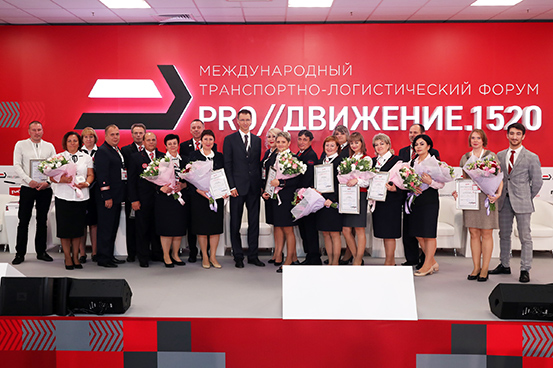
From 1 till 3 October 2018, the city of Sochi (Russia) hosted an International Transport and Logistics Forum “PRO//Movement.1520”. During the two days of the Forum’s business programme, 12 sessions and round tables were held, which were attended by 1,400people from 340 companies representing 17 countries, as well as from international transport organisations - OSJD Committee, OTIF, CCTT, UIC, FERRMED and others.
Opening of the forum
The opening ceremony and plenary session on 2 October were attended by the Minister of Transport of the Russian Federation Yevgeny Ditrikh, Governor of Krasnodar Kraj Veniamin Kondratyev, CEO and Chairman of the Board of the Russian Railways JSC Oleg Belozyerov, who, in their welcoming addresses, identified the main topics of the forum, revealed the long-term industry development programme and expressed their vision of the strategy and role of railways in the future transportation system. Social, highspeed, innovative - these three words were heard more often than others at the opening ceremony.
The Minister of Transport read out the welcoming address of Dmitry Medvedev, Chairman of the Government of the Russian Federation, in which the most important role of railways in the transport system of Russia was determined, as well as their high social significance.
On 2 October, the plenary session “PRO the Future of the World Transport System: Global Trends” was opened by Parag Hanna, Global Strategy Advisor, Founder and Managing Partner of the “FutureMap” company. Parag Hanna, who, according to the Esquire magazine, is among the 75 most influential people of the 21st century, gave a balanced assessment of the current trends in the global economy and trade correlated with the development of railway transport.
In his opinion, Europe is a zone of maximum volumes of trade. But the vector of economic production and trade is gradually shifting towards Asia, where such countries as China, India, the Republic of Korea and others become the largest players. Currently, trade turnover between Europe and Asia reaches 1.6 trillion dollars.
Another of the most important points noted by him was that the goods begin to flow not only from East to West, but also in the opposite direction - from West to East. As a result, after 10 years, the trade turnover between Europe and Asia should reach 2.5 trillion dollars.
The head of the Russian Railways JSC, Oleg Belozyerov, noted the key indicators of the company’s development programme, which, in particular, provide for achieving annual throughput rates of 180 million tons of goods on the BAM and Trans-Siberian railway lines by 2024. It is also planned to increase the capacity for container traffic, reducing the travel time of trains from East to West to 7 days. Finally, a global high-speed contour will be formed inside the country, within which, until 2024, the Moscow - Gorok- hovets branch should be commissioned, but the end point can be taken even further.
The second, strategic session, was devoted to financial issues: “PRO Infrastructure investment strategies: finding a balance between the interests of money and goods”. The topics related to competition issues of railways in relation to other modes of transport, efficiency of investments, and tools were proposed for discussion. Edvins Berzins, Chairman of the Board and President of the Latvian Railway SJSC, Alexader Misharin, First Deputy General Director of “Russian Railways” JSC, Senior Vice-President of VTB Bank PJSC Dmitry Snesar and others took part in its work.
The round table “PRO new speeds” was devoted to the consideration of the immediate prospects and strategic directions for the development of high-speed railway lines in Russia and in the whole world. “I must admit that the Russian Sapsan is superior to the German and French railways in terms of punctuality, it is at the level of the Japanese Shinkansen,” said Dietrich Möller, Head of the Regional Sales Department of Siemens Mobility. “In 2003, when the project started, it was hard to even imagine such a thing”. Now the company is working on a new generation of fast-speed train and is ready to offer it to Russia. “When creating a new train, the task was to reduce expenses and maintenance costs by an average of 20%, while increasing capacity and reducing weight by about 10%. Engineers have solved these problems.”
Alexander Misharin, First Deputy Director General of “Russian Railways” JSC, drew attention to the fact that the lack of transport links reaching a speed of 300 km/h is a competitive disadvantage of the entire transport system of Russia.” In assessing the financial efficiency of railway infrastructure projects, he noted, especially the high-speed railway lines, it is necessary to apply global methods. It is essential, for example, to take into account budget revenues from operating effects. The operational profitability of high-speed railway lines is within 70 to 80 percent.
On the agenda of the strategic session “PRO technology of the future: by what means we’ll carry the goods” were issues related to the real and immediate needs of the industry, with the requirements imposed by consumers on railway engineering, with the transition to digital technologies, the development of control systems aimed at improving safety and reliability of the transportation process.
According to the estimates, made on the basis of current trends and the programme of railways development until 2025, the industry will ensure the loading of production capacity of rolling stock with volumes of up to 600 locomotives and 5,000 wagons per year.
Alexey Sokolov, First Deputy Director General for Strategy and Product of SPC “UWC” (OSJD affiliated enterprise), dwelt on the introduction of innovative rolling stock, noting that “already now 60 percent of exported coal is transported by so-called innovative wagons”. Tests show that the “innovative wagon” is able to run at a speed of 105 kilometers per hour, and regardless of the load, both empty, and fully loaded.
Analogues - “non-innovative wagons”, which are in operation, can withstand speed modes of up to 90 km/h empty and only 60 km/h - with a maximum load. It is clear that these indicators do not correspond to the requirements of the industry development strategy.
The next important point of the first day programme was the signing of a number of documents within the Forum: the head of the Federal Railway Transport Agency Vladimir Chepets and the Director General of the “Northern Latitudinal Passage” LLC Sergey Sukhanov in the presence of Minister of Transport of the Russian Federation Yevgeny Ditrikh and the General Director of the Russian Railways JSC Oleg Belozyerov signed a concession agreement on the implementation of the construction project of the Northern Latitudinal Passage, a Memorandum of Understanding was signed with Japanese companies Mitsubishi Heavy Industries and Sojitz Corporation, with the representatives of EAEU railways an Agreement was concluded in the field of metrology, etc.
On 3 October in Sochi, the third day of the International Transport and Logistics Forum “PRO//Movement.1520”, a Day of Discussions took place. On the same day, the Second Passenger Forum, devoted to the development of international, inter-city and suburban passenger traffic, and the XXVII-th Plenary Session of CCTT began to discuss the current issues of the development of international freight traffic between Asia and Europe using the Trans-Siberian Railway.
Second Passenger Forum
Undoubtedly, this Forum aroused great interest among the representatives of the railway passenger sector not only from Russia, but also from many other OSJD member countries and observers, as it discussed the most urgent issues of railway passenger transportation, increasing their efficiency, attractiveness and competitiveness with a view not only to recover, but also to increase the passenger flow, the competition issues that carriers have to face, the role of marketing in the digital age and perspectives of ACS “Express”, the problems in the development of this segment of transport in the international traffic in the Eurasian space.
The event was attended by the representatives of the railway administrations of the Republic of Belarus, Republic of Kazakhstan, Kyrgyz Republic, Russian Federation, Republic of Uzbekistan, Republic of Tajikistan, Republic of Latvia, Republic of Finland, OSJD and UIC, as well as representatives of the scientific and expert community in the field of passenger transport.
The main topics of the session “PRO// Passengers. Passenger traffic today: range of problems, trends, goals” have become simplified procedures at border crossing points, increased occupancy of daytime express trains, speeding up passenger trains (Moscow - Adler in 16 hours) and others. The session provided an opportunity for its participants to identify the main problematical vectors in the development of the target model of the passenger transport market, made it possible to share their experience in developing the “1520 space” transportation under the conditions of reforms, discuss the main barriers in the organisation of international passenger traffic in the East-West communication, cooperation of railway carriers and the role of railway administrations.
Welcoming addresses and reports during the strategic session “Passenger traffic today: range of problems, trends, goals” were made by Director for Passenger Transportation of the Russian Railways JSC Dmitry Pegov (since December 2018 - Deputy Director General of the Russian Railways JSC), Chairman of Directorate of the Central Council for Railway Transport of the CIS member states Viktor Popov, General Director of FPC JSC Pyotr Ivanov; VR-Group Senior Vice-President Maysa Romanainen, Head of Passenger Service of Byelorussian Railway Alexander Zakharevich, Secretary of OSJD Committee Attila Kiss, Director of Passenger and Freight Transportation Department of LDZ Cargo Ltd. Eduards Cernavskis, UIC Coordinator for Standardisation and East-West Relations Vytautas Kinderis and others.
According to Dmitry Pegov, the main activities implemented by Russian Railways to improve the quality of service today are increasing the speed of passenger trains, updating rolling stock, developing electronic channels for selling travel documents, and providing multimodal passenger traffic.
“During the 8 years of operation of the “Sapsan” trains, there was a threefold increase in their passenger traffic flow, and the capacity of seats provided onboard those trains today is clearly insufficient to meet the demand. Therefore, it was decided to expand the fleet of highspeed trains for another 11 “Sapsan” trains,” noted Dmitry Pegov.
In order to maximize the use of the potential of the existing infrastructure, it is planned to increase the volume of traffic on the section Moscow - St. Petersburg to 16 pairs and to couple 9 pairs of trains. In the future, it is planned to increase the composition of all 27 trains to 11 coaches. Additionally, it is planned to launch 3 pairs of “Sapsan” trains on the section Moscow - Nizhny Novgorod.
One of the most popular passenger destinations today is the direction of North-West - Center - South. Therefore, the key strategic initiative of the Russian Railways Group is to accelerate and launch innovative trains in this area and develop infrastructure. The initiative provides for the acceleration of about 40 pairs of trains. By 2025, the time of trains run from Moscow to Adler is planned to be no more than 16 hours, whereas from St. Petersburg to Adler - 22 hours.
As Dmitry Pegov noted, “The reality shows that there is a strong competition available between railways and other modes. One of which is the road transport - it competes so powerfully both in terms of legislation and the provision of services - not always of high quality, but we need to respond to the situation.” And in this regard, the measures taken by the Russian Railways JSC on the basis of the objectives laid down in the development programme, lead to positive developments.
“Since the beginning of 2017 and during the whole year we, together with the Federal Passenger Company and suburban companies, have undertaken a number of efforts aimed at restoring passenger traffic. In general, it grew by 4.8%, in high-speed traffic the increase was 25%. Passengers return back from other modes of transport.” In international traffic, positive trends, unfortunately, have not been observed yet. At present, the Russian Railways JSC provides direct railway communication with 22 countries of Europe and Asia, and according to the last year’s results, passenger traffic decreased by 1.7%, having continued the trend of the recent years. Growth is observed in certain directions of Central Asia, but it is not enough to influence the entire volume of traffic. In this regard, Dmitry Pegov stressed, it was necessary to get actively involved into the work towards the implementation of the recommendations of UN Resolution No. 264 and the draft “Convention on the facilitation of border crossing procedures for passengers, luggage and load-luggage carried in international traffic by rail” which was prepared under the auspices of the UNECE ITC and OSJD and defines the main vectors in the activities of carriers and countries to ensure the people’s sustainable mobility by using the railway transport.
In the statement, made by the General Director of FPC JSC (OSJD observer) Pyotr Ivanov, it was noted that the Federal Passenger Company approved the concept of development until 2030, in which an important point is a balanced approach to solving commercial and social problems. “Development, quality improvement is important for us. The average age of the rolling stock is now 18 years, by 2025 it is necessary to reach 12.5 years, and the order will be 600 coaches a year,” said Pyotr Ivanov.
In his speech, Secretary of OSJD Committee Attila Kiss dwelt on the main directions in the OSJD activities towards the development of international passenger railway traffic, organisation of passenger trains and direct coaches in the OSJD space, facilitation of border crossing procedures, including the implementation of Resolution No. 264 of the UNECE ITC and the work on the draft “Convention on the facilitation of border crossing procedures for passengers, luggage and load-luggage carried in international traffic by rail”.
During the round table “PRO//Passengers. Meeting the client's needs: service, time, comfort” the main activities were considered for creating high-speed railway lines, the balance between social tasks and the economics of operating railways, the main directions in the development of the suburban passenger complex - integration with other modes of urban and suburban transport, digitization in the organisation of services’ provision, development of the positive experience of the Moscow Central Ring (MCR) under the conditions of existing “alternative” transport infrastructure and operation in the megapolis being already developed.
The official programme of the Forum was concluded by a round table: “PRO//Passengers. Railway by the passenger's eyes”, where participants were able to familiarize themselves with the results of various marketing researches in the 1520-mm gauge space, to learn how consumers of railway services evaluate their own needs.
In the course of the round tables “PRO// Technologies. The unified digital platform of the transport complex of Russia” and “PRO//techno- logical solutions: transport of the city, people” the issues were discussed relating to the digital transit, the introduction of IT innovations in transport and logistics - current developments to improve the efficiency and quality of service. The round tables was attended by Aleksey Sokolov, Deputy Minister of Digital Development, Communications and Mass Communications of the Russian Federation, Evgeny Tkachenko, Deputy Director for the Development Programmes and Head of the Information Technology Development Department of the Transport Complex of the Ministry of Transport of the Russian Federation, Evgeny Charkin, Director for Information Technologies of the Russian Railways JSC and many others.
In the framework of the second International Passenger Forum, the participants visited the Adler maintenance depot of the Southern Directorate for Fast-Speed Traffic, the railway station Adler, as well as got acquainted in practice with the new Siemens coaches running in the composition of the train Adler - Moscow.
In general, the “PRO//Movement.1520” forum showed that holding such events to organise a dialogue and exchange the experience was very important for the presentation of technological solutions that could radically change the usual model of passenger and freight transportation, find new mutually beneficial formats of interaction between different modes of transport , identify promising areas for the development of passenger and freight traffic, taking into account digitalization and the use of “green technologies”, as well as the possibility of financial institutions to participate in the large-scale infrastructure projects.
Joint OSJD/FIATA Workshop on combined transport “New opportunities for combined multimodal traffic between Europe - Asia - Europe”
(press-release)
The Workshop (11-12 July 2018, city of Istanbul, Turkey) was attended representatives from the OSJD member countries as follows: Azerbaijan, Belarus, Georgia, Kazakhstan, Latvia, Moldova, Poland, Ukraine and Czech Republic; Turkish State Railways (TCDD); OSJD affiliated enterprises: Sinotrans CJSC, SIGIS LLC, Association of Transport High Schools (RUT/ MIIT), Eurosib JSC, “UTLC ERA” JSC and PLASKE JSC; international organisations and associations: UNESCAP, WCO, CIT, UIRR, UIC, FIATA Secretariat; national associations of forwarders and operators, transport-logistics and forwarding companies from Austria, Azerbaijan, Belarus, Bulgaria, Vietnam, Italy, Kazakhstan, Russia, Slovakia, Turkey, Ukraine and Switzerland; OSJD Committee.
Ms. Zubaida Aspayeva, the Chairperson of OSJD Commission on freight traffic, Mr. Turgut Erkeskin, President of the UTIKAD, senior vice-President of the FIATA and Mr. Ivan Petrov, senior vice-President of the FIATA, opened the Workshop and made their welcome speeches to its participants. They underlined the relevance of the event to all the participants of the transportation process and stressed that for the purposes of a higher quality of services on the transport market the railways organise and apply various methods of international transportation of goods. The methods included the most promising ones, in particular development of combined (intermodal, multimodal) transportation in international traffic, where transport and logistics companies and associations accumulated great experience.
In the course of the Workshop, presentations were made and reports and statements were delivered by the representatives of the railways, international organisations, national associations of forwarders and transport-logistics companies on the following subjects:
- Session 1 - “Multimodality in the Eurasian transport connection” (subtopic: “Eurasian transport corridors: realities and prospects for development”, “Connections of Southern Corridor from Europe/Iran to China”);
- Session 2 - “Practice and prospects of combined and multimodal transport - vision of stakeholders of the transportation process and international organisations (subtopics: “Experience of international organisations in the field of development of combined and multimodal transport, “Combined and multimodal transportation in the communication between Europe - Asia - Europe: problematic issues and practical solutions”, “Interaction of railways undertakings with the operators of container trains, transport forwarding companies and national associations of forwarders”;
- Session 3 - “Facilitation of procedures for border crossing for combined and multimodal transport” (subtopics: “Interaction with Customs bodies; application of information technologies, electronic data interchange”, “Application of through documents for the entire supply chain”, “Advantages of application of OSJD documents (SMGS consignment note and CIM/SMGS consignment note)”, “Strategy for creation of effective logistics schemes, modern logistics solutions”;
- Session 4 - “Legal status of the Baku - Tbilisi - Kars railway main line, including the railways of Azerbaijan, Georgia, Kazakhstan and the Customs bodies” (subtopics: “Transport potential of the Silk Way from China, countries from the Southern, South-Western and South-Eastern Asia to the countries of Europe though the Caspian Sea and Black Sea”; “Interests of business and prospects of attraction of freight flows in the direction of Europe - Asia - Europe on the route through the Caspian and Black Seas”.
The Workshop participants conducted a discussion, exchanged their opinions in order to increase the effective use of railway transport in organisation of combined traffic in the Eurasian region, as a result of which they noted and recommended as follows:
- it was proposed to make practical use of the following:
- positive experience of the OSJD in planning and organisation of transportation of goods by container trains;
- legal instruments of the OSJD in the field of transport of goods with participation of maritime section of transportation (SMGS provisions);
- FIATA documents;
- transport relations must develop taking into account the following aspects:
- the global tendency of containerization of goods opens new opportunities of non-standard solutions for transportation in the direction of Europe - Asia - Europe and requires development and introduction of new technologies for the transportation process;
- to take into consideration the fact that new South transport corridors on the Silk Way: China - Europe and in the opposite direction have a great development potential. The do not compete one another but rather complement one another. New volumes of goods must be transported by rail but not by sea. Consequently, new markets of such countries will be connected with the trade routes in the communication with China - Europe as Azerbaijan, Georgia, Iran, Kazakhstan, Russia and the countries of the Black Sea and Mediterranean Sea region - Turkey, South-Eastern Europe, Italy and part of the Central Europe;
- application of new technologies for multimodal transport makes it possible to establish the most optimal logistics system as much as possible, guarantee the delivery and reduce the delivery time; increase the safety of goods and infrastructure; make the transport costs of the customer predictable;
- facilitation and improvement of procedures for State border crossing will significantly improve the level of interoperability, reduce the barriers for trade and it makes it possible to provide the efficiency of commercial operations,
- the following measures are recommended for the development of the integrated Eurasian transport and logistics system:
- to introduce the information data exchange system for the facilitation of procedures for international trade and logistics, which must be based on the compatibility principle of the information systems of different State agencies and economic entities, harmonization of data parameters (creation of common classifiers), modeling of information exchange processes with the application of codes of the OSJD Harmonized Nomenclature of Goods (GNG);
- to develop and apply the innovative technologies for the organisation of transport processes based on the “Single Window” principle;
- to facilitate the Customs procedures and harmonize them with technological processes of transportation for border crossing purposes by means of new requirements for electronic Customs control to be adopted at National level, which are promoted by the World Customs Organisation (WCO) and also apply the railway SMGS and CIM/SMGS consignment notes and their electronic versions as a Customs declaration;
- to strengthen the interaction between the railway companies and international organisations engaged in the issues of railway transport with the State control agencies (Customs, Border control, Quarantine), transport-logistics and forwarding companies for the facilitation of border crossing procedures;
- to continue the work aimed at the introduction of the CIM/SMGS consignment note and its electronic version to increase the effectiveness of railway transportation in the Eurasian railway region;
- to support measures for the facilitation of border crossing procedures for goods and reduction of handling time of freight trains on the border crossing points, which were developed within the OSJD;
- to complete the introduction of regional infrastructure projects for the purpose of simplification of transport services and their higher efficiency.
“Transcaspian/Translogistica-2018” exhibition in Baku
On 11 June 2018, the official opening ceremony of the XVII-th Caspian International Exhibition “Transport, Transit and Logistics” (Transcaspian/Translogistica-2018) and the VIII-th Caspian International Exhibition “Road Infrastructure and Public Transport” (Road & Traffic) took place at the Expo Center in the capital of the Republic of Azerbaijan - the city of Baku.
At the exhibition this year, together with the AZERBAIJANI RAILWAYS CJSC, the Company’s subsidiaries - “ADY Express” and “ADY Container” were also represented.
The exhibition “TransCaspian/Transl- ogistica” is one of the leading transport events of the Caspian region. At this year’s exposition stand of AZERBAIJANI RAILWAYS CJSC it was possible to get acquainted with grandiose railway development projects, such as the Trans-Caspian International Transport Route, the North-South and West-South International Transport Corridors, the infrastructure projects of Baku - Tbilisi - Kars and Astara (Azerbaijan) - Astara (Iran).
The busy business programme of the exhibition also included bilateral business meetings – B2B, in which employees of the railways, including domestic and foreign experts, took part. The purpose of the B2B event is to offer participants an opportunity to meet with leading local companies to present and demonstrate new products and services, explore new business opportunities, find potential customers and exchange business experiences.
During the meetings and negotiations, the employees of the AZERBAIJANI RAILWAYS, “ADY Express” and “ADY Container” presented information on transit routes passing through Azerbaijan, which is a connecting link between Asia and Europe.
At the XVII-th Caspian International Exhibition “Transport, Transit and Logistics” (Transcaspian/Translogistica) and VIII Caspian International Exhibition "Road Infrastructure and Public Transport" (Road & Traffic) the stand of the AZERBAIJANI RAILWAYS CJSC won the first place.
The exhibition "Transcaspian/Translogis- tica-2018" continued its work for 3 days from 11 through 13 June at the Baku Expo Center. This year 85 companies from 20 countries took part in the exhibition. The exhibition presented a wide range of products and services in the transport sector.
Forum “1520 Strategic Partnership: Central Europe”
On 20-22February 2018, an international railway business forum “Strategic Partnership 1520: Central Europe” took place in Vienna, which was attended by 415 delegates from 29 countries, as well as from the international organisations: OSJD, CCTT, FERRMED, etc. The forum was hosted by the Business Dialogue Company with the support of the Ministry of Transport, Innovation and Technology of the Austrian Republic, Ministry of Transport of the Russian Federation, OBB Holding AG, Russian Railways JSC, UTLC JSC andPJSC TransContainer (OSJD affiliated enterprises), as well as the VTB Bank.
The increased attention of the media and the public to this event was attracted by the fact that this forum was held in Austria for the first time and that among the participants there were high-ranking leaders of the railway and transport industry of of many countries. The Minister of Transport of the Russian Federation Maxim Sokolov, Minister of Transport, Innovation and Technology of the Republic of Austria Norbert Hofer, Deputy Minister of Transport, Innovation and Technology of the Republic of Austria Gerhard Gürtlich, General Director and Chairman of the Board of the Russian Railways Oleg Belozyerov, General Director of the ÖBB -Holding AG Andreas Matthä, Chairman of CJSC “Azerbaijani Railways" Javid Gurbanov, Head of the Byelorussian Railway Vladimir Morozov, General Director and Chairman of the Board of “Georgian Railway” JSC David Peradze, Director General of Lithuanian Railways JSC Mantas Bartuska, Chairman of the Board and General Director of ZSSK Cargo Martin Vozar, General Director of Federal Passenger Company JSC (FPC, OSJD observer) Petr Ivanov and many other leaders of railway transport companies, international organisations, banking institutions, etc.
The expectations of numerous journalists from various countries have been justified - the speeches and presentations of 57 speakers contained a lot of specific information related to the development of international railway services between China and European countries, to the extension of the 1520-mm gauge track from Kosice to Bratislava and Vienna, to the implementation of the “New Silk Road” and “One Belt - One Road” initiatives and many others. The culmination of the forum was reached when heads of the Russian and Austrian railways signed a supplement to the cooperation agreement between the Russian Railways JSC and the Austrian Federal Railways (Österreichische Bundesbahnen AG, ÖBB). The document updated the cooperation agreement dated 19 May 2011.
In addition to this document the following agreements and memoranda have been signed:
- Memorandum on cooperation to study the possibility of owning shares of the joint venture was signed by PJSC TransContainer and Rail Cargo Austria AG.
- Agreement between Rail Cargo Austria AG and UTLC JSC on cooperation in the development of container transit between China and Europe (a joint initiative is directed to form a new-quality transport service on the Eurasian railway space, and the key enabling condition is the formation of a sustainable technological, information and service platform interaction of all participants in order to switch freight flows in the China-EU traffic onto the railway transport);
- Memorandum of Understanding for the creation of a joint transport product in the framework of the multi-modal transport project in the China-Europe traffic, signed between UTLC JSC, Kaliningrad Railway (a branch of RZD) and Kaliningrad Commercial Sea Port JSC;
- Memorandum of Understanding for the establishment of a joint transport product in the framework of the multi-modal transport project in the China-Europe traffic between UTLC JSC, Kaliningrad Railway and the Baltic Stevedoring LLC.
Special stress was laid on the meeting between Maxim Sokolov and the Minister of Transport, Innovation and Technology of the Republic of Austria, Norbert Hofer, held on 21 February, at which the ways for cooperation development were discussed to improve the transport links between the two countries, as well as the prospects for the construction of a 1520-mm gauge railway line to Vienna to be commissioned by 2033. Norbert Hofer, in particular, noted that the construction completion of the line is anticipated in 2033. “We first do the design work, then we come to a conclusion that this is environmental-friendly. I hope that in a few years this process will be completed. We want to put this railway into operation in 2033”.
“The idea of extending the 1520-mm track into the center of Europe seems not just reasonable, but objectively necessary in a competition with other modes of transport, - stressed Maxim Sokolov in his speech during the forum opening ceremony. - The common interest and the desire for partnership convince of the importance of the issues raised at the forum, the effective solution of which guarantees a stable and balanced development of the economies of our countries.”
The financial issues for the constructing a railway line with a track gauge of 1520 mm, including the participation of Austria and Russia, are still open. However, for Austria this project will pay off several times, said Norbert Hofer to the journalist. The Minister of Transport of the Russian Federation Maxim Sokolov and the General Director of the Russian Railways JSC Oleg Belozyerov have stressed the strategic importance of the railway corridor. They have also expressed their hope that the internationally known investors as well as world banks and pension funds will render their support in financing the project. It is believed that there will also be support from the part of Asian investors.
Both countries lay serious hopes for the implementation of this project. The new Austrian government sees the “broad gauge” as one of the transport routes of the “New Silk Road” initiative, which should link railway networks to accelerate freight railway traffic with China and which is also part of the new Austrian government programme.
Speaking at the opening ceremony of the forum, Minister of Transport of the Russian Federation Maxim Sokolov stressed that one of the key challenges of today is the infrastructure development to the level when the transport communication in the Eurasian space is organised and carried out without barriers and technological limits, and the delivery time of goods from Asia to Europe by rail becomes only several days.
“Undoubtedly, the railways face tough competition from the part of all types of transport - sea, road and air, - the Minister said. - I believe that one of the goals of this forum should be the development of an agreed strategic vision for the implementation of all competitive advantages of railway transport in comparison with alternative modes of transport”. “Delivery of goods in the Eurasian railway traffic is the most optimal: it wins in a completion with the sea transport in speed and lack of seasonal and weather restrictions, and with air carriers - in price and carrying capacity.” This is confirmed by the fact that today the transit service by railway is in a high demand among the consignors in Europe and Asia. For example, there is an increase in transit container traffic through the territory of Russia in 2016 - 2017 by 60% - up to 415 thousand TEUs. Such a tendency has been provided mainly due to the growth of container traffic in the direction from East to West - for the past five years its volume has increased by 13 times.
Basing on the assessment of the prospects for the development of mutual trade between the countries of Europe and Asia, Maxim Sokolov considered it absolutely realistic to achieve the possible railway transit volume of 1 million TEUs in the next few years.
The development of international transport corridors, creation of new efficient routes for the delivery of goods, work for the modernization of railway border crossing points and an increase in their throughput capacity will contribute to tackle this task.
The Minister of Transport named the key aspects in the development of transport systems in the world, namely increasing the speed of movement and wide-spreading the use of innovative technologies. To date, the optimization of transportation conditions has made it possible ensure an average speed of goods delivery on the route Asia - Europe through the territory of Russia at a level of 1000 km per day with a possible provision of further growth. However, in current conditions even this level of speed would not be sufficient to ensure an effective competition with other modes. Today, aviation carries more volumes of high-yielding cargoes than railways in the Europe-Asia traffic, despite a higher tariff which is on average five times more.
“We expect railways to offer breakthrough solutions in the field of logistics business, including the transportation of goods from China to Europe using high-speed railway lines. The promotion of the project to create a “Eurasia” high-speed freight and passenger railway corridor meets a wide range of objectives outlined by the government.”
Along with the progress in the transit potential of the Eurasian Economic Union, a balanced social and economic development is ensured throughout the Eurasian space. The project will complete the contours of the transport systems of Russia, the countries of Asia and the European Union and form the largest international network of the high-speed lines with the length of more than 50 thousand km. This will radically change the structure of transcontinental transport and increase the competitiveness of railway transport.
As a result, the goods from China to Europe can be delivered in about 3 days, whereas at present it takes 12-14 days by land and more than 35 days - by sea. The goods transit volumes from China to Europe, according to the preliminary estimates, can be increased by 5 times.
Special attention should be paid to the construction of a railway line with a gauge of 1520 mm to Bratislava and Vienna. Due to the elimination of the need for the goods transshipment at the stations located on the intersection of the ‘Russian’ and ‘European’ gauges, the competitiveness of logistics solutions for the delivery of goods between the countries of the Asian-Pacific Region and Central Europe will be enhanced. The anticipated volume of transportation along the new corridor, according to the preliminary feasibility study, is supposed to rise from 16 to 24 million tons per year, depending on the scenario.
Along with the technological harmonization of the important component of the project, Maxim Sokolov called the formation of a ‘seamless’ or a simplified procedure for crossing the state borders through where the new corridor will pass. As it is well known, even small delays enroute can diminish the technological effects of the project and complicate the situation for the consignors.
Focusing on the current trends in the development of the global economy and trade, the Minister drew the attention of the forum participants to the fact that the volume of Eurasian transit is going to increase in any case. The only question is which place in this very promising segment of the logistics business will be occupied by the railway.
The plenary discussion “’Eurasia’ Corridor and New Silk Road. Moving Towards Each”, which began after the opening ceremony, was focused on the opportunities aimed to improve the speed and quality of railway transit traffic on the East-West route, ways to ensure the national projects and initiatives match each other, as well as on what railways are ready to offer to meet the growing demand for freight traffic and ways attracting new volumes of goods on the East-West route.
Opening the plenary discussion, Oleg Belozyerov, General Director of the Russian Railways JSC, noted that the implementation of global logistics projects is key to the successful development of the economy. “The initiative to create the New Silk Road, a corridor for the supply of goods from Asia to the EU, is extremely important. The geography of this initiative is impressive: almost 70% of the world’s population is in the gravitational zone of the project, which is about 60% of the world’s gross product,” he underlined.
According to Andreas Matthä, General Director of ÖBB-Holding AG, the project of building a ‘broad’ gauge to Bratislava and Vienna is supported by the Government of the Republic of Austria. “The ‘broad-gauge’ project is extremely important for Austria. The project is personally supported by the Minister of Transport, Innovation and Technology of Austria Norbert Hofer. If this project is implemented, it will provide jobs for four future generations,” - added Andreas Matthä.
According to Keir Fitch, Head of Railway Safety and Interoperability of the European Commission, technical standards cannot become an obstacle for the implementation of the project to extend the Trans-Siberian railway with a ‘broad’ gauge from Slovakia to Austria. “Technical standards cannot be barriers, because this wide-gauge standard already exists in the Baltic countries,” - added Keir Fitch.
In his speech Alexander Mis- harin, First Deputy Director General of the Russian Railways JSC and General Director of the High-Speed Railways JSC, noted that the ecological performance of railway transport makes it possible to create a qualitatively new environment being free from harmful emissions and negative influence. “The speed of delivery is our advantage. It is also added by efficiency, prime costs, safety, social significance, the most important environmental issues, and this means the competitiveness of railway transport,” - he stressed. Strengthening business cooperation with Austrian Railways also makes us confident while looking into the future. “Once again we strengthened our cooperation, we got to know each other more closely and outlined our new goals and objectives,” - Alexander Misharin added.
The presentation of Igbal Guseynov, Deputy Chairman of Azerbaijani Railways, was devoted to the great importance of the forum for expanding the strategic partnership. He noted that the Azerbaijan’s location at the junction of Europe and Asia provides for its active participation in the implementation of international projects for the development of the transport corridors “North - South”, “South - West” and “East - West”. The opening of the Baku - Tbilisi - Kars railway line in October 2017, as well as the construction completion of the Astara (Azerbaijan) - Astara (Iran) railway line, the official opening of which with the participation of the presidents of the two countries is scheduled for May 2018, have been the key events in the implementation of this task.
Speaking about the development of transit rail transport between Europe and Asia, the Head of the Byelorussian Railway Vladimir Morozov noted that at present the goods passing through the territory of the Republic of Belarus by rail, are delivered from 36 Chinese cities to 35 cities of Europe. The volume of transportation has reached 2700 trains a year, and their daily speed increased to 1100-1400 km per day.
In the opinion of Vladimir Morozov, in order to further develop the transportation on the East- West-East route it is necessary to further regulate improve the tariff adjustment and container transportation technologies, improve the infrastructure and logistics complex, broaden the unified CIM/SMGS consignment note geography, and modernise and renew the rolling stock.
Speaking during the session “Eurasian Logistics. Monetization of Distances”, Vice President for Development of “KTZ” JSC Mak- sat Kabashev informed about the priority development directions of the transport and logistics complex of Kazakhstan and dwelt on the measures aimed at the development of multimodal logistics in freight traffic, implementation of “Digital Railway” project, the provision of a barrier-free transport environment.
The basic point in the formation of transcontinental service through the territory of Kazakhstan is the logistics assets in the port of Lianyungang. Regular train services from/to Kazakhstan via Dry Port to the free economic zone of “Khorgos-Eastern Gate” on the Kazakhstan-Chinese border have been organised, which is a consolidating and distribution point for transit cargo flows through Kazakhstan, including those carried in the direction of Europe.
An additional impetus for the traffic growth in the East-West communication was given by the entry in 2017 by the international shipping company COSCO and the port of Lianyungang into the capital of the Dry Port in the territory of the Free Economic Zone “Khorgos - Eastern Gate”. This strategic partnership is a catalyst for increasing traffic volumes, attracting new customers and investments.
“In order to develop the East-West corridor, we set the task to bring the speed of transit container trains in the China-Europe traffic to the level of at least 1150 km per day, improve the handling processes of containers and minimize the time at Dostyk and Altynkol stations,” - stressed Maksat Kabashev.
Vice President for Development of KTZ NC JSC emphasised that in order to further increase the volumes of transit traffic in the East-West communication, in the conditions of strong competition with sea transport and meeting the increasing requirements of customers for the service level, it is necessary to intensify joint efforts in a number of directions. In particular, it is necessary to increase the speed of trains on the entire route from the point of departure to the destination point not less than 1200 km per day or more, to increase the efficiency of the use of fitting flat wagons and containers, to increase the throughput of border crossing points on the border with Europe, to increase the freight volumes delivered in the opposite direction of Europe - China, as well as to develop the transport of goods using paperless technologies.
Some sessions of the Forum were devoted to the problems of international logistics, financing and construction of the railway infrastructure, improving the technological interoperability of 1520 and 1435-mm systems.
The business programme of the second day of the International Railway Business Forum was opened by the session “Interoperability between 1520 and 1435. How to Transcend the Boundaries”, where the participants discussed the factors ensuring the growth of traffic volumes and the growth of efficiency in railway transportation, as well as the technologies that determine the vector in the industry development.
In the opinion of Gennady Bessonov, CCTT Secretary General, who was moderator of the discussion, at the moment there are no established technologies for cooperation that would allow a dramatic increase in the traffic volumes.
“With the opportunity and the desire to develop, we must be ahead for several years of the state of economy existing at the moment.”
In his presentation during the session, the Secretary of the OSJD Committee Attila Kiss spoke about the large-scale activities carried out by the Organisation for Cooperation between Railways in order to expand and improve the international railway traffic between Asia and Europe. Particular attention was paid to the OSJD’s cooperation with the European Union Agency for Railways (ERA), which is engaged in the development of technical and operational compatibility of 1520 and 1435-mm railway gauge networks and exchanges information with OSJD. Participants in the Conference were informed about the results of the Memorandum of Cooperation, which was first signed in 2007. Further on, the results of the joint work of the two organisations until 2018, as well as plans for the year 2019 were presented basing on a new long-term Memorandum of Cooperation, which was signed between the parties in 2013.
Speaking about the performance and scope of the Lithuanian Railways, the General Director of the Lithuanian Railways JSC Mantas Bartuska noted the need to use potential capacities and to develop the infrastructure. “E-commerce and new IT-technologies are changing the industry. Railways need to adapt to this trend and provide faster and more efficient transportation services. There are enough resources available, and we just need to use them appropriately,” - said Mantas Bartuska.
The key topic of the session “Road of Development. Socio-Economic Aspects” became the role of railways in the context of the European and global economy. During the discussion, experts exchanged their opinions in regard to the technologies and practices that reduce the negative impact on the environment.
Alexander Misharin, First Deputy General Director of Russian Railways JSC and General Director of High-Speed Railways JSC, noted that today railways can offer high speed not only for the passenger but also for the freight traffic. Speaking about the Bratislava-Vienna broad gauge project, he said: “This is a uni form technology that will allow us not only to strengthen the transport system, but also create new jobs, improve the environment, introduce innovative products and help create a unified Eurasian space.”
According to Christian Helmenstein, Chief Economist of the Federation of Austrian Industries, the railways today give impetus to the digitalization and application of new technologies. “The high-level incomes that we receive today result from the availability of the railway infrastructure. But it is necessary to take into account that the higher is the economic growth, the more railways we need.”
Summing up the results of the forum, Clemens Foerst, Spokesman of the Board of the Rail Cargo Austria AG noted that the economic belt “Silk Road” and the extension of the ‘wide gauge’ to Kosice-Vienna cannot be regarded as two independent projects. “This is a common project, which deals with the activation of railway transport in Eurasia,” he said, adding that Rail Cargo Austria AG welcomes the expansion of this infrastructure project and is ready to take on an active role in its promoting.
The “1520 Strategic Partnership” is an international business forum designed to facilitate the exchange of views and coordinate the efforts applied by the participants of the Eurasian transport market to form an integral infrastructure of international transport corridors and create the most comfortable environment for the movement of passengers and goods.
The “Belt & Road” Forum in Tbilisi

The Tbilisi “Belt & Road” Forum, held from 28 till 29 November 2017 under the patronage of the Prime Minister of Georgia Georgy Kvirikashvili, was attended by official delegations from 34 countries and about 2,000 delegates from more than 60 countries. The Prime Ministers of Ukraine and Moldova, the Vice Prime Ministers of some countries, other high-ranking officials and representatives of the diplomatic corps and international organisations (including the European Union, EBRD, ADB, European Investment Bank, WTO, the Gulf Cooperation Council, the Universal Postal Union, OSJD, OTIF, WCO, Telecommunications Development Bureau, etc.), representatives of local and international business circles and mass media. During the Forum, dozens of bilateral meetings took place, including high-level political figures, representatives of the Georgian Government and the private sector. At the forum the OSJD Committee was represented by Attila Kiss, Secretary of OSJD Committee.
The main attention during the panel discussions of the Tbilisi Forum was paid to the importance of the “One Belt - One Road” initiative. When addressing the meeting participants, the political leaders, representatives of the private sector of Georgia and international organisations pointed out to the fact that Georgia is gradually becoming a transport, investment, logistics and service center of the entire region.
In his speech, Ukrainian Prime Minister Vladimir Grois- man emphasised the role which belongs to the development of the corridor between East and West: “There are significant directions between Asia and Europe, as well as the Baltic states. In this respect, Ukraine can be a reliable partner. As Georgian Prime Minister Georgy Kvirikashvili stated earlier, we can create a real alliance of Georgia, Azerbaijan and Ukraine by providing railway and ferry services”.
Prime Minister of the Republic of Moldova Pavel Filip spoke about the need to strengthen further cooperation between the countries of the region for the development of the Silk Road and to achieve economic goals. The “One Belt - One Road” Initiative can be an effective mechanism in terms of achieving our common aspirations and globalizing the economy, which will allow us to fulfill the tasks set”, Pavel Filip said.
Deputy Prime Minister and Minister of Foreign Affairs of the Republic of Slovenia Karl Erjavec spoke about the role of Georgia in the implementation of the “One Belt - One Road” initiative. As Karl Erjavec said, “Slovenia plans to work closely with Georgia. Slovenia and Georgia have much in common. We have excellent relations with Georgia, and I believe that our economic cooperation will expand”.
Within the framework of the Forum, the following ten panel discussions were held:
- “Dialogue at a high level within the framework of the “One Belt - One Road” initiative - connectivity for stability”);
- “Trade Facilitation under the “One Belt - One Road” Initiative” - “Trade Facilitation” (Session I), “E-commerce” and “Transport Infrastructure” (Session II);
- “Energetics - trans-regional opportunities (oil, gas and electrical power)", “Digital connectivity”, “New opportunities”;
- “Using investment opportunities”: “Investment and trade opportunities in Georgia” (Session I), “Georgia as a regional center for global investments” (Session II);
- “CAREC 2030: connecting the region to a joint and sustainable development”.
At the Tbilisi “Belt & Road” Forum Delegates from the Government of Georgia presented information to the guests of the Forum concerning the economic situation in Georgia, including the business climate, investment environment, transit capacities, trade features, energy resources, customs and tax systems, tourism opportunities, etc. Particular attention was paid to the need to strengthen further cooperation between the countries.
At the same time, the Tbilisi “Belt & Road” Forum has become a platform for signing several extremely important documents:
- Memorandum of Understanding between Georgia and the People’s Republic of China on cooperation for the development of economic zones and the promotion of industrial development, which is aimed at further development of economic and trade relations through cooperation in the areas of trade, investment and improved production opportunities, as well as the creation of platforms for cooperation between enterprises and the strengthening of industrial clusters.
The Memorandum of Cooperation was also signed between the representatives of the Baku International Sea Trade Port, the Kazakhstan port of Kuryk and the Director General of the Anaklia Development Consortium, which should contribute to the development of the trans-Caspian corridor and the creation of competitive conditions for freight traffic after the construction of the Anaklia port is completed.
On 28 November 2017, a subsidiary of Georgian Railways JSC - GR Logistics and Terminals - signed a Memorandum on Cooperation with a subsidiary of the Chinese Railways - the International Transport Multimodal Company CRIMT, as well as with the Lianyungang New Silk Road International Container Development company.
These Memoranda of Cooperation will facilitate to deepen the relations between the companies, create joint working groups and increase transit flows from China to Turkey, Europe and Ukraine through Georgia and through the trans-Caspian corridors. They will also contribute to the rapid development of the country’s transit capacities.
On 29 November three important financial documents were signed. The European Investment Bank (EIB) and the European Investment Fund (EIF), which are jointly recognized as the EIB Group, signed three agreements with Georgian banks to provide loans in excess of 90 million euros to assist small and medium-sized enterprises in Georgia.
Railway Economic Forum in Krakow
(press-release)
On 12 September 2017 the city of Krakow (Poland) hosted the I-st Railway Economic Forum attended by the representatives of OSJD railways from Azerbaijan, Georgia, Iran, Kazakhstan, Poland and Ukraine. The main idea of the Forum was to discuss strategic directions for the development of the new transport corridor, as well as cooperation in the development of the New Silk Road.
Creation of a new transport corridor opens up broad prospects for the development of rail services and the organisation of container freight traffic from India and the countries of the Persian Gulf through Iran, Azerbaijan, Georgia, Ukraine and Poland to the EU countries and back.
The main objective of the Forum was to create a platform for the discussion and coordination of mutual strategy.
The opening ceremony of the Forum was attended by Tomasz Buczyński, Director of Railway Department, Ministry of Infrastructure and Construction of the Republic of Poland, Krzysztof Maminski, Chairman of the Board of PKP JSC and Zbigniew Tracichleb, Chairman of the Board of PKP LHS LLC.
Murad Alkhazov, Head of the Department for Business Development and Marketing of ADY Express - part of AZD CJSC, as well as representatives of the Georgian Railway JSC, Railway of IRI, Ukrzaliznytsia PJSC, Euroterminal Slawkow and WEST Trade S.A., the TOR Economic Advisory Group, and the OSJD Committee participated in the discussion devoted to the potential for the development of intermodal railway traffic on the route Central Asia - Central Europe and to the prospects for the importers and exporters.
A technical visit was organised for the participants of the Forum to the Euroterminal in Slawkow and the station of Slawkow LHS, where they had a possibility to inspect the operation of these transport and logistics facilities.
The forum confirmed its relevance and high interest in the issues discussed within its frameworks, giving a new impetus to the development of cooperation in organising railway transport between Asia and Europe.
International Transport and Ecology Conference “Sustainable Development Goals of Transport and Peace”
On 12-13 April 2017, the First International Transport and Environmental Conference “Sustainable Development Goals of Transport and Peace” was held in the UN Palais des Nations in Geneva, which brought together guests and participants from more than 30 countries. The event was organised by the International Association of World Foundations and the Organising Committee of the International Transport Award “Golden Chariot”, with the support of the OSJD Committee. It is symbolic that the opening of the Forum coincided with the International Cosmonautics Day. The moment when all present delegates were congratulated by the Russian cosmonauts working on the orbit, became a culmination peak of the Conference opening. The main topics that were discussed during the Forum were as follows:
- Innovative technologies in solving environmental problems today and tomorrow as an important tool in implementing the goals of sustainable development of transport and peace;
- Environmental initiatives and programmes of industry organisations. Research and innovation: how to make transportation more environmentally friendly? Best practices (examples of innovative implementation, reduction of costs and emissions of harmful substances into the atmosphere);
- Development of IT-technologies as a factor to reduce operating costs and reduce the impact on the environment. Advanced technologies in realizing the goals of sustainable development in transport. Particular attention was attracted by the following reports and presentations:
- “OSJD activities aimed at the development of international railway services between Europe and Asia” (Deputy Chairman of OSJD Committee Viktor Zhukov);
- “The Strength of Sustainable Air Cargo Transport: Environment and Global Trade” (Vladimir Zubkov, Secretary-General of the International Air Cargo Association, TIACA);
- “Machine-building and environmental challenges” (Aurora Engineering s.r.o.);
- “The role of the unified railway CIM/SMGS consignment note in improving the efficiency of international railway transport and the development of an electronic version based on it” (CIT Secretary General Erik Evtimov);
- “Towards the Eurasian perspective. How to increase the economic efficiency on land transport in the EU with an increase in the level of environmental protection and in the implementation of FERRMED standards” (Juan Amoroz, President of FERRMED);
- “ECO logistics for our future” (CFM Intermodal, Luxembourg);
- “Environmental education in the implementation of sustainable transport systems
development strategy” (rector of MIIT Boris Levin, Vice-Rector of MIIT for International Educational Programmes - Director of the Institute of International Transport Communications I.V. Karapetyants);
- “UIC activities aimed at achieving the of sustainable transport development goals in the railway sector” (Paul Veron, Head of Relations with UIC Members and Partner Organisations);
- “Sustainable innovation through the lens of the freight forwarder” (Anna Sandretto, Chairperson of FIATA ABIT);
- “Development of railway transport in China” (Ning Bin, Rector of Beijing Jiaotong Railway University);
- “Railway transport changing people’s life style and keeping environment better” (Weiping Yu, Deputy President, CRRC Corporation Limited),
- “Forum of the Cities of the New Silk Road: tasks and objectives” (Eugenio Novario and Ernest Sultanov, Forum of Cities of the New Silk Road);
- “Development of a strategic approach to sustainable development of “Ukrzaliznytsya PJSC” (Zeljko Marchek, Member of the Board);
- “BRICS’s innovations in sustainable development transportation. An overview of the policies and technologies implemented by these countries and regulations around them” (Rodrigo Dora, CEO BRICS-PED Arbitration Chamber), and others.
The conference was attended by the representatives of government authorities, UN staff and experts, leaders of world transport associations, such as OSJD, TIACA, UIC, CCTT, FERRMED Non-Profit Association, CIT, IRU, FIATA, BRICS, Association of Transport High Schools (OSJD affiliated enterprise), represented by the delegation of MIIT, the Beijing Jiaotong Railway Institute and other institutions, the leaders of major global industry companies from China, Poland, Russia, Ukraine and the Czech Republic. At the end of the conference, a solemn ceremony was held to reward the world’s best transport companies and organisations with the Golden Chariot award. The honoured awards were received by:
- Australia – ADGEX Limited in the nomination “For the achievements in the field of sustainable environmental development”;
- Brazil – METRO DF in the nomination “National Transport Company of the Year”;
- Georgia – TV and radio company TRIALETI in the nomination “Popularisation of the transport industry in media”;
- India – Kale Logistics in the nomination “Project of the Year”;
- Italy – “Forum of the Cities of the New Silk Road” in the nomination “For Strengthening International Relations in Transport”;
- Canada – Stanley Wright, President and CEO S.A.S.I. in the nomination “For personal contribution to the development of the transport industry”;
- China - CRRC company in the nomination “Best railway company”;
- Luxembourg – CFL Multimodal S.A. in the nomination “For the achievements in the field of logistics services”;
- Mali – Sadio Baba Invest Ltd. in the nomination “Most effective investment in the transport sector”;
- Mongolia - IFFC - International Freight Forwarding Center of Ulan-Bator Railway JSC (member of OSJD) in the nomination “For the achievements in the field of logistics services”;
- Poland - Tines JSC (OSJD affiliated enterprise) in the nomination “For the achievements in the field of transport construction”;
- Russia - Moscow State University of Railways (MIIT) “For the achievements in transport science and education”;
- Ukraine – Ukrzaliznytsya PJSC (member of OSJD) in the nomination “Best railway company”;
- Croatia – “EKOmobilis” in the nomination “For the innovative achievements in the field of navigation support for the transport industry”;
- Czech Republic – “Aurora Engineering” in the nomination “The company of the year in the sphere of small and medium business”. The merits of the member of the Presidium, TIACA Secretary General Vladimir Zubkov were noted with the “Golden Chariot” prize and the Honorary Diploma in the nomination “For Strengthening International Relations in Transport”, as well.
It is especially worth noting that the International Conference “Sustainable Development Goals of Transport and Peace” and the ceremony of awarding the “Golden Chariot” prize held in Geneva became a forum in the field of transport and ecology that brought together representatives of almost all segments of the transport industry, which was repeatedly mentioned by the conference participants.
Following the results of the conference, the participants adopted a draft Resolution, including a number of proposals to be addressed to the UN Secretary-General Antonia Guterres, to include:
- on the implementation of a joint programme to achieve the sustainable development goals in transport, with the participation and with the support of non-governmental international industry associations and organisations;
- on the possible inclusion of the “International Day of Transport Sustainable Development” into the List of official United Nations holidays.
A historical event in Kazakhstan: EXPO-2017
In November 2016, , a press tour was organised with the support of the CIS Executive Committee for the leading journalists of Azerbaijan, Belarus, Georgia, Kazakhstan, Russia, Uzbekistan and Ukraine to the capital of the Republic of Kazakhstan timed with an outstanding event in life of the country and the international community - the International Exhibition “EXPO-2017” which is scheduled for 10 June -10 September 2017.
The objects being constructed especially for this event had been shown for two days for the media representatives in a winterly beautiful Astana.
On 21 November a press conference with Akhmetzhan Esimov, Chairman of the Board of “Astana EXPO-2017 NC” JSC was held for the journalists. In particular, the journalists were delivered information about the role of the exhibition company in collaboration with the member countries, the capacities of the transport complex of the Republic of Kazakhstan, readiness of the city infrastructure for the event, safety issues during the exhibition, use of new technologies in the construction of exhibition buildings and hotels to accommodate the visitors.
Specialists of the exhibition company believe for the first time will take place in Kazakhstan is of synergic effect for the country. In particular it will promote the development of the country and its capital, facilitate tourism into Kazakhstan, attract more investments, provide an experience exchange of leading experts and government officials and more active integration of Kazakhstan into the single Euroasian community.
It is planned that representatives from about 100 countries will participate in the EXPO-2017 exhibition and it will be visited by nearly 5 million people.
“Energy of the Future” will become a keynote of the EXPO-2017 international exhibition. The power is one of the main components of the modern world economy. A perspective direction in this field today is the “green energy economy”, which means technologies for the energy production from renewable energy sources (RES). The “green power” is inseparably linked with the ecology. Unlike traditional sources, like, for example, hydrocarbons, use of RES doesn’t produce any negative impact on the environment.
In this context energy-efficient and eco-friendly transport is of great importance, in particular railways being the most “environmental friendly”. held in Astana is one of the most important projects for Kazakhstan. The initiative to organise such an enormous event in the country’s capital belongs to President of the Republic of Kazakhstan Nursultan Nazarbayev.
Thanks to the support from the part of the President and the Government of the Republic of Kazakhstan, the project of the preparation for the exhibition promptly and successfully moves ahead. A huge amount of work has been performed for the past two years after a decision was taken to organise EXPO-2017 in Astana: the “Astana EXPO-2017 National Company” JSC has been established, a Registration File has been approved, the winner of the international architectural tender for the best project of the exhibition complex has been determined, the law on the organisation and carrying out of the EXPO has been adopted.
Addressing the citizens of Kazakhstan the head of state Nursultan Nazarbayev emphasised that the decision to hold EXPO-2017 in Astana is of historical importance. “At the EXPO exhibitions all states of the world show the best technological, scientific and cultural achievements. They formulate a new agenda of global development. Such events are visited by the millions of people from many countries of all continents. The victory of Astana in a bitter competitive struggle was not accidental. Firstly, this means recognition of our capital as a center worthy to host an event of the world’s highest level. Secondly, the choice of Kazakhstan demonstrates an appreciation of our state’s progress and emphasizes the development prospects of the country and of the whole Euroasian region. Thirdly, the victory was promoted by the relevance of the proposed subject “Energy of the Future”.
Finally and the most important is that the choice of Astana resulted from the efforts made by all people of Kazakhstan”, - the President of Kazakhstan added.
The main building of EXPO is represented by the National Pavilion of Kazakhstan built in the form of a sphere with the use of the most advanced technologies. Durable high-technology glasses with a double layer will be used in its construction which will allow to isolate the building from the impact of external temperature and noise. This pavilion will become one of the best examples of the “green technologies” application”.
Iside the sphere-building, in addition to the museum of high technologies, a museum will be located telling about the historical background of the country, about the history of the people of Kazakhstan, including the evolution of railway transport.
On 24 April 2014 the head of state gave start to the EXPO center construction, having participated in the ceremony of laying a capsule of the exhibition complex.
The total area of Astana EXPO-2017 exhibition complex constitutes 174 hectares, where it is planned to construct in total 35 objects. The exhibition area will space the National Pavilion of Kazakhstan, the international, thematic and corporate pavilions, trade and entertaining objects. In an extra exhibition area it is planned to construct a conference center, a press center, a roofed city, apartment houses and hotels.
As of today more than 105 countries have confirmed their intention to participate in the exhibition, including 15 OSJD member states and observers. Huge expositions will be organised by Azerbaijan, Belarus, Georgia, China, Russia, Ukraine and other countries.
The opening ceremony of the exhibition will take place on 10 June 2017 in Astana with the participation of the top officials of many states of the Euroasian continent, exhibitors, representatives of investment, energy, construction and transportation companies, media and numerous guests from many countries of the world.
International Conference for the Adoption of the Convention on Direct International Railway Traffic
(press-release)
The draft Convention on Direct International Railway Traffic has been developed for more than 10 years by the Ad Hoc Working Group for Updating the OSJD Fundamental Documents. The draft Convention includes as annexes the main international agreements and regulations binding within the framework of OSJD, including the SMPS and SMGS Agreements. As a result, the draft Convention was prepared and agreed upon in the framework of OSJD by the countries with different railway transport operational models.
To consider and adopt the Convention on Direct International Railway Traffic the I-st session of the International Conference was held in Warsaw (Republic of Poland) in the period from 14 till 18 November 2016.
The session was attended by the delegations from the following 21 OSJD member countries:
Republic of Azerbaijan,
Republic of Belarus,
Republic of Bulgaria,
Hungary,
Socialist Republic of Vietnam,
Georgia,
Islamic Republic of Iran,
Republic of Kazakhstan,
People's Republic of China,
Democratic People’s Republic of Korea,
Republic of Latvia,
Republic of Lithuania,
Republic of Moldova,
Mongolia,
Republic of Poland,
Russian Federation,
Slovak Republic,
Republic of Uzbekistan,
Ukraine,
Czech Republic,
Republic of Estonia.
The session was also attended by the representatives of the Federal Republic of Germany, Republic of Korea, European Union (EU), Intergovernmental Organisation for International Carriage by Rail (OTIF), International Railway Transport Committee (CIT) and the OSJD Committee.
In addition to the organisational issues the session’s agenda included the approval of the Rules of Procedure of the International Conference for the Adoption of the Convention, election of officials of the Conference (Chairman and his deputies), as well as discussion of the main text of the draft Convention.
According to the decision of session XLIV of the OSJD Ministerial Conference, Tadeusz Szozda, OSJD Committee Chairman opened the session of the Conference and presided till the approval of its Rules of Procedure and selection on the basis of them the Chairman of the Conference and his Deputies.
At the beginning of the session a Committee was set up to verify the credentials, which after checking reported about the authorizations available in accordance with Article 7 of the Vienna Convention on the Law of Treaties as of 23 May 1969 among 18 delegations of the OSJD member countries.
In this context Tadeusz Szozda, Chairman of the session, stated its validity, which was in accordance with the decision of session XLIV of the OSJD Ministerial Conference stipulating that a session will be considered valid under the condition that there are not less than 16 representatives of OSJD member states present.
Prior to the approval of the Rules of Procedure of the International Conference for the Adoption of the Convention on Direct International Railway Traffic the session took decisions in accordance with paragraph 2 of Article 9 of the Vienna Convention, i.e/ two-thirds majority of States present and voting.
In the course of long discussions, resulted multiply in voting, the session considered and adopted the Rules of Procedure of the International Conference on the adoption of the Convention on Direct International Railway Traffic, originally developed in Russian.
On the basis of the approved Rules, the Conference elected as President of the Conference Mr. Sergey Aristov (State Secretary, Deputy Minister of Transport of Russia), and as Deputy Chairmen of the Conference the session elected Mr. Liu Keqiang (Deputy Head of the State Administration for Railways of the People's Republic of China) and Ms. Skszidlo Justyna (Deputy Minister of Infrastructure and Construction of the Republic of Poland).
Subsequently, Mr Tadeusz Szozda, OSJD Committee Chairman, functioned as Secretary of the Conference.
Basing on the discussions held, the session unanimously agreed with the proposal of the Conference Chairman to postpone the discussion of the text of the Convention to session II which was decided to be held from 27 till 31 March 2017 in Warsaw (Republic of Poland).
Cheb hosted Czech National Railway Day 2016
(press-release)
The September festivities marking the Czech National Railway Day culminated the year on 24 September with the event, which took place in Cheb (a city in the Karlovy Vary Region of the Czech Republic). Historic rail vehicles as well as their most modern counterparts were presented at the railway station and local depot. During the day, CD dispatched twenty pairs of special trains in five directions. A few trains and some historic rolling stock also arrived from Germany. Another unusual experience was an evening light show featuring historic locomotives. CD has prepared the National Railway Day in cooperation with the City of Cheb and the Karlovy Vary Administrative Region.
Opening the festivities, Pavel Krtek, General Director and Chairman of the Board of the Czech Railways JSC (České dráhy) noted that the main purpose of this event was to demonstrate not only the historic rolling stock to the public but to show the latest achievements of the past few years thus promoting public rail transport development and attracting more passengers to railways and more tourists into the region and into the county as a whole.
The programme of the festivities was divided into three parts, called World of History, World of Change and World of Entertainment. On display there were not only historic vehicles, but also the national carrier's most modern equipment and rolling stock for regional as well as long-distance traffic. For example, in addition to the well-known Pendolino (class 880) a most modern EMU – Railjet – was in attendance as well, which delivered guests from Prague and other cities to take part in the events. Historic locomotives such as the Karkulka (Little Red Riding Hood, class T 444.0), Bardotka (Bardot, class T 478.1), Kyklop (Cyclops, class T 499.0) and others were also demonstrated to the public. A real rarity – a freight train pulled by a steam locomotive – was one of the key attractions.
The festivities attracted thousands of guests from the Czech Republic and the neighbouring countries, as well as representatives of the OSJD Committee, who when meeting the personnel and management of the Czech Railways acknowledged their important role and active participation in the OSJD activities and in the development of international railway traffic in the vast OSJD area.
OSJD Seminar "Organisation of Heavy-Haul Train Traffic"
(press-release)
The OSJD Seminar "Organisation of Heavy-Haul / Long Train Traffic" was held from 7 till 8 of April 2016 in Warsaw (Poland) with the participation of more than 50 attendees representing the railway administrations, transport undertakings, car manufacturing companies, transport-related universities and scientific-research institutes of transport from Azerbaijan, Hungary, Vietnam, Germany, Kazakhstan, DPRK, Latvia, Moldova, Mongolia, Poland, Russia, Slovakia, Uzbekistan, Ukraine, Czech Republic, Sweden as well as UIC and OSJD Committee.
Opening the Seminar, Deputy Chairman of OSJD Committee Victor Zhukov distinguished the significance of the topic on organisation and development of heavy-haul / long train traffic for the purpose of higher efficiency on railway transport when freight traffic is implemented in the Eurasian area.
The chairperson of the OSJD Commission on freight traffic Zubaida Aspayeva pointed out that the topic had been discussed within the framework of OSJD for the first time, being of considerable interest for the purpose of studying the potential of freight traffic development.
In the course of the Seminar, reports and presentations were considered on the following topical sets of issues:
- "Development of heavy-haul train traffic in the Eurasian area (world-wide experience, technology and operation)";
- "Infrastructure and rolling stock (wagons and locomotive traction) for heavy-haul train traffic;
- "Border crossing provision for heavy-haul / long trains";
- "Efficiency of application of heavy-haul / long trains".
Within the framework of the said topical sets of issues, the following reports and presentations were made:
· "Organisation and prospects of the development of heavy-haul train services in heavy-traffic lines of the transport network of the JSC Russian Railways";
· "The situation about heavy-haul / long train traffic in Sweden at the present time";
· "Demand, specific features and problems of heavy-haul operation on the Russian Railways»;
· "Organisation of heavy-haul traffic in the Volga region of the Russian Federation";
· "Designing, manufacturing and operation of freight rolling stock for heavy-haul traffic"; "Development of heavy-haul traffic on the main lines of the Russian railways";
· "New rolling stock technologies for heavy-haul traffic and mining railway projects in Mongolia";
· "Challenges for the use of longer and heavier trains in the European Union";
· "Operation logistics of locomotive fleet for heavy-haul traffic organized under elongated locomotive runs";
· "Heavy-haul traffic for implementation of international freight transportation";
· "Economic assessment of variants to organize work of locomotive fleet when heavy-haul trains operate under elongated locomotive runs".
Within the framework of reports and presentations, the Seminar participants discussed issues relating to prospects of development of heavy-haul traffic in the Euro-Asian area, to features of infrastructure maintenance and manufacture of rolling stock with an increased load capacity and to advantages and economic benefit from the implementation of heavy-haul / long train traffic.
The Seminar participants pointed out that the development of heavy-haul / long train traffic was one of the most promising directions in organisation of railway freight transportation for the purpose of attracting additional volumes of goods from the alternative modes of transport, improving competitiveness of railway transport and carrying and load capacities of railway tracks (infrastructure), as one of possibilities - reduction of transport and operational costs and optimization of rolling stock utilization.
Following the results of discussions that were held, the Seminar participants worked out Recommendations on organisation of heavy-haul traffic.
RECOMMENDATIONS
by the participants in the OSJD Seminar on Organisation of Heavy-Haul /Long Train Traffic
(7-8 April 2016, Warsaw, Republic of Poland)
I.Common approaches to the development of transport of goods by heavy-haul / long trains:
1) to note that the following priorities are required for the development of heavy-haul / long train traffic:
- improvement of infrastructure for meeting the new operational requirements;
- introduction of such technical equipment to organize heavy-haul / long train traffic as various smart systems used for driving the trains by means of locomotives distributed along the train configuration;
- creation of innovative traction rolling stock (locomotive fleet) for driving the heavy-haul / long trains;
- creation and putting in operation of wagons (wagons with increased load capacity) allowing to significantly increase the weight of goods transported and decrease the tare weight ratio;
2) to strengthen the interaction and information exchange in the field of technical cooperation between the OSJD member countries with regard to the development of heavy-haul / long train traffic;
3) to apply practice of technical visits with a view to sharing advanced practices in organizing heavy-haul / long trains;
4) to develop common approaches to maintenance of infrastructure used for heavy-haul / long train traffic, in view of its impact on infrastructure service life;
5) to continue, on a regular basis, the work on organisation of joint events with participation of all interested parties for sharing experience in the field of development of heavy-haul / long train traffic;
6) railway infrastructure companies should take into consideration the necessity for development of heavy-haul / long train traffic, when they are engaged in modernisation and improvement of their networks.
II. Main recommendations for the mid-term period (3-5 years):
- to strive for the harmonization of automatic-coupler systems and braking systems (for example, ECP);
- to consider the application of the DPU system (with remote control) for the heavy-haul trains;
- for long-configuration trains: application of fast coupling/uncoupling of two trains;
III. Main recommendations for the long-term period (5 years and more):
- to strive for the harmonization of the existing systems for interlocking and control;
- to bring in line with requirements the existing siding tracks and tracks available at the terminals (dry ports);
- to provide common approaches to the improvement of the existing systems of energy supply;
- to increase the load on the axle of the unit of rolling stock (>25 tons);
- to invest in the corresponding networks of the strategic corridors;
- the companies that are interested should conduct negotiations in order to organize joint events on the use of wagons with an increased axle load for international services.
IV. Measures to organize heavy-haul / long train traffic
- elimination of identified bottlenecks (infrastructure) and/or investing in an increase in capacities;
- driving the train without driver by remote control and/or training of train drivers;
- further improvement of information technologies, systems of sorting and communication;
- if necessary, as well as:
• investing in the production of new generation locomotives and wagons, and in technologies of self-unloading systems;
• modernization of energy supply systems;
• further application of such braking systems as the ECP and/or DPU, in particular for heavyweight goods and weather extremes.
«Railway PRO Technology & Services» Forum
The 11th Forum concerning technologies and services in the field of railway transport "Railway PRO Technology & Services" organised by the Railway PRO and Club Feroviar in Romania took place from 23 till 24 March 2016 in Poiana Brasov (Romania). About 110 representatives from railway companies and enterprises, operators working in the field of passenger and freight transport as well as delegates from the international organisations - OSJD, CIT and UNIFE took part in the Forum.
The Forum was presided by Stefan Roseanu, senior partner of Club Feroviar (Railway Club) who delivered a welcoming speech to the participants addressing the main problematic issues connected with the development of railway transport technologies and services in modern conditions.
Within the Forum reports and presentations were made followed by subsequent discussion on various subjects concerning development and functioning of infrastructure and rolling stock, passenger (including in particular commuter traffic) and freight rail transport. The main emphasis was placed on the discussion of rail transportation development taking into account the future technologies, as well as expansion of multimodal transportation representing one of the main directions for the efficiency increase of transport in general.
The forum concerning technologies and services in the field of railway transport is aimed at consolidating experience and know-how of regional and commuter passenger operators and freight transportation companies, infrastructure managers and construction companies, companies producing railway track elements and rolling stock, as well as at establishing dialogue between them and representatives of public sector and scientific community for the purpose of discussing large-scale projects of railway development in Romania, the countries of Central and Eastern Europe and at establishing effective and stable transport ties.
Dialogue between the heads and leading experts of various organisations and companies provides for defining tendencies in the transport services market and planning the main directions in the development of railway and multimodal transportation in the future.
InnoTrans 2016 - world leading fair for rail transport technologies
The InnoTrans starts promisingly for the railway society in the event year 2016! More and more participants are registered for the event with almost 100 % of the exhibition space already requested. The InnoTrans in 2014 was visited by more than 133,000 professional visitors from 146 countries. This year's exhibition accounts for more than 200 new exhibitors from 146 countries, more than half of which come from abroad.
An extensive service package for exhibitors and visitors was complemented this year with new attractive offers. In addition among other things there are:
- Conference Corner as a new conference format in the postway of the trade fair which offers a possibility to organise events and presentations by own scenario;
- MAGLEV 2016 - introduction of Magnetic levitation transport;
- Bus Display - a 500-m Demonstration Course on asphalted round circle in the summer garden;
- Career Concept - Together and successfully form the future;
- Future Mobility Park - mobility concepts of tomorrow.
For the opening event on the 20th of September a number of high-ranking officials have already confirmed their participation: EU Commissioner for Transport Violeta Bulc, Federal Minister for Transport and Digital Infrastructure Alexander Dobrindt, Mayor of Berlin Michael Müller, President and Chairman of the Board of the German Railway JSC Rüdiger Grube and many other leading officials of transport and railway industry. The opening event stands under the motto "Mobility 4.0".
On the opening day of the InnoTrans an international railway symposium "Rail Leaders' Summit" is planned to be held traditionally. The Federal Minister for Transport and Digital Infrastructure Alexander Dobrindt will chair this event.
The purpose of the "Rail Leaders' Summit" is above all to ensure an intensive exchange of views as regards the effects of global factors on the railway sector - in particular from the point of view of politics and operators. Hence, ministers of transport and railway transport, state secretaries, high-ranking representatives of transport organisations and associations as well as heads of railway and infrastructure enterprises are invited to attend and take part in the forum.
During the past years the construction of trans-Eurasian land bridge between Europe and China for the goods traffic by rail, where considerable success has been reached in international container traffic, has been in the focus of attention of the events at the exhibition.
This year an open panel discussion will pick out as a central topic the digitalization in the traffic system: "Innovation in a digital age: Rail faces the challenges of the future". During this event it is planned to discuss an increasing digitisation in the railway sector and an effective application of information technologies for the clients and for the railway industry as a whole.
International Exhibition "TransRussia-2016"
(according to the organisational Committee of "TransRussia")
The 21st International Exhibition on freight traffic, transport, infrastructure and logistics "TransRussia-2016" was held from 19 till 22 April 2016 in Moscow in the exhibition center "Crocus Expo".
At the exhibition a large number of cargo carriers, forwarding agents, operators of railways, ports and cargo terminals, producers of equipment and vehicles for transportation, processing and storage of goods, customs brokers, insurance companies and other branch experts of both national, and international level were represented.
This year the "TransRussia" exhibition was organised under the patronage of the Ministry of Transport of the Russian Federation, and with the official support of the State Duma Committee on Energetics, Transport and Communications, Federal Service for Supervision of Transport, Federal Agency for Railway Transport, Federal Agency for Sea and Inland Water Transport, Russian Railways JSC, Association of the Russian Freight Forwarders and other federal bodies and industry associations.
This year among the standholders of the exhibition there were a large number of railway and transport companies from OSJD member countries and observers: Belarus, Germany, China, Lithuania, Mongolia, Russia, Slovakia, Finland, France, Czech Republic, Estonia and others, as well as a large number of OSJD affiliated enterprises.
In total over 300 Russian and foreign companies from 26 countries participated in the "TransRussia-2016" exhibition.
During the exhibition a full set of industry services has been demonstrated - from transport-forwarding services to the software and cargo processing equipment. The scope of the exhibition covered:
- Transport services,
- The accompanying services (freight forwarding, customs and warehouse services),
- Logistics service,
- Transport infrastructure,
- Technical equipment (rolling stock and accessories, containers, loading and unloading and warehouse equipment, freight vehicles),
- Financial services,
- Information technologies. Within the exhibition the participants and
visitors were offered an extensive business programme including:
- Conference for Cargo Owners and Carriers "TransRussia";
- Conference "IT Solutions on Transport and in Logistics";
- Conference "Tendencies and Opportunities of the Warehouse Real Estate Market in Russia";
- Interview-studio "Open Conversation" organised in cooperation with RZD-Partner publishing house;
- Training seminars, presentations, round tables, press conferences and other events held by exhibition participants. During these events exhibition participants
discussed current development trends in the international cooperation in the field of transport, including development of the international transport corridors, container transportation in the Euroasian area, improvement and updating of border-crossing points operation, safety of delivery chains, interaction prospects of different modes of transportation, digitalisation issues and introduction of new information technologies on transport and many others.
Golden Chariot in Vienna
.jpg)
Ceremony of Golden Chariot International Transport Award was held in Vienna, November 11, 2015 within the framework of the XXIV-th session of CCTT.
This time were received nine awards in various categories.
It should be noted that the Korean Railroad Corporation (KORAIL, OSJD affiliated enterprise) became winner in three categories, which is a record for Golden Chariot Award – for “Excellence in Railway Transport”, for the most effective “Preemptive Safety Management based on Big Data Risk Analysis” and the award for Ms. Choi Yeon-hye, President of KORAIL, as a “Manager of the Year” for outstanding performance managing the company since the acceptance for the position by the end of 2013. Addressing the audience of the XXIV-th CCTT session, Ms. Choi Yeon-hye stated that it was a great honour and significant moment for the company being acknowledged by international experts and she was happy to attend the ceremony to express the words of appreciation to participants and the Presidium of Golden Chariot Award.
.jpg)
KORAIL has been making a significant contribution to the development of the Eurasian railway transport links, to which end the OSJD International Railway Summit and Freight Conference were held in Seoul in May this year. KORAIL also pays much attention to the development of the Trans-Siberian Railway Line, which makes the transportation links more effective on the whole Eurasian continent.
In addition to this, noted Ms. Choi Yeon-hye, the Eurasian Friendship Express proceeded from Vladivostok in the Far East to Berlin in Germany in summer this year. This event was aimed at strengthening bilateral relations and mutual cultural exchange.
.jpg)
Among prize winners were also representatives of Trans-Siberian Intermodal Operators Association of Japan (TSIOAJ), International Rail Transport Committee (CIT), FERRMED, Community of European Railway and Infrastructure Companies (CER), International Union for Road-Rail Combined Transport (UIRR) and JSC "V-SIBPROMTRANS"
The participants were given the diplomas, statuettes in the form of a golden chariot with 3 horses, and medals.
The Golden Chariot International Award is the contest for those who are associated with transport and infrastructure all over the world. The Golden Chariot rewards organisations, companies and people worldwide with the biggest contributions to the industry.
Trans-Poland 2015
The International Transport and Logistics Exhibition – “Trans-Poland 2015” was held in Warsaw in the period from 4 till 6 November. This year’s Exhibition gathered about 120 exhibitors from various countries of Europe and Asia, to include those being members and observers of OSJD: Austria, Belarus, Germany, Kazakhstan, China, Latvia, Lithuania, Moldova, Poland, Russia, Romania, France, Czech Republic and Estonia. The exhibitors’ profile was as follows:
- Transport Ministries,
- Intermodal transport-related companies,
- Ports and terminals,
- Transportation companies (rail, road, maritime and air),
- Freight forwarders and logistic companies,
- Truck fleet and rolling stock manufacturers,
- Producers of components, parts and supplies for various transport segments,
- Internal transport and warehouse equipment fabricators,
- IT and telematics in cargo transport,
- Services providers (customs, financing, insurances, advisory).
The exhibition provided a good opportunity for all visitors to get familiarised with the latest products and solutions available on the transport market. The event proved to be a professional platform offering a chance to meet and utilize the knowledge of the sector specialists. Taking into account the sector trends and the expectations of the market, the exhibition particularly addressed Intermodal Transport together with the opportunities for cooperation among different segments and modes of transport: railway, road, sea and air.
The main topics addressed during the event included:
- Intermodal transport (containers and cargo, transportation fleet, handling equipment, ports and terminals, intermodal carriers);
- Road, rail, maritime and air transport;
- Logistics and freight forwarding;
- Production and supplies for fleets and rolling stock;
- Warehousing and internal transport;
- ITS and telematics;
- Services, customs, financing, insurance.
The conferences and workshops conducted during the Exhibition addressed the following subjects:
- Transport as a key link in East – West trade exchange: useful solutions for small and medium-sized enterprises;
- Logistics Networking: cooperation as the determinant of safe and secured transport of hazardous goods and chemicals;
- II-nd Trans&Log Conference: „Chances for the transport and logistics sector”, which included the following issues on the agenda:
- Whither does the TFL industry (Transport, Forwarding and Logistics) head in Poland?
- Innovations in the TFL sector;
- Company image on the market;
- The financial condition of the company.
The Trans&Log Conference proved to be a specialized conference, which programme was based on the real needs of the transport industry focusing on specific business guidelines in view of the international legal regime. The Conference participants discussed the prospects and directions of business development in TFL branch in 2016, effectively optimising the costs and investments.
VIII-th OSJD International Interagency Meeting on “Practical Solutions in Cross-Border Railway Traffic”
(press release)
The VIII-th OSJD International Interagency Meeting on “Practical Solutions in Cross-Border Railway Traffic” took place in Gdansk (Republic of Poland) within the framework of the 11th International Railway Fair and Exhibition TRAKO-2015 which was attended by the representatives from transport ministries, border control and customs authorities, railway agencies and other organisations concerned from:
- OSJD member states: Republic of Belarus, Socialist Republic of Vietnam, Georgia, Republic of Kazakhstan, People’s Republic of China, Kyrgyz Republic, Latvian Republic, Lithuanian Republic, Republic of Moldova, Republic of Poland, Russian Federation, Ukraine and Estonian Republic;
- OSJD Observers: DB AG (DB Schenker Rail) and “FPK” JSC;
- OSJD Affiliated Enterprises: PLASKE JSC, TransContainer, PESA Bydgoszcz SA and KORAIL;
- International organisations: UNESCAP, OTIF, EAEC, DG MOVE, UIC, FIATA and OSJD Committee.
Mr. Tadeusz Szozda, Chairman of OSJD Committee, opened the meeting and welcomed its participants, having outlined a wide range of tasks being carried out within the OSJD with regard to speed-up of border crossing by railway transport.
On behalf of the Republic of Poland, Mr. Slawomir Zalobka, Vice-Minister of Infrastructure and Development, welcomed the meeting participants, stressing the relevance of the tasks to be tackled in respect of the facilitation of border crossing procedures for the OSJD as a whole and for the Republic of Poland in particular, via the territory of which all the freight traffic virtually passes from China to Western Europe and backwards.
Mr. Jaroslaw Bator, Member of the Board of PKP JSC, Mr. Stasys Dailydka, CEO of Lithuanian Railways (LG), Mr. François Davenne, Secretary General of OTIF, and Mr. Francesco Parisi, President of FIATA also addressed the meeting participants with their welcome speeches.
The following issues were discussed under the meeting agenda:
- Practice in border crossing by railway transport, progress of work thereto and promising aspects of activities of OSJD member states with regard to optimization of performance of railway border crossing points. Innovative technologies applied to border crossing by railway transport;
- Implementation situation and measures to effect Annex 9 “Facilitation of border crossing procedures for international rail freight traffic” to the International Convention on the Harmonization of Frontier Controls of Goods;
- Practice in applying the uniform CIM/SMGS consignment note as an effective instrument for border crossing facilitation;
- Introduction of information technologies and electronic documents workflow, groing of information quality for electronic data exchange between the railway administartions;
- Evaluation of agreements, conventions and contracts drafted within the framework of inter-governmental and non-governmental organisations in respect to border crossing by railway transport;
- Development of joint measures and recommendations aimed at facilitation of border crossing by railway transport;
- Elaboration of a new draft Convention to facilitate border crossing procedures for passengers, luggage and load-luggage carried in international traffic by rail;
- Preparation and coordination of final documents.
At the meeting, reports and presentations made by the participants were heard on the following topics:
- “OSJD activity on facilitation of border crossing procedures in the Eurasian area” (Mr. V. Zhukov, Deputy Chairman of OSJD Committee);
- “Practical implementation of provisions of Progress of work as to measures implementation of Annex 9 “Facilitation of Border Crossing Procedures for International Railway Traffic” to the International Convention on the coordination of conditions of monitoring procedure of cargoes on borders of 1982” (Mr. A. Mamytov, specialist of OSJD Commission on transport policy and development strategy);
- “Railway transport of the Republic of Belarus in international freight traffic” (Mr. A. Lizunov, Deputy Head, Office for Freight Operations for foreign economic activity of the Byelorussian Railway);
- Speech made by E. Yemelyanov, Deputy Director, Department of state policy for railway transport, Ministry of transport of the Russian Federation, on the work carried out by the Russian Ministry of transport and Russian railways in respect of speed up of border crossing by railway transport;
- “Application of information technologies for border crossing by goods and transport means in international railway traffic” (Mr. V. Titov, Deputy Head, Centre for Customs Activities, Russian Railways);
-“Functioning and promising development of railway border crossing points of the Russian Federations, located in the territory of Kaliningrad Oblast” (Mr. A. Yeremin, Head of Kaliningrad territorial administration, Federal Agency for the Development of the State Border Facilities of the Russian Federation);
- Speech made by Mr. He Jie, Deputy Director, Department for monitoring and control of transportation, State Railways Administration of the People’s Republic of China;
- “The work carried out in Kazakhstan on the development of Silk Way corridors” (by Mr. A. Nurtazinov, Chief Manager, Department for integration policy, JSC “Kazakhstan Temir Zholy National Company);
- “Experience in border crossing control of the Republic of Latvia” (by Mr. M. Riekstins, Deputy Director of Railway Department, Ministry of Transport and Communications of the Republic of Latvia);
- “Facilitation of border crossing procedures – experience of the Lithuanian Railways JSC” (by Mr. Y. Cehanovich, Chief Engineer, Freight Transportation Directorate of JSC Lithuanian Railways);
- “ Railway electronic book of record” (by Mr. A. Ergeshidze, Head of the Customs Control Organization, Customs Deopartment at Revenue Service of Georgia);
- “Activities of the Ukrainian railways on facilitation of border crossing procedures” (by Mr. V. Oleinik, Chief specialist, Unit for operative interaction with border crossing points and rolling stock owners, Commercial Department of Ukrzaliznytsia);
- “Regional framework of cooperation on procedure simplification for international railway transport” (by Mr. Sandeep Raj Jain, Acting Director, Mr. Sandeep Raj Jain, Economic Affairs Officer, Transport Facilitation and Logistics Section, Transport Division, UNESCAP);
- “Practice in border crossing for international railway transport” (by Mr. Carlos del Olmo Morand, Head of Legal Section, OTIF);
- “Kyan, Railway customs terminal: customs procedures and infrastructure (by Mr. S. Vaicekauskas, Deputy Head, Unit for Organisation of Customs Activities, Customs Department, Finance Minister, Republic of Lithuania);
- “Cooperation between OSJD corridors and Rail Freight Corridors of the EU on facilitation of border crossing procedures” (by Mr. Gerhard Troche, specialist on political issues, Directorate-General for Mobility and Transport (DG MOVE) of the European Commission);
- “Management of foreign trade transportation in transport corridors of Europe and Asia” (By Mr. P. Kurenkov, Deputy Director of the Institute of Management and Information Technology (MIIT));
- “Facilitation of border crossing by railway transport in international passenger traffic” (by Mr. O. Nikitin, Deputy Managing Director, Federal Passenger Company, JSC RZD’s branch);
- “Railway market in Poland” (by Ms. I. Ksiezopolska, Head of Unit for bilateral cooperation, PKP PLK);
- “PKP CARGO JSC as a relevant component of the Europe-Asia logistics chain” (by Ms. M. Urbanska, Deputy Head of Unit for international activity, Office for commercial policy of PKP CARGO JSC);
- State Enterprise “Railway of Moldova” (by Mr. N. Barbeskumpe, Head of International Relations Department, State Enterprise “Railway of Moldova”).
The meeting stated that certain amount of work was at present carried out by the OSJD member states as to implementation of the VII Interagency Meeting.
The meeting participants agreed to exchange advanced experience in facilitation of border crossing procedure for international railway traffic and deepen cooperation with other international organisations in this field as well as promote the implementation of the existing agreements contracts, conventions and recommendations of the UNECE, UNESCAP, OSJD, OTIF and CIT in respect of facilitation of border crossing procedures for railway transport.
The meeting participants pointed out that, for international railway traffic, it was necessary to more actively introduce and apply advanced technologies for conducting control (scanner facilities for inspection and examination) and facilitate the creation of a single information area of the OSJD member states, including customs and border control structures by means of connection of communications networks of telecommunications companies of the said countries with the purpose of assignment of required information and telecommunications resources along the international transport corridors in order to speed up the process of border crossing and reduce the control procedure time and optimize time.
It was pointed out that joint agreed actions of border control and other control authorities as well as railway administrations would contribute to more effective dealing with challenges of the XXI century (terrorism, smuggling etc.).
Having considered the provisional text of the Convention on facilitation of border crossing procedures for passengers, luggage and load-luggage carried in international traffic by rail, drafted by the Russian Federation, the meeting recommended the OSJD member countries to energetically take participation in the Informal group of experts under the aegis of the UNECE with regard to preparation of draft Convention mentioned above.
The representative from the Republic of Kazakhstan delivered remarks and proposals in respect of draft Convention on facilitation of border crossing procedures for passengers, luggage and load-luggage carried in international traffic by rail.
Within the VIII International Interagency Meeting, a round table was held on the interaction of the OSJD railway corridors and EU Rail Freight Corridor No. 8, as a result of which the participants advanced an opinion that it was reasonable to continue work on the implementation of decisions taken at the second seminar on the interaction of the OSJD railway corridors and EU Rail Freight Corridor (16-18 June 2015, Brussels, Belgium).
At meeting-end, the participants adopted the Declaration of the VIII-th OSJD International Interagency Meeting on “Practical Solutions in Cross-Border Railway Traffic”.
Having noted the relevance of and necessity for such meetings the meeting participants suggested that the International Interagency Meeting on the facilitation of border crossing by railway transport should be held biannually in future. Next IX Meeting was agreed to take place in 2017.
Byelorussian Transport Week
(according to the Organising Committee of the Transport Week)
By order of the Prime Minister of the Republic of Belarus, the Ministry of Transport and Communications organised the “Belarusian Transport Week”, which was held in Minsk on 6-8 October 2015 and included the IX-th International specialised exhibition “Transport and Logistics-2015”, the IV-th International specialised exhibition “Logistics Engineering-2015”, the First International specialised exhibition “Transport Infrastructure-2015” and the IX-th Byelorussian Transport and Logistics Congress.
In 2015 году, the exhibition “Transport and Logistics-2015” was attended by the representatives from over 100 organisations from 9 OSJD member and observer countries (Austria, Belarus, Kazakhstan, China, Latvia, Lithuania, Poland, Russia and Ukraine). Among the exhibition participants, there were representatives from transport and logistics centres, producers and dealers of automotive equipment, suppliers of the equipment to equip the logistics centers, insurance companies, administrations of seaports and railways. In addition to the individual stands of companies, the exhibition included the National stand of Latvia, common stand of the Klaipeda port and port companies and common stand of the Ukrainian Railway.
The International specialised exhibition “Logistic Engineering-2015” has been organised for the fourth time now, at which materials, technologies and equipment for design work, construction and maintenance of the warehouse centers, logistic services, and technologies of automation for the logistics business processes were exhibited. Within the framework of the event, a round-table discussion under the subject “Logistics system of the Republic of Belarus” took place to discuss the conditions of the “Silk Road Economic Belt’ project’s implementation, which considered the status and prospects of development of the logistics system of the Republic of Belarus.
In 2015, for the first time in its history, the programme of the Byelorussian Transport Week included the International specialized exhibition “Transport Infrastructure-2015” and a round table on the subject “Potential of transport infrastructure of the Republic of Belarus for attracting freight traffic for the ‘Silk Road Economic Belt’ project”, at which investment projects and innovative technologies for the development and modernisation of highways, railway transport, aviation infrastructure and water transport infrastructure were presented.
The Plenary meeting of the IX Byelorussian Transport and Logistics Congress discussed matters relating to the development of transport infrastructure for eliminating transport bottlenecks, expanding the road network, providing security system and effective traffic management; creation of a platform and tools for full cooperation with civil aviation and improvement of the aviation infrastructure; development of a uniform tool for coordination of freight transportation and simplification of customs procedures, standardisation of rules for transportation; development of customs collaboration for standardising and simplifying procedures for trade and customs clearance on a “Single Window” principle; strengthening of cooperation in the field of goods delivery safety, and coordination of cross-border procedures for supervision and online verification of quarantine and other certificates.
Within the Byelorussian Transport Week, the following international events took place as well: Byelorussian-Lithuanian Forum “Situation and Prospects of Byelorussian-Lithuanian Cooperation in the field of Transport and Logistics” and a Polish-Byelorussian round table for transport and logistics sectors.
The Byelorussian Transport Week plays a significant role for the development of transport infrastructure and logistics systems of the Republic of Belarus and neighboring states, and promotes attraction of innovations and investments and growth of the international traffic volume.
11th International Railway Fair and Exhibition TRAKO-2015
The 11th International Railway Fair and Exhibition TRAKO-2015 was held from 22 till 25 September 2015 in Gdansk (Poland). The Fair was organised by the AmberExpo Exhibition & Convention Centre with the support of the Ministry of Infrastructure and Development of Poland, PKP Group, OSJD and some other organisations.
Almost fifteen and a half thousand visitors attended the Fair within 4 days. This year over 600 exhibitors from 20 countries have presented tear products and services. The exhibition space occupied a territory of more than 20000 square meters, and 800 meters of side tracks were allocated for demonstrating the railway rolling stock. A lot of innovative solutions, modern technologies and equipment were presented at the exhibition, accompanied by more than 30 discussions, workshops, conferences, demonstrations and presentations on various aspects of rolling stock and railway equipment production and maintenance and railway tracks construction, which included the following subjects:
- “State Policy of Railway Transport Safety in 2014” (seminar);
- “Place and role of accredited inspection bodies in the process of preparing a report on the safety assessment in accordance with Regulation 402/2013 (conference);
- “Passenger Railway Traffic of the 21st Century” (seminar);
- “International Rail Freight Corridors (RFC) – development prospects and cooperation opportunities with OSJD, based on the example of the North Sea – Baltic Corridor” (conference);
- “European Railway Policy” (conference and discussion panel);
- “Modern management and presentation of information solutions for passenger railways Современное управление и представление информации в пассажирских поездах” (presentation);
- “Increased use of EU funds - a catalyst for change on the Polish Railways” (debate);
- “Three comfort dimensions in trains: passenger, manufacturer and carrier’s perspective” (debate);
- “Quality and efficiency in a railway infrastructure investment programme” (debate);
- “E-ticketing system development in the Gdansk – Gdynia – Sopot Metropolitan Area” (seminar);
- “The key problems in implementing innovative solutions dedicated for railway transport in the light of legal restrictions” (conference);
- “Passenger Day at Gdynia Główna Railway Station”;
- “Risk analysis and practical solution for safety level crossings” (seminar) and many others.
Special attention was attracted to the VIII-th OSJD International Interagency Meeting on “Practical Solutions in Cross-Border Railway Traffic”, organised by OSJD in cooperation with the Ministry of Infrastructure and Development of Poland, which gathered more than 100 participants representing the ministries of transport, railways and railway undertakings, border and customs bodies, international transport organisations and many other entities from the whole world. All issues of the agenda were accompanied by constructive discussions:
- Practice in border crossing by railway transport, progress of work thereto and promising aspects of activities of OSJD member states with regard to optimization of performance of railway border crossing points. Innovative technologies applied to border crossing by railway transport;
- Implementation situation and measures to effect Annex 9 “Facilitation of border crossing procedures for international rail freight traffic” to the International Convention on the Harmonization of Frontier Controls of Goods;
- Practice in applying the uniform CIM/SMGS consignment note as an effective instrument for border crossing facilitation;
- Introduction of information technologies and electronic documents workflow, growing of information quality for electronic data exchange between the railway administrations;
- Evaluation of agreements, conventions and contracts drafted within the framework of inter-governmental and non-governmental organisations in respect to border crossing by railway transport;
- Development of joint measures and recommendations aimed at facilitation of border crossing by railway transport;
- Elaboration of a new draft Convention to facilitate border crossing procedures for passengers, luggage and load-luggage carried in international traffic by rail;
- Preparation and coordination of final documents.
At meeting-end a Declaration was adopted (for more details see page 1).
The TRAKO Fair provided good conditions for the manufacturers and consumers of railway equipment, technologies, transport services, financial structures to exchange their experience and demonstrate the newest technologies with the objective to create favourable conditions to effectively develop and modernise the railway transport.
A large amount of products was presented at the exhibition by the OSJD observers and affiliated enterprises:
- DB Schenker Rail – technologies and services in the field of logistics and multimodal transportation organisation;
- PESA Bydgoszcz – innovative rolling stock for municipal, commuter and inter-city traffic (trams Twist and Jazz, multiple units ATR 220 and Pesa DART);
- Track Tec JSC – components of railway track superstructure;
- OLTIS Polska (part of OLTIS Group) – innovative computer software for railway traffic and goods forwarding;
- TINES company – ballast-free permanent way (to include unique noise-free fastenings for rails), chemical products and composite materials for transport infrastructure objects;
- Faiveley Transport – brake and door systems for rolling stock, power supply systems’ elements (to include collecting pantagraphs), electronic systems;
- Plasser & Theurer – track vehicles and equipment for the construction and maintenance of high-quality railway tracks;
- Railway Research Institute JSC (VUZ) – services in the field of certification and testing of railway rolling stock;
- AXTONE JSC – technologies and equipment for railway rolling stock in the field of energy absorption against shocks and strikes.
During the exhibition‘s opening ceremony the best railway companies and persons were awarded various international and Polish prizes and diplomas. International The international transport award “Golden Chariot” was issued for outstanding contribution to the rail transport development to: Minister of Infrastructure and Development of the Republic of Poland Maria Wasiak, Chairman of OSJD Committee Tadeusz Szozda,. Member of the Board of PKP LHS JSC Miroslaw Smulczynski and Track Tec JSC (OSJD affiliated enterprise) – a leading Polish company to supply components for the track superstructure.
An OSJD exhibition space was organised for the first time in the TRAKO history, at which information about the OSJD history and activities at the current stage, its structure and main activities of OSJD working bodies were presented. Exhibitors and visitors had an opportunity to get acquainted with the OSJD printed materials, including OSJD Bulletin journal, the Report on OSJD Activities, information guides, maps of OSJD railway transport corridors, etc. Photos and videos of the OSJD activities were shown on the video monitors, including the latest technologies in the field of goods inspection at borders provided by the Lithuanian Railways JSC, which representatives assisted in the organisation of the exhibition space as well.
The TRAKO-2015 Fair showed a wide range of innovative technical and technological solutions for the railway industry, contributed to the establishment of closer contacts and exchange of views and opinions between the railway specialists, thereby contributing to the expansion of the rail transport operation and improving the efficiency of the rail industry as a whole.
5th International Fair of Railway Equipment and Technologies EXPO-1520
(according to the press-service of Business Dialog LLC)
The 5th International Railway Fair of Equipment and Technologies EXPO-1520 was held from 2 till 5 September 2015 at the Experimental Ring of JSC Russian Railway Research Institute (VNIIZhT) in Shcherbinka, Moscow. The Fair drew attention of more than 26 thousand people from a variety of European and Asian countries. 705 companies from 29 states worldwide have presented their products and services.
Speaking at the opening ceremony, President of RZD JSC Oleg Belozjerov stressed that the EXPO-1520 exhibition is a good platform not only for demonstrating the achievements of the companies, but also for discussing the issues of current concern and for concluding mutually-beneficial contracts and agreements.
Within the framework of EXPO-1520 an international conference was organised under the subject “Railway machine-building industry. Prospects, technologies, priorities”. The conference was attended by more than 2060 top managers, scientists and experts from machine-building enterprises, industry’s state administrative bodies, international organisations and other institutions.
The plenary session “1520 Railway machine-building industry” became a central event of the first day of the conference: contours of steady growth” at which opportunities and ways for railway machine-building development in 1520-space were discussed. Vadim Morozov, First Vice-President of RZD JSC noted that, to stimulate the production of innovative rolling stock, a resolution of the Government of the Russian Federation was adopted providing subsidising of credit and leasing interest rates for such wagons.
Vadim Morozov also stressed that the EXPO-1520 exhibition has been a unique event providing a possibility to inspect the rolling stock not only in statics, but on move in operation as well, and to ascertain personally a variety of advanced technologies applied both in Russia, and abroad.
Speaking at the enlarged meeting of the Working group of Coordinating Council of the Ministry of Industry and Trade of the Russian Federation, which was held within the framework of the EXPO-1520 exhibition, Alexander Gnatyuk, CEO of Federal State Unitary Enterprise Ust-Katavsky Wagon-Building Factory named after S.M. Kirov, noticed: “Country’s potential is formed by its largest cities, and the cities need a balanced transport solution for their development”.
During the scientific and historical conference devoted to the 170th anniversary of national transport machine-building industry, participants discussed the current situation and prospects of freight wagon building development.
Within the framework of the workshop “Application prospects of the 3D-printing in railway machine-building” the Siemens JSC presented visually the possibilities of the 3D-printing. The Chief Engineer of Customer Service Support Department of the Siemens JSC Sergey Eman informed about the methods of creating spare parts for railway transport by means of the 3D printer and noted: “The 3D-printing is a technology which opens the future”.
Issues of creating a full-fledged high-speed railway traffic in Russia and Europe were in the center of attention of the International Forum “Transport science: innovative solutions for business”. The participants discussed social and economic prerequisites of HSR creation in Russia, as well as listened to the reports and presentations of foreign speakers. Addressing the forum participants with a welcome speech, Senior Vice-President for Innovative Development and Chief Engineer of RZD JSC Valentin Gapanovich paid special attention to a subject of highly-skilled personnel training: “The personnel training subject is a sensitive issue for the Russian Federation, which has to become a subject of discussion at all levels of the government authorities”.
As a whole, 15 business formats were carries out within the framework of the salon programme.
During the EXPO 1520 exhibition a memorable ceremony of stamping the postage stamps was held. First Vice-President of RZD JSC Vadim Morozov, CEO of Business Dialog JSC Anatoly Kitsura and Deputy Head of Rossvyaz Vladimir Shelikhov participated in the ceremony. The series stamps of “History of the Russian uniform. Uniforms of employees of railway transport” were released for circulation.
Visitors and participants of salon could also see a dynamic exposition of both the historical, and the most state-of-the-art rolling stock operated on the network of the RZD JSC railways. The exhibition guests could enjoy a trial trip in a double-decker EMU of Stadler production. A considerable interest was raised by the stand of Moscow Metro where new services for passengers and the latest novelties were exhibited aimed at increasing the travel comfort in underground.
Within the framework of the exhibition 17 agreements have been signed, which are of strategic importance for the transport branch. 247 exhibitors took part in the anniversary salon. The work of EXPO 1520 was popularised by about 350 media representatives, including the “OSJD Bulletin” journal.
International seminar on the subject
“Organisation of travel documents distribution in the conditions of new sales technologies development”
(International Innovation Technologies Seminar – IITS-2015)
In accordance with the approved Work Plan of the OSJD Commission on Passenger Transportation and the UIC, an international seminar was arranged by the “Federal Passenger Company” (subsidiary of RZD JSC) – OSJD observer and member of the UIC, – was held from 25 till 26 May 2015 in St. Petersburg (Russian Federation) under the following subject: “Organisation of travel documents distribution in the conditions of new sales technologies development”.
The seminar was attended by the representatives of:
- ministries of transport and railways of the member states and observers of OSJD and UIC: Republic of Austria, Azerbaijani Republic, Republic of Belarus, Hungary, Republic of Kazakhstan, Mongolia, Republic of Poland, Russian Federation, Republic of Finland, French Republic and Czech Republic;
- international organisations –OSJD Committee and UIC Secretariat;
- OSJD affiliated enterprise – Association of Transport High Schools (Moscow State University of Railway Transport - MIIT);
- banks, other enterprises and companies – participants of the passenger transportation market, as well as mass media.
Vice-President of RZD JSC, Director General of FPC JSC Mikhail Akulov pointed out at the opening of the seminar that the number of its participants is growing, and this proves the consistently high interest in the development of sales technologies not only on the Russian side, but also from overseas partners. Provision of a full range of services remains a priority in the conditions of the dynamic market of passenger transportation. Today, a passenger must get a number of extra services in addition to the train ticket: hotel booking, taxi hiring, online access to timetable, and more. Our goal for the near future is to offer a passenger a comprehensive intuitive electronic service that combines all services for travel.
The seminar is becoming a traditional venue to exchange the best practices in the application of innovative sales technologies. Each year, joint efforts are taken to integrate new solutions, which resulted in the most accessible and comfortable travelling of passengers both within the Russian Federation and far beyond its borders.
Deputy Chairman of the OSJD Committee Viktor Zhukov noted that OSJD tackle a wide range of tasks relating to the organisation and development of international rail traffic on the vast Eurasian space. One of the priority areas of these activities is to develop international railway passenger traffic. A very important role here plays the attention that FPC JSC as an OSJD observer pays to the cooperation in this area. Joint efforts are needed to address the difficulties, increase the attractiveness and competitiveness of international rail transport by improving the quality of passenger service, optimisation of tariffs and reduction of time in transit, stressed Viktor Zhukov.
UIC Director General Jean-Pierre Loubinoux stressed in his speech that this seminar is a platform for an open discussion by railway administrations of issues relating to the integration of rail transport in the world transport system using innovative technologies. Such a platform is aimed at facilitating the exchange of practices, opinions and solutions with regard to implementation of innovative solutions submitted by RZD, international organisations such as OSJD and UIC, as well as IT companies.
The speakers pointed out the necessity to widen the range of services required by the customers. Incorporation of a few modes of transport into a single optimised chain with the use of digital solutions taking into account the changing customer requirements towards comfortable, integrated and effective services, provided through a single interface of mobile terminals is a short-term task in attracting customers.
During the seminar, two plenary discussions were held on the topics: "Innovative mobility", "Development of e-commerce", during which presentations were made by the following speakers:
Maria Mikhaylenko (Roland Berger Strategy Consultants) – "Development scenarios for innovative mobility, positions and strategies of the participants";
Fabrice Setta (International Union of Railways) – "Universal train ticket and Universal website" (PKMW);
Karin Tausz (AustriaTech) – "International development practices for innovative/integrated mobility";
Olga Suslova (Google) – "Elements of innovative mobility – understanding the needs of users and customers";
Alexander Khaytin (Yandex) – "Elements of innovative mobility – mobile applications as a channel of personal service and data sources";
Yury Satirov (Universal Financial System) – "Elements of innovative mobility – required functional of the website";
Roman Postnikov (Public Joint Stock Company "MegaFon") – "Using geoanalytics of a mobile operator to tackle transportation and logistics challenges";
Mick Haynes (International Union of Railways) – "Expanding sales through the use of modern Hermes technologies and standards of International Union of Railways";
Mazau Mesika (Rail Solutions Société Nationale des Chemins de Fer Français) – "Presentation of Rail Solutions Société Nationale des Chemins de fer Français, practice in revenue management";
Alexey Timonin (Ozon.ru) – "History and future of servicing Russian customers in online environment: practices and vision of Ozon.ru";
Marton Feldmann (Closed Joint-Stock Company "MAV-START") – "A new system of ticket distribution in the CJSC "MAV-START", development of cooperation";
Vladimir Gal (SAP) – "Innovative solutions and technologies necessary for the development of e-commerce";
Andrey Chechin (Closed Joint Stock Company "QIWI") – "Innovative solutions in the area of the last mile as a response to the increased demands of the new generation of consumers. International and Russian practices";
Marс Guigon (International Union of Railways) – "Merits". Timetables in Russia";
Luis Casado (International Union of Railways) – "PRM system to provide assistance in ticket booking for persons with reduced mobility".
The speakers identified the need to expand the range of provided services for the convenience of passengers. Combination of multiple modes of transport into a single optimized chain using digital solutions in line with changing consumer demand towards convenient, integrated, effective services provided through a single interface of a mobile device or terminal is a short-term challenge in attracting customers.
According to statistics, more than 50% of the population is increasingly using mobile devices to solve the required tasks. Offering a personal shopping service is one of the necessary conditions for the development of the Internet technologies of JSC "FPC" in general. As noted in one of the reports, more and more queries are made from mobile devices, and a "Railway communication" segment of the search takes a leading position. The correct information at the correct time is a necessary element in the preparation of search queries.
Within the framework of the seminar the "Agreement on cooperation in the joint development and use of innovative financial products and technologies in Russia" was signed between JSC "FPC" (Russia) and MasterCard.
During the press conference and the exhibition, participants of the forum and representatives of the mass media were shown the latest technical and technological developments implemented by JSC "FPC" in the area of seat reservation, as well as sales and issuance of the travel documents.
The participants showed great interest in the information provided by the speakers, noting the variety and relevance of the topics discussed. They noted that it is necessary to further develop the electronic ticketing systems and regularly exchange opinions and practices in this area.
The international seminar once again became a confirmation of the fact that in the conditions of wider implementation of innovative technologies in the passenger transportation on the railways – members of OSJD and UIC, especially in the field of issuance and sales of travel documents, employees and experts in the area of railways and companies from different countries need a regular platform to share practices and develop joint rational solutions to create new products for high-quality passenger service.
The appropriateness of including the next seminar in the work plan of UIC and OSJD for 2016 has been noted by the participants. It is also necessary to reconsider the format of the event due to the growing interest on the part of participants and scale of the issues discussed.
OSJD Railway Summit and 10th OSJD International Rail Freight Conference of High Level
(press-release)

The OSJD Railway Summit and 10th OSJD International Rail Freight Conference of high level were held from 27 to 29 May 2015 in Seoul, Republic of Korea. The organiser of the Conference was the National Railway Company of the Republic of Korea - Korea Railroad Corporation (KORAIL), an OSJD affiliated enterprise.
The event gathered about 200 participants – top officials, specialists and experts from:
- railways of OSJD member countries: Republic of Azerbaijan, Hungary, Georgia, Republic of Kazakhstan, People's Republic of China, Republic of Latvia, Republic of Lithuania, Mongolia, Republic of Poland, Russian Federation and the Czech Republic;
- Ministry of Land, Infrastructure and Transport of the Republic of Korea;
- OSJD observers: JSC Gyor-Sopron-Ebenfurt Railway (JSC GySEV Cargo, Austria/Hungary); National Society of French Railways (SNCF);
- OSJD affiliated enterprises: National Railway Company of the Republic of Korea - Korea Railroad Corporation (KORAIL), CJSC South-Caucasus Railway (Armenia/Russia), CJSC North-Eastern Asia (China), Freightliner Group PL LLC (Great Britain/Poland), PJSC TransContainer, CTM LLC, Association of Transport High Schools Non-Profit Organisation (Russia), PLASKE JSC (Ukraine), E.R.S. JSC (Estonia);
- international organisations: OSJD, UN ESCAP, UIC, CCTT;
- other companies, institutions and organisations, engaged in freight railway transportation: from Kazakhstan – ‘Terminal Firm’ limited liability partnership; from China – Far East Land Bridge China company; from the Republic of Korea – SAMPYO Engineering Company, Dawon System, (Korea Rail Network Authority), D2 Engineering, DaeA TI Co. Ltd., Korea Office of German Commerce, Hyundae Construction, Sound and Noise Engineering, Hyundai Rotem Company, Hyundai E&C, SOOSUNG Engineering, Korean National Transport University, Seoul National Scientific and Technical University, Korean Transport University, Dongyang Construction, SeoulTelecom Co. Ltd., COWEAVER, Woojin Industrial Systems Co. Ltd, IMJINST.Co. Ltd., Overseas Business Division, VITZORTECH Co., Ltd., Ehwa Technologies Information, STENG Co., Ltd., SOMYUNG Co. Ltd., VCTech Co. Ltd., JKA Corporation, NEWTEC RSI Co. Ltd., Telefield, Bellution Networks. Co. Ltd., Hyukshin Engineering, 2iSYS Co. Ltd., SR, VIBLOCK Co. Ltd., Sehwa Ltd., SHINWOOENG Co. Ltd., R&D Center, OO KYUNG CONTROL Co. Ltd., Puloon Technology Inc., UNIMO Technology.Co. Ltd., Neo Trans, PACTECH Co. Ltd., TUBECAST, LAPP KOREA, Entechworld Inc., Intercon Systems Co. Ltd.; from Poland – KOW media&marketing LLC; from Russia – Tranzit LLC; from Ukraine – State Enterprise “Ukrainian National Center for Transport Service ‘Liski’”; from the Philippines – Asian Development Bank (ADB);
- mass-media representatives from the Republic of Korea, Russia and Poland: television, radio, information agencies and publishing houses, as well as editorial staff of OSJD Bulletin, press-services of RZD JSC and KORAIL.
The Conference was chaired by Dr. Choi Yeon-Hye, President of KORAIL, and co-chaired by Mr. Vladimir Yakunin, President of “Russian Railways” JSC.
In her video address to the conferees, Her Excellency Madame Park Geun-Hye, President of the Republic of Korea, emphasised the importance of the dialogue carried-out within the framework of OSJD forum of high level for the development of rail transportation on the Eurasian continent.
“In 2013, - Her Excellency Madame President noted, - for the purpose of strengthening peace and joint prosperity in the Eurasian space I put forward a "Eurasian Initiative" within which special importance was laid on the development of Eurasian transcontinental railway traffic. It is time to open a new era of rail traffic, in which free transportation of passengers and goods will be provided for all countries, thanks to unification of different systems”.
Welcoming еру conferees, President of KORAIL Corporation Dr. Choi Yeon-Hye noted that the ‘Eurasian initiative’ of the Republic of Korea is aimed at developing the Eurasian continent in a common economic space by connecting the Korean peninsula to the Eurasian railway network. The idea of creating a “Silk-Way Express” is placed in the center of this initiative which represents a complex logistic network based on connecting the Transkorean railway line with the transcontinental railway system.
For the purpose of implementing the idea of the “Silk-Way Express“ the KORAIL Corporation supported by the Government of the Republic of Korea aspires to a full membership in OSJD and advances the Radjin – Hasan project with participation of the Russian Federation, the Republic of Korea and the People's Democratic Republic of Korea. “Today we take the first step in collecting the last slice of a mosaic in the Eurasian railway traffic which had been missing for a long time. To develop the economy on the Eurasian continent and strengthen peace in North-East Asia it is necessary to connect the broken-off logistics networks and to eliminate the physical barriers on the way to our interaction development”.
In his welcoming address, Vice-Minister of Land, Infrastructure and Transport of the Republic of Korea Mr. Yeo Hyung-Koo emphasised that since opening of the first railroad in Korea in 1899 considerable progress has been achieved in the field of railroad industry: more than 10 years ago Korea became a member country of the world’s high-speed railway club, significant steps have been made in railroad operation technologies and traffic safety. Work is continued to restore rail traffic through the Transkorean railway line with an exit to the railroad systems of Russia, China and further to the countries of Central Asia and Europe.
Vladimir Yakunin, President of JSC Russian Railways, stressed that the achievements of the Republic of Korea in developing the railway transport are very notable and therefore the aspiration of the Korean Railroads to actively participate as a full-member in the activities of the Organisation for Cooperation between Railways (OSJD) is of vital importance.
Further Vladimir Yakunin added: “A great number of railway branch representatives from Europe, CIS and Baltic countries, South-East Asia gathered for this forum testifies how significant the consolidating OSJD role in the Eurasian area is. The OSJD international platform gives to all participants of the transportation process a unique opportunity to work out a uniform approach to the actual problems of railway transport”. In this regard the RZD President expressed sincere gratitude to OSJD Committee for the preparation of this forum.
“Today the question of developing the Trans-Eurasian Railway is of high priority. Development of railway infrastructure and transportation on the Eurasian continent will inevitably result in a rapid growth of economies of those countries which participate in the project”, stressed Vladimir Yakunin.
According to the RZD President, special role in this regard belongs to the implementation of the ‘DEVELOPMENT’ Trans-Eurasian Zone project (TEPR) aimed at the acceleration of integration processes on the continent. The project has to become one of the most effective mechanisms to generate the economic activities of the region and develop trade relations and consequently the freight railway traffic. The key part in the project is allocated to the existing operating railway infrastructure, in particular, the Trans-Siberian and Baikal-Amur Railway Lines which have been undergoing a large-scale modernisation at present.
Tadeusz Szozda, Chairman of the OSJD Committee, dwelt upon the activities carried out by OSJD towards the development and improvement of the international railway traffic in the Eurasian area both at the intergovernmental level, and at the level of railway companies, which finally provides basis for the progress in railway industry and the economies of OSJD member countries.
Tadeusz Szozda also noted that in addition to 28 member countries active part in the Organisation’s activities is taken by the railways – observers and affiliated enterprises, one of which is the Railway Corporation of the Republic of Korea - KORAIL. All this provides for the creation of a reliable legal basis for a continuous and effective railway traffic taking into account the interests of all those participating in the transportation process.
Defining challenges for the near future, the Chairman of the OSJD Committee noted that the Organisation intends to carry out further work aimed at making the OSJD railway transport corridors more effective, eliminating of cross-border barriers, harmonising legal and technical documentation, introducing more widely the unified CIM/SMGS consignment note, unifying traffic rates, optimizing transportation process, developing digitalisation in all spheres of railway transport and in many other areas.
The Conference was focused on the issues of increasing the competitiveness of freight railway traffic between Europe and Asia, measures to increase the transit capacity of rail freight transit and other strategic challenges resulting from the development of international trade relations. It considered measures to find new solutions in order to increase the service level, shape a flexible tariff policy and optimise the logistical schemes of freight delivery.
The forum participants stated that the most effective solution of these complex tasks is possible only on the basis of the principles of mutually beneficial cooperation and partnership. The railway administrations of the Eurasian continent have adopted and have been implementing conceptual development tendencies connected with the quality improvement of transport operation and services, reduction of delivery periods and ensuring of cargo safety, harmonisation of international procedures for shipment registration in the environment of different legal systems, facilitation of border crossing procedures, pursuing a competitive tariff policy.
In order to improve the quality of services provided at the transport market by the railways, various methods of international freight carriage are organised and applied.
The container block trains and combined transport have proved themselves most successful in international freight traffic, where transport companies have gained considerable experience.
The Conference has become a platform for an exchange of ideas and experience with the purpose of increasing the efficiency of carriage activities of the railways, improvement of transport services for the customers, definition of interaction prospects for railways and freight forwarding companies taking into account the reform processes undergoing in railway industry of OSJD member countries in recent years, containerisation of international trade, organisation of new transport products and creation of new logistics centers.
During the Conference the following subject blocks have been discussed:
- “Prospects of international freight railway transport development in communication with the Korean peninsula. Development of Trans-Siberian traffic”;
- “Freight consolidation potential of the countries in the Asian and Pacific Region for the organisation of rail carriage in the direction of Asia – Europe”;
- “Situation in the freight transportation market with participation of different transport modes”;
- “Perspective routes of the international rail freight transport. Interaction with other means of transport. Development of combined transport and logistics centers”;
- “Tariff policy and marketing”;
- “Ways to increase the attractiveness and competitiveness of rail transport. Building of logistical schemes to meet the requirements of cargo owners - integration with production and sale processes”;
- “Prospects for the development of container traffic - experience in creation of a railway product”;
- “Technological aspects in the of international freight traffic - processing of wagon and container loads”;
- “Infrastructure and management of transportation processes; information support for freight traffic”.
By discussion results held during the Summit and the Conference, a Declaration was adopted by the participants, which, in particular, provides for strengthening of interaction and cooperation between railways, carriers, operator and forwarding companies on the whole Eurasian territory, including communication with the Korean peninsula. The Declaration intends to focus attention on assessing the Asian and European markets of manufacturers for ensuring the return wagon and containers loading in order to decrease the share of empty runs that will allow increasing tariff competitiveness of the Eurasian land routes.
Besides, it is planned to carry out a coordinated tariff policy, implement a ‘single-window’ principle when processing carriage documents, interact with government bodies concerning facilitation of railway border crossing, and introduce a widespread application of the unified CIM/SMGS consignment note. It is planned to carry out coordinated actions in order to develop infrastructure, information technologies, as well as to work out train schedules for the purpose of reducing the time of freight delivery.
Within the frameworks of the Forum participants visited and examined the operation of the Central Bureau of Train Dispatching (SKADA), wagon depot for the maintenance of KTX high-speed trains (Goyang) and other railway objects of KORAIL, as well as made a technical trip by KTX high-speed train (Korean Train eXpress).
The Forum participants noted the importance of the event for all transport market players with the purpose of further increase of railway transport efficiency in the organisation of freight traffic, including container and combined, in the Eurasian area. It is necessary to continue further dialogue, to expand an exchange of practical experience between the railway enterprises, transport operators, producers and suppliers of the railway equipment, consignors and clients from various countries of the Eurasian space in communication between Europe and Asia with participation of the representatives of the government bodies managing the railway transport, railway companies, transport associations and enterprises, operator and forwarding companies participating in the transportation process, as well as international organisations engaged in the rail freight transport.
The following presentations, reports and contributions were submitted for the attention of the Summit and Conference’s participants:
|
Review of the KORAIL Corporation activities |
Dr. Choi Yeon-Hye, President of KORAIL Corporation
|
|
|
Prospects of freight traffic development on the Eurasian continent |
Vladimir Yakunin, President of Russian Railways JSC
|
|
|
Increasing the service quality of container trains in communication between China and Europe. Facilitating the development of Eurasian railway transport. |
Ljan Na Deputy Director, Department of International Cooperation, Chinese Railways
|
|
|
Информация от АО «Национальная компания «Казакстан темiр жолы» |
Askar Mamin President of JSC ‘Kazakhstan Temir Zholy National Enterprise’
|
|
|
Freight corridors of EU and OSJD between South Europe and China |
Ilona David President and CEO, Hungarian State Railway CJSC
|
|
|
Main development directions of Lithuania’s transport and logistical system and transport potential |
Albertas Šimėnas, Deputy CEO, JSC “Lietuvos gelezinkeliai” (Lithuanian Railways)
|
|
|
Trans-Siberian Railway – a key to the development of transit traffic between Asia and Europe |
Ivan Besededin Head of Department of transport and logistical management business-block, Russian Railways JSC
|
|
|
Transit potential of Mongolia’s railway transport |
Lkhamsuren Davaapil, Adviser to Head of JSC “Ulan-Bator Railway”
|
|
|
Activities of the Joint Transport and Logistical Company (OTLK)
|
Peter Baskakov General Director, PJSC TransContainer
|
|
|
UIC role in the development of Eurasian transportation |
Miklós Kopp, Director of Development for East/West Relations, International Union of Railways (UIC)
|
|
|
Session I. “Prospects of international freight railway transport development in communication with the Korean peninsula. Development of Trans-Siberian transport” Freight consolidating potential of Asian-Pacific Region Countries for the development of railway traffic in the direction Asia – Europe Current status of the freight traffic market by various modes of transport
|
||
|
CCTT role in providing Eurasian traffic along the Trans-Siberian Railway |
Gennadi Bessonov CCTT General Secretary
|
|
|
Effects of cooperation between South Korea and OSJD. Preparation activities undergoing in South Korea to organise the Silk Road Express
|
Lee Chang-Wun President, Korean Transport Institute
|
|
|
Czech Railways Cargo – a railway freight carrier: from “A” to “Z”
|
Ivan Bednarik Chairman of the Board, Czech Railways Cargo JSC
|
|
|
Management of foreign-trade shipments in transport corridors of Europe and Asia |
Sergey Vakulenko Director, Institute of Management and Information Technologies, Moscow State University of Railways (MIIT)
|
|
|
Customer expectations towards the Eurasian freight railway corridors |
Hans Günter Kersten, Director for Freight, International Union of Railways (UIC)
|
|
|
Prospects of South-Caucasus Railway’s integration into the Eurasian transport system |
Smbat Melkonyan, Deputy Head on Economics of Rolling Stock Directorate, CJSC “South-Caucasus Railway”
|
|
|
Session II. “Perspective routes of the international rail freight transport. Interaction with other means of transport. Development of combined transport and logistics centers” Ways to increase the attractiveness and compatibility of railway transport. Drawing up of logistical schemes for servicing the freight owners – integration with the processes of manufacturing and marketing
|
||
|
Prospects for container traffic development – Experience in producing a railway product – Poland’s perspective
|
Adam Purwin, President of the Management Board, JSC “Polish Railways Cargo”
|
|
|
Advantages of Lithuania’s transport and logistical infrastructure within the framework of Eurasian international traffic development |
Saulius Stasiūnas, Deputy Director of the Directorate for Freight, JSC “Lietuvos gelezinkeliai” (Lithuanian Railways)
|
|
|
Regional integration and coherence |
Pierre Chartier, Transport Division Economic Affairs Officer-in-Charge, Transport Infrastructure Section, United Nations Economic and Social Commission for Asia and the Pacific (UNESCAP)
|
|
|
Revitalisation plan for railway transportation and logistics through ТКR-TSR |
Jeon Chan Ho, Executive Director Planning & Coordination Office, KORAIL Corporation
|
|
|
Development of multimodal traffic
|
Vasyl Zubkov, Advisor to the President of JSC “PLASKE”
|
|
|
Session III. Prospects for the development of container traffic - experience in creation of a railway product Tariff policy and marketing
|
||
|
Silk Road Express (SRX). Transport logistics and international cooperation. |
Kham, Bom-Khi, Professor of economics and Finance, Nanjing University
|
|
|
Container traffic development. Results of 2014 and Plan for 2015 |
Arman Sultanov, Managing Director on Logistics, JSC “National Company Kazakhstan Temir Zholy” (Railway of Kazakhstan)
|
|
|
Tariff specifications for freight carriage on the Russian Railways |
Kirillova Alevtina, Head of Department for Implementation of Tariff Policy in the Field of Rail Freight Transport, JSC “Russian Railways”
|
|
|
Azerbaijani Railways CJSC: development prospects and new tariff policy |
Amirslan Ashrafov, Head of Marketing and Tariff Department, Azerbaijani Railways CJSC
|
|
|
Potential for railway freight traffic between Europe and Asia |
János Skala, CEO, CJSC “Györ-Sopron-Ebenfurt Railway Cargo”
|
|
|
Company activities aimed at the development of international cooperation of parties and organisations of the transport branch, in particular the railway one
|
Dariusz Kostrzębski, Chairman of the Board, LLC “KOW media&marketing”
|
|
|
Activities of LISKI Company in the transport market |
Alexander Polishchuk, Head of Division for Freight Forwarding by Rail, State Enterprise “LISKI“
|
|
|
Session IV. Technological aspects in the of international freight traffic - processing of wagon and container loads Infrastructure and management of transportation processes; information support for freight traffic
|
||
|
How to deliver cargo. Irreproachable work’s influence |
Larissa Matens-Simonovich, Senior Vice President, LLP “Terminal Firm” Company
|
|
|
Development of professional competencies in the field of international railway traffic |
Vladimir Glazkov, Vice-Rector for International Relations of Moscow State Railway University (MIIT)
|
|
|
Company’s activities in the transport market |
Viacheslav Petrukhin, CEO, LLP “TRANZIT”
|
|
|
Overview of the activities of the “Far East Land Bridge China” Company |
Richie Liu, Head of Mission, “Far East Land Bridge China” Company
|
|
|
System for the transition to another railway gauge track with the purpose of integrating of the North-East Asian railway network |
Na Khi Sung, НА, Хи-Сунг Head Research Engineer, Korean Railway Research Institute |
|
TransRussia-2015 Exhibition
(according to ITE Group of Companies)
The 20th TransRussia exhibition specialised in freight traffic, various modes of transport and logistics was held in Moscow in the period of 21-24 April 2015, where railway companies, freight carriers, forwarders, operators, ports, cargo terminals, manufacturers of transport and warehouse handling equipment and vehicles, customhouse broker, insurance companies, transport mass media and other enterprises and organisations from the countries of Asia, Europe and other continents.
The TransRussia-2015 exhibition was organised by the ITE Group of Companies under the patronage of the Ministry of Transport of the Russian Federation, as well as with the official support of the State Duma Committee on Energy, Transport and Communications, Federal Service for Supervision of Transport, Federal Agency for Railway Transport, Federal Agency for Sea and Inland Water Transport, Russian Railways JSC, Freight Forwarders Association of Russian Federation and other federal agencies and transport associations.
Companies from many countries of the world, including those from the OSJD member states and observers presented their products and services at the exhibition: Belarus, Germany, China, Latvia, Lithuania, Moldova, Mongolia, Poland, Russia, Slovakia, Uzbekistan, Ukraine, Finland, France, Czech Republic and Estonia.
More than 350 Russian and foreign companies from 27 countries participated in the TransRussia exhibition. Among them were such famous branch leaders as RZD JSC, UTLC (OTLK), KTZ Express JSC, LDZ SJSC, LG JSC, ZSSK Cargo, CD Cargo JSC, EVR JSC, VR Group, DB Schenker Rail. OSJD affiliated enterprises were represented: E.R.S. .JSC, PGK JSC, STM LLC, TransContainer PJSC, RPC UWC and others.
13,516 visitors were registered within 4 days of the exhibition work from 49 countries, as well as international organisations - OSJD, UIC, CCTT, CIT and others. A number of agreements and contracts between large companies were signed within the framework of the exhibition.
Participants from Kazakhstan, Belarus, Germany, Finland, Latvia, Lithuania, Estonia and China presented their services and products as part of their national pavilions.
The opening ceremony was attended by Deputy Head of the President Administration of the Russian Federation for Supervision of the Activities of the RF State Council Andrey Nedosekov, Deputy Minister of Transport of the Russian Federation Nikolay Asaul, Deputy Head of the Federal Service on Supervision in Sphere of Transport Vladimir Chertok, State Secretary of the Ministry of Transport of the Republic of Latvia Kaspars Ozolins, First Vice-President of JSC Russian Railways Vadim Morozov, CCTT Secretary-General Gennady Bessonov and other dignitaries.
It was noted by the speakers at the opening ceremony, that, despite the existing crisis affecting the economies and the world as a whole, it is necessary to develop further economic relations and transport services, to improve transport system, to expand possibilities of meeting with the near and remote neighbours, with already existing business partners and new potential clients, to establish new business contacts and ties.
During the exhibition's opening day the first event within the interview studio became the round table 'Implementation of State Policy in the Transport Sphere" with participation of the RF Deputy Minister of Transport Nikolay Asaul. Considerable interest of experts and mass media was also attracted to the round tables on the subjects "New opportunities of container trains", "Survival ways for wagon manufacturers and repairers in the conditions of falling demand", "Railway transport law. Version 2.0" and others, being of keen interest for the transport branch.
During the business programme representatives of government bodies, large companies and experts in the sphere of transport could discuss further prospects of the transport branch and find common grounds on various questions. The TransRussia Conference was attended by 400 delegates. First Vice-President of RZD JSC Vadim Morozov opened the plenary session. Active part in the Conference was taken by CCTT Secretary General Gennady Bessonov, State Secretary of the Ministry of Transport of the Republic of Latvia Kaspars Ozolins, Head of the Department for Tariff Policy Implementation in the Field of Freight Rail Transport of JSC RZD Alevtina Kirillova and others.
There was a Section, for the first time dedicated for freight owners, which was moderated by Andrey Kirienov, Chairman of the Committee for Customs, Logistics and Certification of the French-Russian Chamber of Commerce (CCI France Russie).
During the whole period of the exhibition more than 30 speakers took floor at the presentation center "IT Solutions for Transport" recounting the issues vital for the transport industry, to include the introduction of GLONASS/GPS systems, IT solutions to optimise the delivery chains and transportation costs, and many others.
Participants and visitors had an opportunity to familiarise themselves with the latest editions of the transport press to include the 'OSJD Bulletin' journal.
In 2016 the TransRussia International Exhibition of transport and logistics services and technologies is planned to be held on 19-22 April in Moscow in the International Exhibition Center 'Crocus Expo'.
ERRIC and IRFC Conferences in Prague
From 18 to 20 March 2015 the capital of the Czech Republic – the city of Prague – hosted the 1st European Railway Research and Innovation Conference (ERRIC) and the 5th International Rail Freight Conference (IRFC-2015), which were organised by the OLTIS Group (OSJD affiliated enterprise) under the auspices of the Ministry of Transport of the Czech Republic, Ministry of Education, Youth and Sports, OSJD, UIC, UNIFE and CER.
The combined ERRIC/IRFC 2015 conference bore the motto “Research and innovation – the driving force of competitiveness”.
The conferences were attended by the top officials of railways and leaders of railway industry, carriers, infrastructure managers, representatives of transport scientific area.
The forum tackled the problems of further development of dialogue between the East and the West, Asia and Europe, with many presentations illustrating the best railway projects, exchange of opinions and experience between railway experts and clients with the purpose to support the international and global cooperation.
The first open international event ERRIC, devoted to research and innovations, established dialogue concerning the newest technical and technological achievements in the railway sphere, which had been reached for the past years in the field of innovative technologies and the best practices in field of railway freight traffic and logistics in Europe and Asia. Founders of SHIFT²RAIL have presented their ideas, the purposes and future projects, as well as actual information for the new partners.
This year’s event gathered 301 participants from 27 countries, including 58 top officials of the leading rail companies and organisations. A great number of delegates were present from the OSJD member countries and observers: nearly 130 from the Czech Republic, more than 30 from Russia, 25 from Slovakia, more than 20 from France, 16 from Germany, etc. The list of speakers from 17 countries was a record number of 75, which included representatives of the Ministry of Transport of the Czech Republic, OSJD Committee, European Commission, UIC, ERA, UNIFE, CER and other major European and Asian organisations and companies.
The programme on the first day included addresses by the leaders of international railway organisations and large companies on the topics relating to research and innovations, railway competitiveness, liberalisation and cooperation potential.
Presentations on the first day of the conference were divided into three thematic sections:
• The driving force in the competitiveness of railways;
• SHIFT²RAIL joint venture;
• Strategic challenges for the railway sector.
Welcoming the Conference participants, Minister of Transport of the Czech Republic Dan Ťok spoke of the rail infrastructure development in the context of the 4th EU railway package. He expressed support for railway development and accessibility: "Within the Czech Republic our main rail lines are stretched to 95% of their capacity. Neighbouring countries have similar experience with railway workload. I stress that the Czech Republic, in particular, has one of the densest railway networks in Europe. The demand for rail transport exists and is real, and for that reason we cannot be talking about the lack of competitiveness."
Vladimir Yakunin, President of the Russian Railways and UIC Chairman, in his speech pointed out that the conference themes are very topical and thorny. At the same time, this conference is unique in Europe as it is prepared to address these topics. "The European railways should be seen in the wider context of meaningful participation in logistics processes. Complete freight transport should be seen and managed as a process."
Dong Jianmin, Deputy Chairman of OSJD Committee: “The OSJD’s primary mission is to develop and improve the international rail traffic, first of all in communication between Europe and Asia, including combined transportation. This challenge has been getting of more importance due to the growing exchanges of goods between China and Europe”.
During the second day, the conference continued in two parallel sections (ERRIC + IRFC). The European Railway Research and Innovation Conference (ERRIC) offered the opportunity to familiarise with the SHIFT²RAIL initiative and its objectives, the framework plan and the various innovation programmes. The conference programme was divided into the following specialised units: European Rail Research, IT solutions for problem-free and attractive passenger rail transport, the knowhow for sustainable and attractive European freight transport, cost-effective and reliable high capacity infrastructure, and other railway research and innovation activities, and the related European projects.
The International Rail Freight Conference (IRFC) introduced, in its fifth year, the experience and successful projects relating to the international railway freight transport, especially between Europe and Asia. The conference focused on the following regions: Euro-Asian Land-Bridge, market development of rail freight and intermodal logistics, and technical support for rail freight transport.
The conference was accompanied by a trade exhibition with 15 exhibitors from rail carriers, rail industry, IT companies, international organisations and media.
On 20th March a technical visit was arranged in a retro-tram to the Prague Metro’s facilities, organised by the ‘AŽD Praha’ company - the largest supplier and manufacturer of telecommunications and IT equipment and automatics in the Czech Republic, first of all intended for railway and rail transport. Participants visited the metro line under construction and the following stations on it: “Nemocnice Motol”, “Petřiny”, “Nádraží Veleslavín” and “Bořislavka”, which opening took place little later - on 6th April 2015.
Preparation of VIII-th Interagency Consultative Meeting on Facilitation of Railway Border Crossing
On 5th February 2015 the OSJD Committee’s delegation visited Amber-Expo Exhibition Centre in Gdansk, where a working meeting was held with the representative of the Ministry of Infrastructure and Development of the Republic of Poland and the Managerial Board of the exhibition centre – the Organising Committee of the TRAKO-2015 International Railway Exhibition. Discussed during the meeting were questions relating to the organisation of the VIII-th Interagency Consultative Meeting on Facilitation of Border Crossing in International Freight and Passenger Traffic by Rail, which, according to the OSJD plan of work, is due to be carried out in the city of Gdansk on 22-23 September 2015.
Preliminary discussions were held in regard to the technical and information aspects, working procedure, plan of joint events within the framework TRAKO-2015. An inspection of the meeting’s venue was also made.
Representatives of the Exhibition Centre’s managerial board suggested, that the participants of Interagency Consultative Meeting should visit the 11th International Railway Exhibition TRAKO-2015, which will take place in almost the same period from 22 September till 25 September. All the more, many OSJD railways and railway companies (observers and the affiliated enterprises) will take part in this exhibition. An OSJD stand will be also represented at the exhibition.
The TRAKO International Exhibition is organised once in 2 years and is supported by a number of specialised organisations: OSJD, UNIFE, Railway Industry Association (RIA) and others. In 2013 it was held from 24 September till 27 September in Gdansk (Poland) where over 400 companies from 17 countries presented their products. Held within the framework of the exhibition were the following international seminars: “Interaction of 1435/1520 systems”, “Light metro as a modern mode of transport”, as well as various conferences, workshops and discussions were held on different aspects of construction and repair of railway rolling stock and tracks.
The TRAKO International Exhibition makes it possible for manufacturers and consumers of rail equipment, technologies, transport services, as well as representatives of financial structures to exchange experience and to demonstrate the newest technologies in order to set up conditions for railway transport effective development and modernisation.
Iran: 3rd International Rail Transportation Exhibition and Related Industries “RAILEXPO”
The 3rd International Rail Transportation Exhibition and Related Industries “RAILEXPO” in the Middle East, the 4th International Conference on Recent Advances in Railway Engineering (ICRARE 2015), and the 1st Congress on Investment Opportunities in Iran’s Rail Industry will take place from 17 – 20 May 2015 at Tehran’s International Exhibition Centre for four days. In the exhibition participation of the First Vice-President of the Islamic Republic of Iran, heads of railway and transport branches from various countries of Europe and Asia and international organizations is planned. The exhibition and events held in its framework are urged to become an active platform for exchange of experience, information and opinions between heads, businessmen and specialists of various levels in various aspects of railway branch development.
Passengerforum 2014
Am 12. November 2014 fand in Moskau das Passengerforum 2014 statt. An der Veranstaltung nahmen teil der Staatssekretär und stellvertretende Minister für Transport der RF Sergej Aristow, der erste Vizepräsident der RZD AG Alexander Mischarin, der erste Stellvertreter des Generaldirektors der FPC AG, Tochtergesellschaft der RZD AG, Wladimir Kaljapin, der Laborleiter des Instituts für volkswirtschaftliche Prognosen RAN, der Vorsitzende der MOO Fahrgastverbund Kirill Jankow und weitere Experten und Vertreter von Fachinstituten und Unternehmen. Die Teilnehmer des Forums diskutierten Themen wie die Erhöhung der Attraktivität des Eisenbahnverkehrs mit dem Ziel, dass mehr Menschen vom Auto und von anderen Verkehrsträgern auf den Zug umsteigen, die Entwicklung des Hochgeschwindigkeitsverkehrs in Russland, die Rentabilität der Strecken, den einheimischen Tourismus, die Rolle der Informationstechnologien bei der Steuerung der Personenverkehrsströme und die Versorgung großer internationaler Sport- und Kulturveranstaltungen mit Verkehrsleistungen.
Der erste Vizepräsident der RZD AG Alexander Mischarin hob auf der Diskussion im Plenum hervor, dass sich heute unter den Bedingungen eines harten Wettbewerbs um den Fahrgast die unterschiedlichen Verkehrsträger neu entdecken. Seinen Worten zufolge besteht die Lösung dieser Aufgabe in einer nachhaltigen Integration der Teilnehmer des Verkehrsmarktes auf allen Ebenen, angefangen von „durchgängigen" Informationstechnologien und Serviceleistungen bis hin zum Aufbau eines Netzes von Verkehrs- und Umsteigeknoten. Diese Integration sei eine notwendige Voraussetzung für die Steigerung der Mobilität der russischen Bürger. Gleichzeitig, so Alexander Mischarin, fehle heute in Russland der Verkehr, der Mobilität auf Entfernungen bis zu 1000 km bietet. Der Verkehr der Sapsan- und Lastotschka-Züge auf den Routen Moskau - Sankt Petersburg und Moskau - Nischni Nowgorod zeugt davon, dass unter den russischen Bürgern eine hohe unbefriedigte kaufkräftige Nachfrage nach einem Schnellverkehr auf diesen Entfernungen besteht, unterstrich der erste Vizepräsident der RZD AG. Das Interesse an Beförderungen mit dem Sapsan wächst stabil. So wurden 2010 1.929.000, 2011 2.800.000, 2012 3.053.000, 2013 3.870.000 und in den 10 Monaten 2014 2.881.000 Reisende befördert. Insgesamt nutzten seit Aufnahme des Schnellverkehrs bereits ca. 14.500.000 Reisende die Züge. Die Auslastung der Sapsan-Schnellzüge auf der Verbindung Moskau - Sankt Petersburg - Moskau liegt heute bei fast 100%. Für die Befriedigung der wachsenden Nachfrage nach dieser Beförderungsleistung hat die RZD AG einen Vertrag über die zusätzliche Lieferung von weiteren 8 Zügen Velaro RUS (Sapsan) abgeschlossen. Kennzeichnend für die neuen Züge ist die Möglichkeit, sie als Doppelzug fahren zu lassen. Die Sapsan-Doppelzüge sind seit dem 1. August 2014 zwischen Sankt Petersburg und Moskau in Betrieb. Die miteinander gekuppelten Züge verkehren nach dem gültigen Fahrplan und stellen keine Beeinträchtigung für den anderen Zugverkehr dar. Auf einer Fahrt kann der Sapsan-Doppelzug 1050 Reisende befördern, da sich die Anzahl der Plätze verdoppelt hat. Die Züge bieten den Reisenden drei Sitzklassen: First Class, Business Class und Economy Class.
Derzeit befinden sich 12 Sapsan-Schnellzüge im ständigen Umlauf, 2015 werden es schon 16 sein. Als Fazit der Diskussion unterstrichen die Teilnehmer, dass die Zukunft des Transportsystems sowohl in Russland als auch in den anderen OSShD-Mitgliedsländern in der Geschwindigkeit, der Verfügbarkeit, der Nutzung moderner digitaler Technologien und in einer nachhaltigen gegenseitig vorteilhaften Integration mit anderen Verkehrsträgern liegt, wovon vor allem der Reisende profitieren wird. Hierbei ist natürlich die Rolle des Staates in Hinblick auf die Unterstützung des Eisenbahnverkehrs von großer Bedeutung.
Messe IT-TRANS 2014 - Informationstechnologien für Verkehr
Die vierte Ausstellung IT-TRANS, gewidmet den Informationstechnologien im Verkehrswesen, fand in der Zeit vom 18. bis 20. Februar 2014 in Karlsruhe (Deutschland) statt. Die Ausstellung, deren Organisator die Karlsruher Messe- und Kongress-GmbH war, wurde mit Unterstützung des Internationalen Verbandes für öffentliches Verkehrswesen (MCOT/ UITP), der Deutschen Bahn AG, der Transportgesellschaften RATP (Paris), ATM (Mailand), CRTM (Madrid), STIB (Brüssel) und anderer Unternehmen und wissenschaftlicher Forschungseinrichtungen durchgeführt. Die Ausstellung, die insbesondere auf das große Interesse all jener Seiten traf, die sich mit den Fragen der Einführung und Anwendung der Informationstechnologien und der sozialen Medien im Verkehrswesen befassen, dabei in besonderem Maße bei der Eisenbahn, zog dieses Mal eine große Anzahl von Teilnehmern an: Vertreter von mehr als 150 Unternehmen und Einrichtungen aus 26 Ländern der Welt stellten ihre Produktion und Lösungen vor. Darunter waren renommierte Firmen auf dem Gebiet der Elektronik und der Computertechnologien, wie Panasonic, HaCon, Acer, Kapsch, e-podroznik.pl, INIT, iSAFE, Zight, Atron, Cubic, GIRO, Asstra,
Siemens, IVU Traffic Technologies, highQ, iGDB, PTV, Höft & Wessel und viele andere.
Der Generalsekretär des Internationalen Verbandes UITP, Alain Flausch, hob in seiner Rede bei der Eröffnungszeremonie der Ausstellung die Bedeutung der Entwicklung der IT im öffentlichen Personen verkehr zur Erhöhung seiner Attraktivität und Effektivität hervor. „Der öffentliche Personenverkehr spielt eine wichtige Rolle bei der Schaffung Intelligenter Gemeinschaften und wir sind alle bestrebt, diese technologischen Instrumentarien für die Gewährleistung seiner nachhaltigen Stabilität und Konkurrenzfähigkeit zu nutzen", stellte der Generalsekretär des UITP fest.
Ein Beweis für das wachsende Interesse und den Bedarf der Verkehrsunternehmen an der Nutzung der neuesten Informationstechnologien ist auch die Tatsache, dass die Anzahl der Teilnehmer und Besucher mit jedem Mal wächst. Auch das Spektrum der vorgestellten Produkte und Dienstleistungen hat sich erweitert, insbesondere auf solchen Gebieten, wie:
- Verkehrssteuerung und Signalgebung,
- Monitoring und Überwachung zur Gewährleistung der Sicherheit,
- Informationssysteme, elektronische Buchungsund Reservierungssysteme,
- Systeme zur Planung von Reiserouten und zur Tarifberechnung,
- elektronische Zahlungssysteme für Dienstleistungen,
- elektronische Passier- und Fahrkartenkontrollsysteme,
- elektronische Systeme für Parkplätze in der Nähe der Bahnhöfe und anderer Verkehrsobjekte,
- elektronische Systeme zur Steuerung des Übergangs von einem Verkehrsträger auf den anderen (von Zügen auf Kraftfahrzeuge, auf Fährräder usw.),
- andere Systeme und Programme, die einen einfachen, raschen und umfassenden Zugang zu den benötigten Produkten zur Realisierung der Beförderungsaufgaben sicherstellen.
Das umfangreiche Veranstaltungsprogramm, das verschiedene Konferenzen, Präsentationen, Rundtischgespräche, technische Exkursionen usw. beinhaltete, war Besuchermagnet für eine große Anzahl von Teilnehmern aus 50 Ländern der Welt. Während der Diskussionsforen fanden Meinungsaustausche zu einer Vielzahl von Fragen des Einsatzes der neuesten Informationstechnologien im öffentlichen Personenverkehr statt, um ihn noch attraktiver und benutzerfreundlicher zu gestalten. Gegenstand der Diskussionen waren solche wichtigen Themen, wie:
- „Die Entwicklungsstrategie der IT im Verkehrswesen",
- „IT - den wachsenden sozialen Ansprüchen gerecht werden",
- „Soziale Medien für Transportlösungen",
- „Informationssysteme im Verkehrswesen",
- „Elektronische Zahlungssysteme - vom Kartenleser zu online Lösungen",
- „IT zur Gewährleistung der Sicherheit im Verkehrswesen",
- „Gewährleistung der Sicherheit der Informationsressourcen",
- „Standardisiertes Interface für unterschiedliche multimodale Informationssystem und Zwischensystemlösungen für Operateure, Reisende und beliebige Kunden",
- „Steuerungssysteme intermodaler Transporte (ITCS)" und andere.
Am 19. Februar wurde für die Teilnehmer der Ausstellung eine Exkursion zu den Bauobjekten des Verkehrsprojektes „Die Kombilösung" organisiert, das den Bau eines kombinierten Eisenbahn-Auto Tunnels im Zentrum der Stadt Karlsruhe zur Verkehrsentlastung vorsieht (Seite 41, Fotos 13-18). Ein Vertreter der Baufirma stellte fest, dass der Tunnelbau auf Grund der Ausweitung des Schienennetzes in Karlsruhe und der wachsenden Verkehrsintensität in dieser eher kleineren Stadt mit einer Einwohnerzahl von ca. 300 000 erforderlich wurde. Die Länge der Schienenwege mit unterschiedlichem Bestimmungszweck innerhalb des städtischen Verkehrssystems erreichte mehr als 700 km! Auch hier kommt den modernen elektronischen IT-Systemen eine wichtige Rolle bei der Organisation der Verkehre für die Reisenden, optimaler Tarife und Verkehrswege zu. Während einer Präsentation vor dem Beginn der Besichtigung der Bauobjekte der Transportinfrastruktur wurde festgestellt, dass Karlsruhe in Transportkreisen als Vorreiter in der Welt angesehen wird, was das Konzept der Nutzung von Eisenbahngleisen durch Straßenbahnen und die Einfahrt von Vorortzügen in die Stadt mit Weiterfahrt über die Straßenbahnstrecken zur Gestaltung eines effektiveren und benutzerfreundlichen Systems des öffentlichen Personenverkehrs anbelangt. Mit diesem integrierten System kann man direkt aus dem Zentrum der Stadt von einer herkömmlichen Straßenbahnhaltestelle aus in die benachbarten Städte ( Ettlingen, Pforzheim, Bad Wildbad, Bretten, Bruchsal, Heilbronn, Baden-Baden und selbst bis nach Freudenstadt im Schwarzwald) gelangen. Alle Gleise des verbundenen Eisenbahn-Straßenbahnnetzes verfügen über die Spurweite 1435 mm, um die ungehinderte Ausfahrt der Schienenfahrzeuge auf die Gleise der Deutschen Bahn zu gewährleisten.
Die Idee der Nutzung der Eisenbahninfrastruktur durch die Straßenbahnen wurde im Jahre 1992 nach dem Abschluss einer Vereinbarung zwischen den städtischen Verkehrsbetrieben und der DB AG mit der Aufnahme des Straßenbahnverkehrs auf der Strecke Karlsruhe - Bretten umgesetzt. Ein Großteil der Trasse dieser Strecke (21 km) entfällt auf die Eisenbahn, auf der weiterhin herkömmliche Güter- und Personenzüge verkehren. Die in Bretten fahrenden Straßenbahnen können sowohl das Oberleitungsnetz der Straßenbahn, als auch der Eisenbahn nutzen. Den Teilnehmern der Konferenz wurde während der Seminare eine Reihe von konkreten Empfehlungen gegeben, die darauf ausgerichtet sind, den öffentlichen Personenverkehr in der Zukunft noch effektiver und attraktiver zu gestalten, den Benutzern Fahrzeitverkürzungen zu bieten, Einsparungen an materiellen Ressourcen und Energie vorzunehmen und die negativen Auswirkungen des Verkehrs auf die Umwelt einzuschränken. Somit hat die IT-Trans ihre Notwendigkeit zur Fortsetzung des Dialoges bestätigt, der die Rolle des Eisenbahnverkehrs und des öffentlichen Personenverkehrs stärken soll.
VII. Internationale Fachmesse „Transportwesen Russlands - 2013"
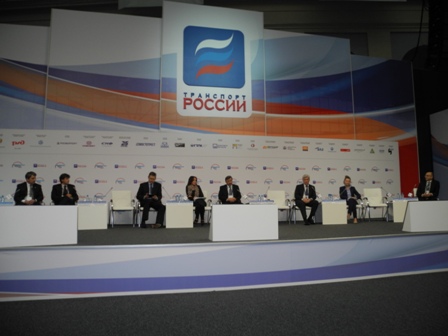
Vom 5. bis 7. Dezember 2013 fand in Moskau die VII. Internationale Fachmesse „Transportwesen Russlands" statt, die mit Unterstützung des Verkehrsministeriums der Russischen Föderation organisiert wurde und an der Transportmittelhersteller, Güter- und Personenbeförderer, Eigentümer und Betreiber der Verkehrsinfrastruktur, regionale Leitungsorgane, Investitionsgesellschaften und Banken, Baubetriebe, Hersteller und Lieferer von Kommunikationsmitteln und -systemen, Sicherheitseinrichtungen und Signalanlagen, Reparatur- und Instandhaltungsbetriebe, Logistikgesellschaften, Versicherungen, Bildungseinrichtungen und Fachmedien teilnahmen. Sergej Iwanow, Leiter der Russischen Präsidialverwaltung hob in seiner Rede auf der feierlichen Eröffnungsveranstaltung hervor, dass das Passagier- und Gütertransportaufkommen in Russland kontinuierlich wächst, was in hohem Maße auf die staatlichen Subventionsprogramme zurückzuführen ist. Während der Fachmesse sowie im Verlauf der Konferenzen und Podiumsgespräche im Rahmen der Transportwoche wurden die gesetzten Ziele - Präsentation von Innovationen im Bereich Verkehr und Infrastrukturprojekte, Förderung der Finanzierung von Projekten des Transportsektors, Förderung der Herstellung und Entwicklung partnerschaftlicher Beziehungen zwischen den Regionen und Branchen sowie Integration des russischen Transportsektors in das internationale Transportsystem - erreicht.
Social Media im Verkehrssektor
Der Ausbau der sozialen Medien, die eine Gesamtheit von Internetressourcen für das Entstehen von Gemeinschaften bilden, deren Mitglieder sich nach den einen oder anderen Kriterien zusammenschließen, liegt derzeit im Trend jeder Tätigkeit im weltweiten Netz. Die auf der Web-Plattform und den mobilen Technologien basierenden sozialen Medien stellen einen vieldeutigen Begriff dar, der sich für die Beschreibung neuer Formen der Kommunikation der Verfasser des Site-Contents mit dessen Nutzern etabliert hat. Maßgeblich für sie ist die Mitwirkung der Nutzer am Inhalt des Endprodukts, wenn jeder Leser/Blog-Abonnent, z. B. die Funktion des Kommentators, Reporters, Fotokorrespondenten und/oder Redakteurs der jeweiligen Leistung übernimmt.
Aufgabe der sozialen Medien ist es, für einen operativen Informationsaustausch auf zwei- oder mehrseitiger Grundlage zu sorgen. Beispiele für soziale Netzwerkinstrumente sind Facebook, Twitter, YouTube, Livejournal, Vkontakte, unterschiedliche Blogs, passwortgeschützte Plattformen mit eingeschränktem Zugang und viele andere. Sie dehnen sich immer mehr auf die unterschiedlichen Bereiche menschlicher Tätigkeit aus, u. a. auch auf den Bahnverkehr.
Gerade aus diesem Grund stieß bei den Spezialisten der Bahn ein Seminar auf großes Interesse, das der Erörterung von Fragen zur Rolle der sozialen Medien im Verkehrssektor gewidmet war (Social Media in public transport: the closest dialogue with our customers?) und vom 6. bis 7. März 2013 in Mechelen (Belgien) stattfand. An dem von der UITP veranstalteten Seminar nahmen Vertreter von PR-Abteilungen, Pressediensten von Verkehrs- und Eisenbahngesellschaften, internationalen Organisationen, sozialen Netzwerken und Medien, darunter auch der Zeitschrift der OSShD, teil, die aus Österreich, Belgien, Großbritannien, Ungarn, Deutschland, Griechenland, Dänemark, Irland, Spanien, Italien, Kanada, den Niederlanden, Norwegen, Portugal, Frankreich, Tschechien, der Schweiz, Schweden und Japan kamen.
Die Schlüsselfrage des Seminars war: Wie können mit maximalem Nutzen für den Verkehrssektor und seine Kunden die Vorteile der elektronischen Massenmedien, der Social Media (SM) und des Social Media Marketing (SMM) im Hinblick auf die von der EU-Kommission gestellten Aufgabe der Verdoppelung des Anteils des öffentlichen Verkehrs sowie des Schienenverkehrs bis 2025 genutzt werden?
Eröffnet wurde das Seminar von Michael Lichtenegger, Vorsitzender der Kommission der UITP „Marketing und Produktentwicklung“, der darauf hinwies, dass in letzter Zeit die Rolle der sozialen Medien im Verkehrssektor in immer schnellerem Maße zunimmt und dabei praktisch all seine Bereiche erfasst werden: Steuerung und Überwachung, Echtzeitinformation für Kunden und Fahrgäste, Verkauf von Dienstleistungen und Fahrkarten, Bedarfsermittlung und Feststellung von Mängeln sowie vieles anderes mehr. All das zielt auf eine Verbesserung des öffentlichen Verkehrs einschließlich des Schienenverkehrs und die Erhöhung seiner Wettbewerbsfähigkeit ab.
In Vorträgen und Präsentationen berichteten die Teilnehmer detailliert über die unterschiedlichen Aspekte im Umgang mit den sozialen Medien im Verkehrssektor. Besonderes Interesse fanden die Beiträge und Rundtischgespräche zu den Themen "Social Media im öffentlichen Verkehr", "Welches Karma haben die Seiten von Travel Facebook?", "Wie können die Social Media das Marketing im öffentlichen Verkehr unterstützen?", in denen die Vertreter der DB AG, der SNCF, der Verkehrs- und Eisenbahngesellschaften Österreichs, Belgiens, Brasiliens, Großbritanniens, Deutschlands, Hollands und der USA ihre Erfahrungen bei der Nutzung elektronischer Systeme im öffentlichen Verkehr ihrer Länder austauschten.
Verwiesen wurde darauf, dass die sozialen Medien eine große Rolle im öffentlichen Verkehr für die Erhöhung der Sicherheit, den Schutz vor Ausnahmesituationen und Störfällen und die Überwindung ihrer Folgen, für die Durchführung von Meinungsumfragen zur Qualitätssteigerung in der Kundenbetreuung, für die Imageverbesserung der Verkehrsgesellschaften und in vielen anderen Bereichen spielt. Neben den verschiedenen hervorzuhebenden Unzulänglichkeiten verfügt diese Art von Massenkommunikation über viele Vorzüge, zu denen insbesondere Schnelligkeit, Interaktivität, Individualität, Einbeziehung breiter Schichten der jugendlichen Bevölkerung und natürlich auch niedrige Kosten gehören.
In diesem Zusammenhang wurde von den Seminarteilnehmern empfohlen, die elektronischen Informationsmittel (Webseiten, Plattformen, elektronische Kundenbetreuungssysteme) in den Organisationen und im Verkehrssektor, darunter auch bei den Bahnen, noch engagierter einzuführen. Ein derartiges System - Twitter - wird bereits bei der UITP genutzt. Zu beachten ist aber auch, dass während wir die Möglichkeiten prüfen und versuchen, die Nutzung der vorhandenen Mittel der sozialen Medien in Gang zu bringen, der Fortschritt weiter zügig voranschreitet und immer wieder neue Möglichkeiten und Instrumentarien auftauchen, die für eine Steigerung der Effizienz und der Wettbewerbsfähigkeit von Waren und Dienstleistungen sorgen.
14. Internationale Buchmesse in Vilnius
Vom 21. bis 24. Februar 2013 fand in Vilnius die 14. Internationale Buchmesse statt. Begrüßt wurden die Gäste von der Präsidentin der Republik Litauen Dalia Grybauskaitė und dem außerordentlichen und bevollmächtigten Botschafter der Russischen Föderation in Litauen Wladimir Wiktorowitsch Tschchikwadse, die in ihren Reden die besondere Bedeutung der russischen Literatur in Litauen hervorhoben.
Die Buchmesse Vilnius ist eines der populärsten Ereignisse im Baltikum, ein traditioneller Treffpunkt von Verlegern, Schriftstellern und Lesern. Ihre Neuerscheinungen präsentierten mehr als 300 Verlage aus elf Ländern, darunter auch die Staatliche haushaltsfinanzierte Bildungseinrichtung der Russischen Föderation Lehr- und Ausbildungszentrum für den Bahnverkehr (FGBOU "UMZ ShDT"), dessen Stand Erzeugnisse zu den Schwerpunkten des Eisenbahnverkehrs präsentierte. Am Stand des FGBOU "UMZ ShDT") waren ebenfalls Druckerzeugnisse der OSShD vertreten, wie die Zeitschrift der OSShD, Informationsbroschüren der OSShD, der Bericht über die Tätigkeit der OSShD.
Im Rahmen der Ausstellung führte der Direktor der FGBOU "UMZ ShDT" unter Mitwirkung des Komitees der OSShD Gespräche mit Leitern von Bildungseinrichtungen aus den baltischen Ländern und Vertretern der Litauischen Eisenbahnen AG.
Seitens der Bildungseinrichtungen nahmen an den Gesprächen teil: der Direktor des Instituts für Eisenbahnverkehr der technischen Universität Riga (Lettland) Мareks Mesitis, der Dekan der Verkehrsfakultät der Technischen Universität Vilnius Vilius Bartulis, der Dekan der Petras-Vileisis-Fakultät für Eisenbahnverkehr am College für Design und Technologie Vilnius Laimute Sladkevičius. Seitens der Litauischen Eisenbahn nahmen teil: der Direktor des Departments für Entwicklung Virginijus Jastremskis, die Leiterin des Personalmanagements Аušrinė Romančikienė, die Leiterin des Zentrums für technische Information und Dokumentation Zita Banevicienė, der Leiter der Abteilung für externe Kommunikation Mindaugas Reinikis.
Auf den Treffen wurden Fragen der Zusammenarbeit zu den Aktivitäten der FGBOU "UMZ ShDT" erörtert. Die Spezialisten des Verkehrskomplexes der baltischen Länder zeigten großes Interesse insbesondere an Druckerzeugnissen und anderen Produkten zur Eisenbahnthematik wie Bücher, Bildbände, Videos, Plakate, auch in elektronischer Form, sowie der Bildung von internationalen Autorenteams zur gemeinsamen Herausgabe von Wörterbüchern mit der Terminologie des Verkehrswesens. Besondere Aufmerksamkeit widmeten die Leiter der Bildungseinrichtungen aus den baltischen Ländern der Teilnahme am 2. Internationalen Wettbewerb von Lehrbüchern für Verkehrshochschulen Universitätsbuch 2013.
